ACT Policing: Annual Report 2019-20
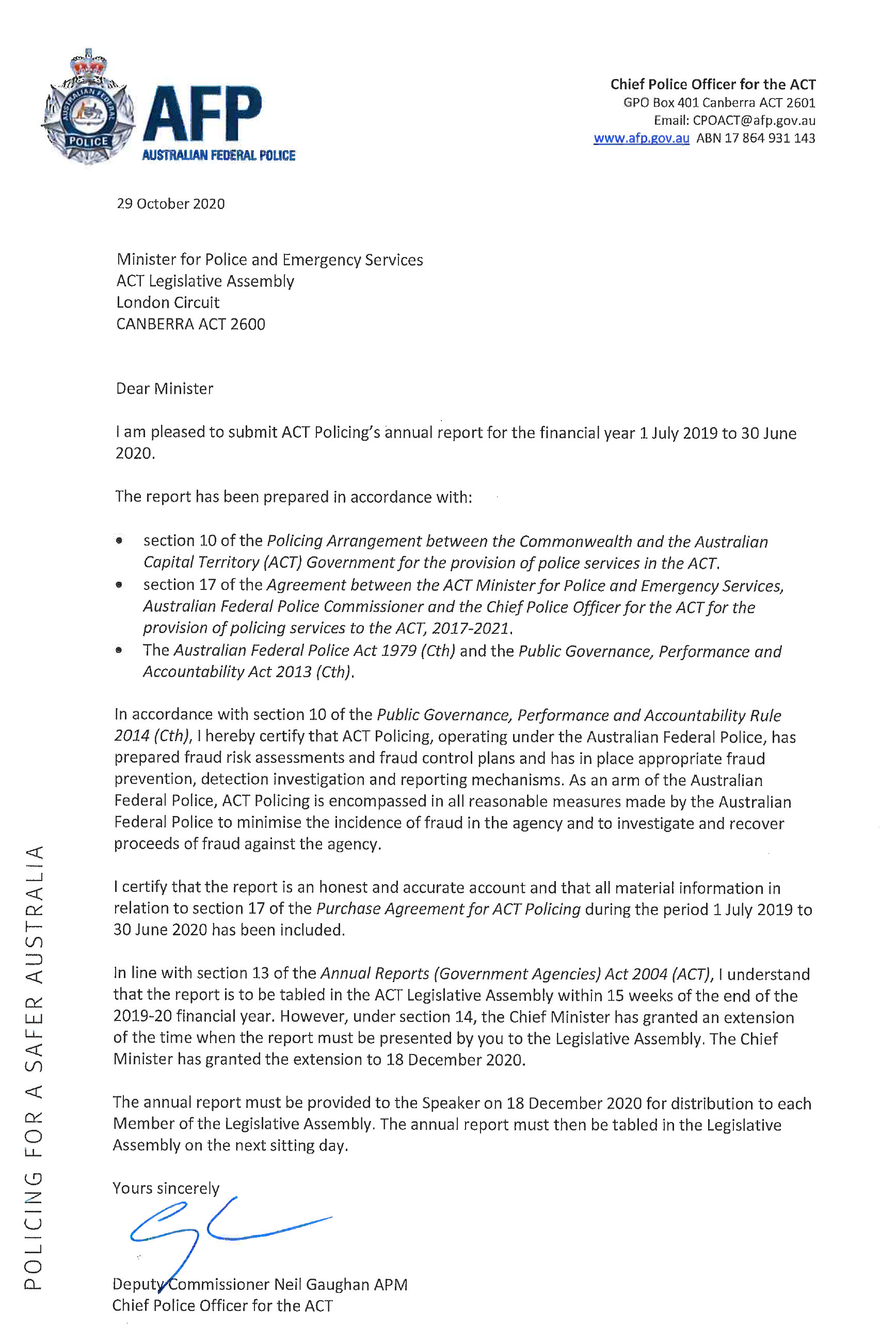
Contents
- Chief Police Officer’s Foreword
- Ministerial Direction
- ACT Policing at a glance
- Performance analysis
- Professional standards
- Use of force
- Staffing profile
- Financials
- Appendices
- Appendix 1: Financial Statements
- Appendix 2: Statement of Performance
- Appendix 3: Number of Offences Reported or Becoming Known in Australian Capital Territory 2014–15 to 2018–19
- Appendix 4: Offences Cleared by ACT Policing in the Australian Capital Territory 2014–15 to 2018–19
- Appendix 5: Percentage of Offences Cleared by ACT Policing 2014–15 to 2018–19
- Appendix 6: Proceedings Against Offenders by ACT Policing (Charges) 2014–15 to 2018–19

Artist: Anthony Bean
The Connection of the circles represents collaboration and the coming together of ideas.
The Australian Federal Police acknowledges the traditional owners and custodians of country throughout Australia and acknowledges their continuing connection to land, sea and community. We pay our respects to the people, the cultures and the elders past, present and emerging.
Chief Police Officer’s Foreword

Chief Police Officer for the ACT
Neil Gaughan APM
It is a privilege to present ACT Policing’s Annual Report for 2019–20 following my appointment as the Chief Police Officer in May 2020. I commenced my policing career in ACT Policing more than 30 years ago and I am immensely proud to be leading a team of highly professional members who are deeply committed to the safety and protection of the Canberra community.
ACT Policing received an investment of $33.9 million from the ACT Government (over four years) in support of our transition to a new Police Services Model (PSM). Funding for this transition commenced in 2019–20 and has resulted in the recruitment and concept development of the Operationalised Intelligence and community focused proactive teams.
The PSM comprises targeted investments in technology, equipment and resources to deliver a more visible, proactive and connected police service. The PSM is aimed at moving from a response focus to a community focused model that is more mobile and agile. It is a long-term strategic investment that will benefit both ACT Policing and our community.
Operationalised intelligence will enable ACT Policing to better understand crime occurring in Canberra and proactively use appropriate resources in a targeted way. Our focus will also be on implementing strategies in a collaborative effort across the ACT Government in support of the most vulnerable people in our community. We will continue to work with partner agencies to address the complex social issues that contribute to criminal activity.
The introduction of a tri-service response team, known as PACER (Police, Ambulance and Clinician Early Response), is an example of how partnerships can achieve great results for the community. The PACER proof of concept between ACT Policing, ACT Ambulance Service and ACT Health was launched in December 2019 to address mental health crisis incidents. Since its commencement, 80 per cent of patients serviced by the PACER team have been diverted from hospital. The PACER team works together to intervene and de-escalate incidents, diverting people from emergency apprehension. This ultimately benefits the community, the individual suffering the mental health crisis incident and takes the pressure off the frontline and hospital system.
2019–20 has been an extraordinary year resulting in a very challenging and dynamic environment, with ACT Policing achieving 15 of the 21 Performance Measures and 9 of 17 Indicators of Effectiveness. When I reflect on the activities ACT Policing has undertaken the list of achievements is highly commendable and spans crime reduction, public safety and community engagement. Specifically, I would like to highlight the following operations that have helped ACT Policing contribute to a safer Canberra community:
- In mid-2019 ACT Policing seized 384 kilograms of cocaine, valued at $144 million. Led by ACT Policing, and supported by the Australian Border Force, Australian Federal Police (AFP) National Anti-Gangs Squad, and NSW Police Force, this investigation not only stopped the supply of drugs reaching the community, but dismantled a major transnational organised crime syndicate operating in the region.
- During January 2020, the ACT Community faced natural disasters on a scale not witnessed for some time. The catastrophic bushfires on the NSW South Coast over the new year period were the start of an intensely busy planning and response time for ACT Policing and in particular the ACT Policing Emergency Management and Operations teams. In partnership with the ACT Emergency Services Agency (ESA), the State Emergency Services (SES) and Australian Defence Force (ADF), ACT Policing assisted in protecting and supporting the ACT community when the Beard and Orroral Valley fires posed a significant threat to the ACT and surrounding regional communities.
ACT Policing embedded officers in the Emergency Command Centre and undertook a range of activities within the community including conducting over 8,000 door knocks, building evacuations, and road closures. Members from across ACT Policing and the AFP worked tirelessly, reaching out to vulnerable members in the community whilst working in extreme and hazardous conditions. In some circumstances members supported the ACT community whilst their own properties were under threat.
During this time, an intense hail storm hit Canberra and left a trail of destruction that resulted in major damage, localised flooding, and power outages to many homes and businesses. ACT Policing was also impacted by the hail with major damage to Winchester Police Centre, the Traffic Operations Centre and half of its fleet of police vehicles.
All members from ACT Policing and the AFP who provided support during these challenging times demonstrated not only their commitment to their jobs but their compassion and professionalism when helping the community.
- Along with the rest of the country, in March 2020, ACT Policing’s focus shifted to the COVID-19 pandemic. Our taskforce joined the ACT Whole-of- Government response, and will continue to work closely with ACT Health and partner agencies in regards to the ACT Health Directions and ACT’s response to COVID-19. I am pleased to report that all members of ACT Policing on the frontline who engage daily within the community have done so safely through adaptable work practices and additional work, health and safety measures. The Canberra community has followed the health directions and no infringement notices were issued for non- compliance with health directions as at 30 June 2020.
I recognise that the economic impact of COVID-19 on the community will not be comprehensively understood for some time, and the resilience of the ACT community will be tested in the years ahead. ACT Policing will continue to support the Canberra community through these challenging times and I thank my members for their commitment and dedication.
Ministerial Direction
Minister for Police and Emergency Services Ministerial Direction
This Direction is issued under section 7 of the Policing Arrangement between the Commonwealth and Australian Capital Territory (ACT) Governments and outlines the Government’s priorities and expectations for the Australian Federal Police (AFP) and more specifically the Chief Police Officer (CPO) for the ACT. This Direction is to be read in conjunction with the 2017–2021 Purchase Agreement between the ACT Minister for Police and Emergency Services, the AFP Commissioner and the CPO. It supersedes and revokes the Direction issued on 10 July 2017.
My primary expectation is that ACT Policing will continue to provide a professional, effective and efficient policing service to the ACT community. This should be achieved through evidence-based and innovative strategies to meet the outcomes of the 2017–2021 Purchase Agreement to reduce crime, increase public safety and engage with community and partners locally and nationally.
Through collaborative work with the Government and other stakeholders, I expect ACT Policing to play a key role in implementing ACT Government initiatives that improve community safety; reduce harm and trauma; and help prevent, divert and improve outcomes for those in contact with the justice system. This includes being transparent and responsive, as well as working with partner agencies on holistic approaches to complex social issues and providing policing and law enforcement advice to inform Government decision making.
Special Areas of Focus
In this context, the ACT Government expects ACT Policing will give special focus to the following priorities:
- Transitioning to a new policing service model that sees ACT Policing evolving in line with population growth and community expectations by providing a proactive, community focused policing service, centred on the disruption and prevention of crime.
- In support of Government’s overall efforts to reduce recidivism by 25 percent by 2025, increase early intervention and diversion strategies and continue to work with the Aboriginal and Torres Strait Islander community to identify ways to reduce the over-representation of Aboriginal and Torres Strait Islander people in the criminal justice system.
- Contribute to Canberra as a restorative city and continue to improve responses to vulnerable groups including Aboriginal and Torres Strait Islander people, young people, people experiencing mental health issues, people with a disability, culturally and linguistically diverse people and victims of crime.
- Strengthening the ACT’s response to domestic and family violence in appropriate and culturally sensitive ways and supporting the efforts of the Coordinator-General for Family Safety.
- Working proactively and innovatively with Government to reduce and prevent alcohol-fuelled violence, including enforcing liquor laws, maintaining a presence in night entertainment precincts and responding to alcohol related violent incidents.
- Improving road safety, with emphasis on reducing road trauma experienced by vulnerable road users and combating anti-social and dangerous behaviours including speeding, driving while impaired or distracted.
- Disrupting serious and organised crime, including criminal gangs, drug trafficking and supply; and economic disruption to target the proceeds of crime, in addition to working with the Government to identify and implement legislative measures to target serious and organised crime.
- Drug harm minimisation by continuing to focus on diverting lower level drug offenders from the criminal justice process in accordance with the National Drug Strategy and the Government’s policy settings such as the ACT Drug Strategy Action Plan.
- Countering the threat of terrorism and violent extremism by continuing to strengthen the safety of the ACT’s public places in line with national strategies and best practice; and developing a fixated threat capability to meet the Government’s obligations under the October 2017 Council of Australian Governments agreement.
I encourage ACT Policing to maintain a diverse and inclusive workforce that is committed to the wellbeing and health of its people so that it can continue to deliver a professional, innovative and effective policing service in a dynamic environment for the ACT community. This will include enhanced digital engagement to ensure ACT Policing continues to evolve in line with community expectations. In support of this, I will continue to work with ACT Policing, the Justice and Community Safety Directorate and the community to support a smooth transition to a new policing service model that will see more police working in a more connected and effective way to disrupt and prevent crime.
Mick Gentleman, MLA
Minister for Police and Emergency Services
28 October 2019
ACT Policing at a glance
- Our Role
- Our Mission
- Our Governance
- Our Intent
- Our Values
- Our Budget
- Our Approach
- Our Performance
- Our Challenges
- Our People
- Our Future
Our Role
Through a Purchase Agreement with the Australian Capital Territory (ACT) Government, the Australian Federal Police (AFP), through ACT Policing, is responsible for providing quality and effective policing services to the people of the ACT. We do this in partnership with the community and the ACT Government.
Our Mission
Our mission is to keep the peace and preserve public safety within the ACT.
Our Governance
The key documents which govern the delivery of policing services to the ACT are the Policing Arrangement, Purchase Agreement and Ministerial Direction.
Policing Arrangement
The AFP is a statutory authority established by the Federal Parliament under the Australian Federal Police Act 1979. The AFP delivers policing services to the ACT as a separate outcome under a contractual arrangement between the Commonwealth and ACT Governments.
Purchase Agreement
The Policing Arrangement provides for the negotiation of a Purchase Agreement between the AFP and the ACT Government. The Agreement details the outputs, performance measures, targets, facilities and outcomes to be provided, as well as the powers and obligations of the Minister for Police and Emergency Services, and the Chief Police Officer of the ACT, along with associated administrative arrangements.
Our Intent
We strive to deliver a professional, innovative and effective policing service in an ever-changing environment for the ACT community.
Our Values
We pride ourselves on being a values-driven organisation. Our core values of integrity, commitment, excellence, accountability, fairness, respect and trust represent our principles and standards — the values we uphold in performing our professional duties.
The Purchase Agreement defines the three main outcomes against which ACT Policing’s performance is measured:
- Reduce Crime
- Public Safety
- Community and Partner Engagement.
Ministerial Direction
The Ministerial Direction outlines the ACT Government’s priorities for, and expectations of, the Australian Federal Police and the Chief Police Officer of the ACT (see Chapter 2: Ministerial Direction).
Further details of the Policing Arrangement, the Purchase Agreement and the Ministerial Direction are available via ACT Policing’s website at: police.act.gov.au/about-us/government-directions
Our Budget
Under the Purchase Agreement, the funding provided by the ACT Government to the AFP for delivery of policing services in 2019–20 was $170.195 million.
The total price includes enabling costs and direct funding from the Justice and Community Safety Directorate (JaCS) for crime prevention initiatives (see Chapter 8: Financial Management Reporting).
Our Approach
Our approach is underpinned by a series of strategies and initiatives that support the outcomes set out in the Performance Measure Framework:
Reduce Crime
- Continued support against the ACT Property Crime Prevention Strategy 2016–2020, by promoting innovative and enduring crime prevention strategies, and reducing the opportunities for crime to occur or recur.
- Enhancing our response to, and the investigation of, offences by forging strong relationships with stakeholders to facilitate Whole-of-Government and cross-jurisdictional information sharing and collaboration.
- Applying technology and forensic science capabilities and effectively using intelligence from a wide range of sources.
- Providing effective and efficient support to the judicial process by maintaining a robust partnership with the ACT Director of Public Prosecutions and delivering high standard briefs in a timely manner.
- Facilitating a more efficient criminal justice system with emphasis on timely preventive justice measures and judicial processes.
Public Safety
- Responding in accordance with community expectations, ensuring resources meet demands and enhancing police responsiveness through mobility solutions.
- Effectively planning and managing major events and public demonstrations by reviewing and improving existing arrangements, working with the community and relevant agencies, and conducting post-operational assessments for continuous improvement and better practice.
- Working with partners to develop and maintain preparedness in response to emergencies and disasters.
- Improving and promoting road safety through education, innovation and targeted enforcement by working with partner agencies, supporting the ACT Road Safety Strategy and Action Plan and maintaining targets to align with the ACT Road Safety Calendar.
Community and Partner Engagement
- Increasing community trust and confidence in police by communicating in innovative ways with the community, maintaining a social media presence and collaborating with partner agencies, business and community groups to support community events.
- Increasing support for early intervention and diversion by working with partner agencies and community groups to prevent and reduce recidivism.
- Continuing support and delivery of the ACT Aboriginal and Torres Strait Islander Agreement 2019–2028 to prevent and reduce the number of Aboriginal and Torres Strait Islander people coming into contact with the criminal justice system.
- Supporting the National Plan to Reduce Violence against Women and their Children 2010–2022 and further initiatives that deter, detect and prevent violence against women and children.
- Enhancing and strengthening the resilience of communities through safety and security initiatives and building relationships with vulnerable community groups.
Our Performance
ACT Policing’s performance is measured by the Performance Measure Framework, which incorporates three major outcomes and a series of strategies, initiatives and targets, as articulated in the 2017–21 Purchase Agreement.
The overarching budgetary outcome of the Purchase Agreement is to work in partnership with the community to create a safer and more secure ACT through the provision of quality policing services. The Performance Measure Framework aims to enhance accountability for the delivery of services, and provide clear links between ACT Policing’s outcomes, outputs, strategies and individual measures.
ACT Policing’s three outcomes (Reduce Crime, Public Safety, Community and Partner Engagement) are supported by 21 Performance Measures and 17 Indicators of Effectiveness.
Additional information and results on Performance Measures and the Indicators of Effectiveness (IoE) are further described in Chapter 4: Performance Analysis.
Our Challenges
Major challenges and demands presented to ACT Policing during 2019–20 included:
- Challenging bushfire season — Increased planning and response to assist partner agencies and the community in managing the bushfire threat to the ACT.
- Evolving COVID-19 environment — Continually adapting to the changing role police play in supporting the community to ensure their safety during the COVID-19 pandemic.
- Crime and recidivism — The targeting of recidivism through early intervention and community engagement in an overall approach to reduce crime in the ACT.
- Family violence — Taking a collaborative approach with the ACT Government and our partner agencies to combat family violence and strengthen the support services available to victims.
- Serious and organised crime — The prevention and disruption of serious and organised crime through targeting, disrupting and apprehending members of criminal gangs, and seizing wealth derived from criminal activity.
- Reducing the over-representation of Aboriginal and Torres Strait Islander peoples in the justice system — Ongoing engagement with the local Aboriginal and Torres Strait Islander community to further develop solid, trusting relationships through open dialogue, and enhancing our understanding of the challenges faced by Aboriginal and Torres Strait Islander peoples.
- Ensuring safety of ACT Policing members — Increasing the protection for ACT Policing members who are regularly exposed to the risk of assault and injury while on duty.
- Increased demand — In the last five years there has been a more than 30 per cent increase in critical and time-sensitive calls requiring urgent police attendance, increasing the demand on policing services.
- Mental health and wellbeing of our members — Increasing access to support services to ensure the health and wellbeing of members across ACT Policing.
- Preparing ACT Policing for the future — In order to address the needs of the growing ACT community, we are transitioning to a more community-focused model of police service, to meet the current and long-term needs of the ACT community.
Our People
The Chief Police Officer (CPO) is accountable to the ACT Minister for Police and Emergency Services for the achievements and outcomes set out in the Purchase Agreement and Ministerial Direction.
The CPO is also responsible for the management of personnel and resources used to deliver policing services to the ACT community. The CPO is supported by three functional streams: Capability and Community Safety, Response, and Corporate Services.
Information about ACT Policing personnel can be found at Chapter 7: Staffing Profile.
FIGURE 3.1: ACT POLICING ORGANISATIONAL STRUCTURE AS AT 30 JUNE 2020
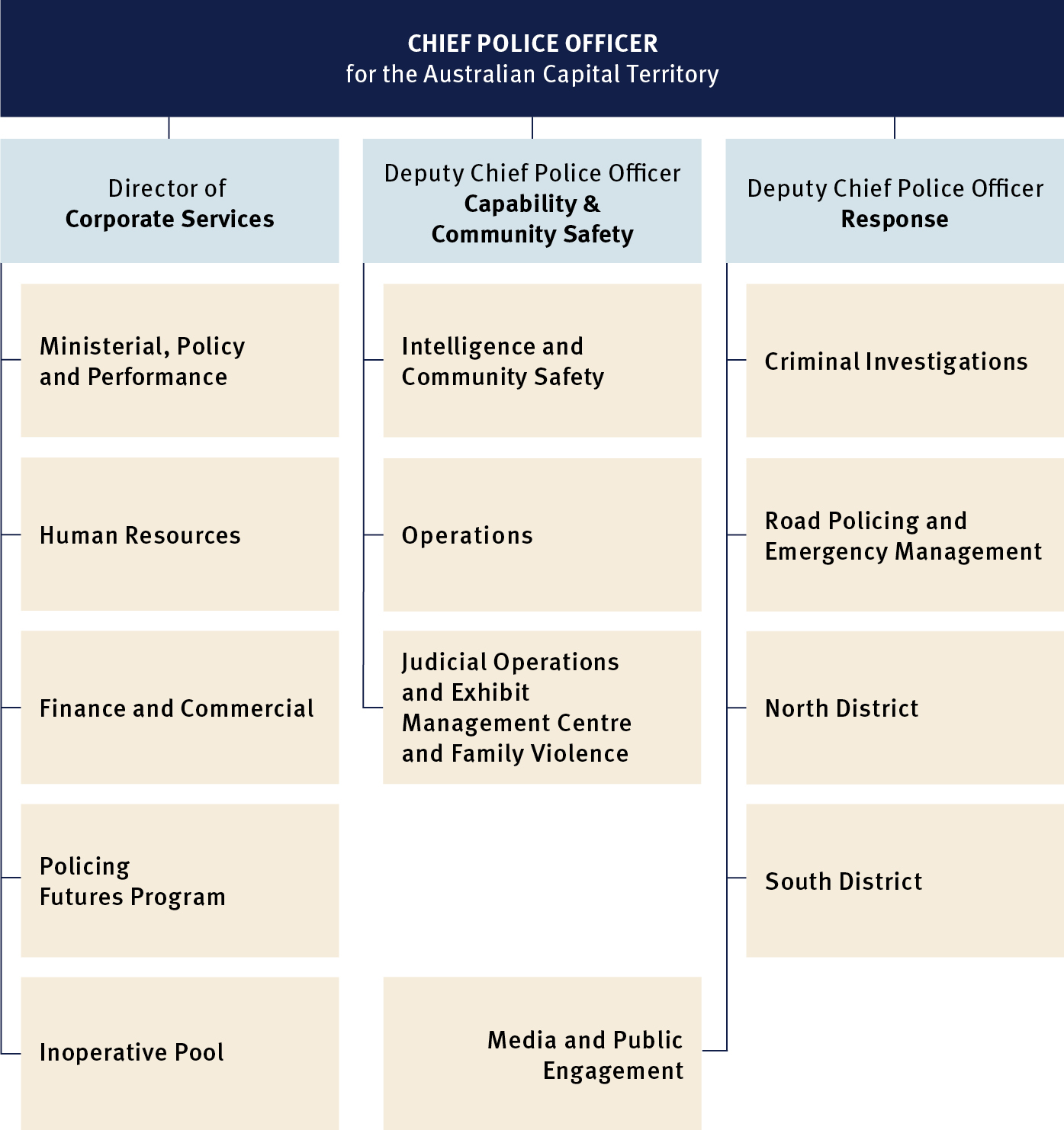
FIGURE 3.2: ACT POLICING PATROL ZONES AS AT 30 JUNE 2020
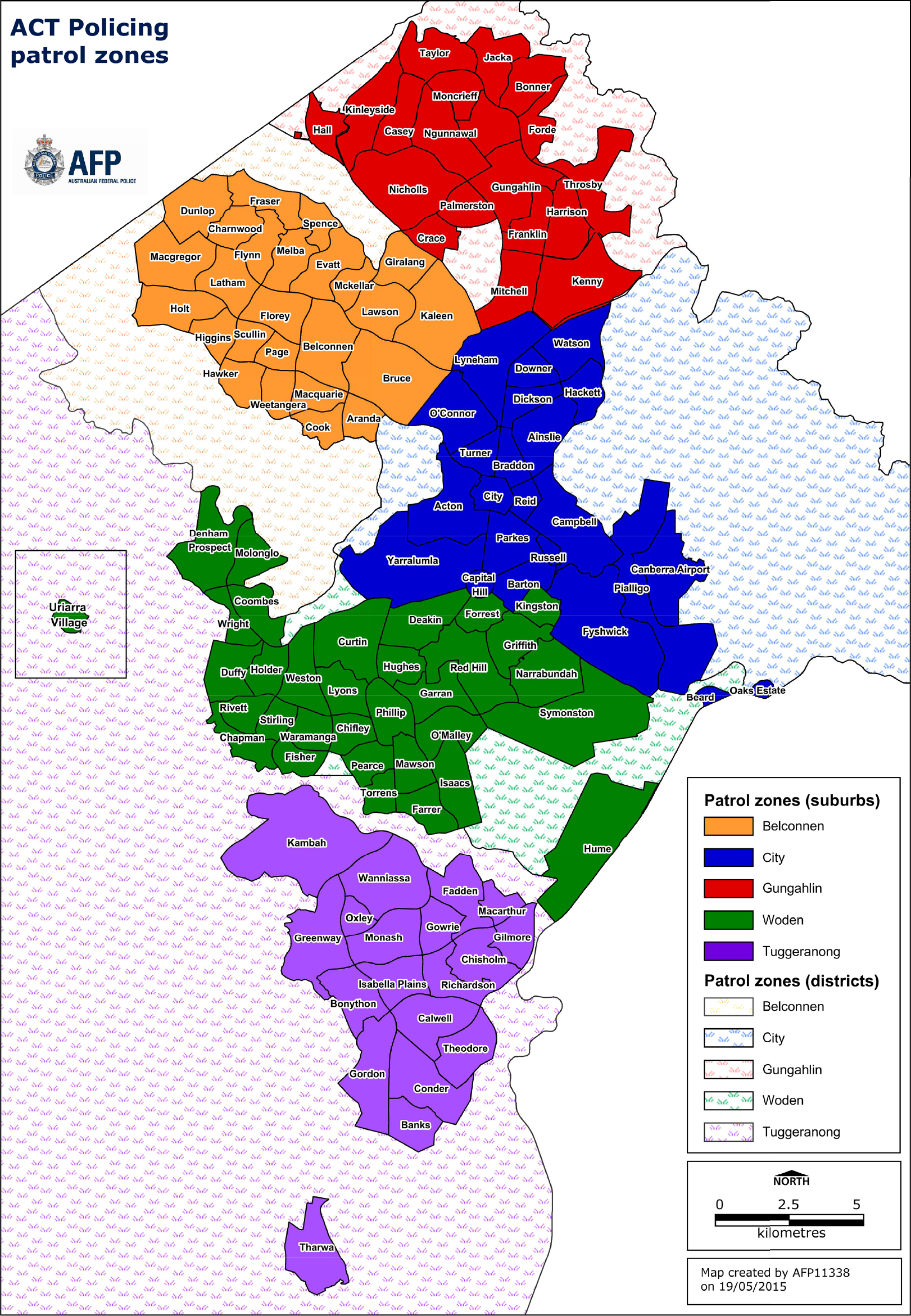
Our Future
ACT Policing is working to evolve with our community to create an even safer Canberra.
The ACT Policing Futures Program was established in 2017 with a vision to deliver a more sustainable, efficient and effective policing service to meet the current and long-term needs of the ACT community.
The Police Services Model (PSM) was funded with a $33.9m investment by the ACT Government over four years with the 2019–20 financial year being year one. The model enables ACT Policing to direct resources where they are most effective, conduct focused crime prevention activities and contribute to a more effective justice system that is focused on addressing the root causes of crime.
To date, 32 projects have been identified under the four pillars of the PSM, to be rolled out over the next four years through. These are:
- Systematic Approach — Collaborate with government agencies to share information and identify intervention opportunities. Establish more effective processes to encourage greater collaboration with other agencies.
- Intelligence Led — Using intelligence to inform systematic decision making at both the tactical and strategic levels. Provide members access to the right information to most effectively address and prevent crime.
- Evidence-Based — Generate and use data, research and evidence to inform and challenge policing practices and decisions. Provide the right training and technology to inform evidence-based policing practices and decision making.
- Mobility Driven — Increasing responsiveness and efficiency through technology, governance and processes. Better systems will ensure members can spend more time in the field, while demand rostering will allow effort to be directed to where it is most needed.
Some of the projects commenced during the 2019–20 financial year under the Futures Program include:
- The recruitment, training and trial for the Operational Intelligence team to deliver real-time intelligence products to frontline members, providing improved situational awareness and tactical assistance.
- The recruitment and governance for the first of four Proactive Policing teams to undertake community-centric engagement, crime diversion and engagement with community-sector partners.
- Scoping and early development for a new Online Crime Reporting Tool to allow the ACT community to report non-urgent crimes directly to ACT Policing online, instead of calling 131 444.
Case study
ACT Policing Futures Program – Body worn cameras delivering benefits for ACT Policing
Thanks to an investment from the ACT Government of $2.695m over four years, ACT Policing frontline members have been provided with body worn cameras. This new capability is having positive impacts on the work we do and the day-to-day experiences of our members.
The cameras help to create an objective record of events, notable incidents and interactions our members have with the community. The technology has had a noted effect on reducing behavioural escalations when speaking with possible offenders who know they are being recorded.
Body worn cameras support and provide assurance for the critical decision making of members on the road. AFP Professional Standards has seen a considerable reduction in the time it has taken to assess excessive use of force complaints from the public.
AFP Professional Standards has attributed this improvement in assessment and investigation times to the factual evidence provided by body worn camera footage. This reduction in time also ensures we are not subjecting members to drawn-out investigation processes and reduces the impact this can have on members.
Body worn cameras are also critical investigation tools to assist with obtaining evidence while reducing the impact on resources, and creating efficiencies for the court process.
In 2019–20 the ACT Policing Sexual Assault and Child Abuse Team attended an incident in response to an alleged sexual assault. During the course of the initial investigation members obtained information that led to the discovery of a possible crime scene in nearby parkland. Immediate preservation of potential evidence and identifying the potential size of the crime scene were critical. During the initial patrol response, members were able to use the body worn camera application to conduct a video walk-through of the area and crime scene. Captured metadata, including the GPS coordinates for the crime scene, was then immediately remotely shared with other investigating officers who were working off-site with the victim without them needing access to the crime scene.
Case Study
Mobile Responder
Technology plays an important role in policing. ACT Policing utilises advances in tools and technology to drive continuous improvement, allowing for innovative policing approaches.
Mobile Responder is an app on AFP issued mobile phones that provides operational members real-time access to details of incidents and deployed resources while in the field.
ACT Policing members commenced using Mobile Responder in March 2019 with the majority of members trained and currently utilising the application.
Within the 2019–20 financial year, Mobile Responder reduced approximately 1.53 million routine radio transmissions to ACT Policing Operations, leaving the radio channels clear for more urgent incidents.
ACT Policing has seen multiple benefits with the use of Mobile Responder. For instance:
- A reduction in radio traffic.
- Multiple members in the field are able to communicate with ACT Policing Operations at the same time, increasing situational awareness.
- Real-time information can be viewed by all members as it becomes available.
- Officer safety has been improved through unit location mapping.
There was an incident where an ACT Policing member followed a motorcycle into an isolated location. The rider fell off the motorcycle and when the member arrived at the scene, the person was recognised to be a known violent and dangerous offender who was under the influence of illicit substances.
The member advised ACT Policing Operations of the situation and stressed that his exact location was unknown. Due to Mobile Responder’s GPS connectivity, ACT Policing Operations were able to pinpoint the member’s exact location within seconds, and send additional patrols to assist.
Performance analysis
2019–20
COMMUNITY POLICING
- 4336 arrests made
- 2811 family violence incidents attended
- 2000 summons
- 837 intoxicated persons lodged in custody
- 406 cautions issued
INTERVENTION
- 6090 referrals to community support agencies
- 1455 drug seizures
- 166 people diverted into Early Intervention and Drug Diversion Program
- 124 number of diversionary conferences
ORDERS AND BRIEFS
- 1247 Family Violence Orders
- 953 Personal Protection Orders
- 1131 hearing briefs delivered to DPP
MEDIA
- 892 media enquiry responses provided
- 490 media releases issued
ACT POLICING WEBSITE
- 443K unique page views for police.act.gov.au
- 1.4M unique page views for policenews.act.gov.au
- 2659 Media subscribers
- 1026 News subscribers
- 1135 Community blog subscribers
SOCIAL MEDIA
- 129,476 followers on Facebook
- 66,083 followers on all Twitter channels (ACT Policing, CKK, CPO ACT, ACT_Pol Traffic)
- 12,710 Instagram followers
- 47.7M impressions on Facebook
- 8.9M impressions on all Twitter channels
Note: Impressions are the number of times a post from a page is displayed, no matter if it was clicked on/engaged with or not. For example, if someone sees a page update in their Facebook newsfeed and then sees that same update when a friend shares it that would count as two impressions..
CONSTABLE KENNY KOALA PROGRAM
- 946 classrooms visited
- 19,618 students visited
- 19 community events attended
- 312,214 impressions on Constable Kenny Twitter
ACT Policing, in partnership with the ACT Government and the community, aims to create a safer and more secure ACT through the provision of a quality community policing service.
The Purchase Agreement outlines 21 Performance Measures under three main outcomes, against which ACT Policing’s performance is measured.
| Outcome | Outputs |
|---|---|
| Reduce Crime | Crime Prevention and Reduction |
| Criminal Investigations and Prosecutions | |
| Public Safety | Police Response |
| Public Order and Emergency Management | |
| Road Safety and Traffic Management | |
| Community and Partner Engagement | Community Support and Whole of Government Collaboration |
The Purchase Agreement also outlines 17 Indicators of Effectiveness (IoE) that measure public perceptions of crime, public confidence in police, road safety, and crime prevention through the National Survey of Community Satisfaction with Policing.
A full summary of all offences reported and cleared by ACT Policing, in addition to the number of proceedings against offenders by ACT Policing, can be found in Appendices 3 to 6.
Performance Measures
ACT Policing achieved or exceeded 15* of the 21 Performance Measures, and 9 of the 17 IoE as outlined in the Purchase Agreement.
*Performance measure 11a) and b) Percentage of Triple (000) calls answered on first or second presentation is unable to be measured and has been counted amongst those not achieved.
Indicators of Effectiveness
The IoE framework was introduced in the 2014–15 Purchase Agreement to separate the indicators contained within the framework from the Performance Measure framework. This recognises that the performance outcomes for these indicators are not fully within ACT Policing’s control. There are a number of public and private institutions and individuals who contribute to the overall results and standings in these indicators.
The National Survey of Community Satisfaction with Policing (NSCSP) is a telephone survey (landline and mobile telephone numbers) which measures community perceptions of a range of policing-related issues. These issues include satisfaction with policing services, feelings of safety, concern about potential victimisation and beliefs about police behaviour. During 2019–20, 2400 ACT residents participated in the survey, with 27,919 participating nationally. This survey relates to 17 IoE and two Performance Measures.
The survey monitors community concern about becoming a victim of certain crime types. While the series of questions can elicit a variety of interpretations, they are the best indicators available for fear of crime.
It is important to note that while we aim to reduce the level of fear of crime in the community, there are some positive aspects to the community having awareness of crime in their neighbourhood. A level of awareness can contribute to crime prevention behaviours and potentially lower the chances of victimisation.
ACT Policing undertakes education and prevention strategies. We work with partner organisations to educate members of the community on personal and property safety, and measures that can be put in place to mitigate the risk of becoming a victim of crime. This, in turn, provides reassurance and reduces the level of fear in the community.
The NSCSP results relevant to the IoE for 2019–20 can be found in Appendix 2.
The following data provides an overview of each performance measure against the 2019–20 target, the achieved result, and the reason for variation, if any.
Data for the selected performance measures and comparison tables was extracted from ACT Policing’s case management system (PROMIS) on 2 July 2019. It is important to note that ACT Policing’s database is live and crime data is continually revised, therefore crime statistics may differ depending on the date of extraction.
Outcome: Reduce Crime
Crime Prevention and Reduction
Performance Measure 1 — Number of offences against the person reported or becoming known per 100,000 population.
The COVID-19 pandemic has deeply impacted the ACT community. Local services have faced unprecedented challenges and demands, which have been coupled with increased financial insecurity and stress for a large proportion of Canberrans. At the same time community movement has been curtailed dramatically by changing social norms, lockdowns and restrictions. Collectively, these conditions influence behaviours in the community, and may create an environment where the types of criminal offending change in response. As the impacts of the COVID-19 pandemic were not felt until late in the 2019–20 financial year, the extent of these events on crime rates will not be quantifiable or fully understood until the years to come.
Offences against the person include but are not limited to, homicide and related offences, sexual assault offences, assault offences and other offences against the person (other offences against the person include kidnapping and abduction, threatening behaviour and other dangerous and negligent acts).
The target for this measure was 800 or less offences against the person reported or becoming known per 100,000 population. ACT Policing did not meet the target for this measure, recording a result of 826 offences per 100,000 population, which was over the target by 3.2 per cent.
FIGURE 4.1: OFFENCES REPORTED AGAINST THE PERSON 2010–11 TO 2019–20
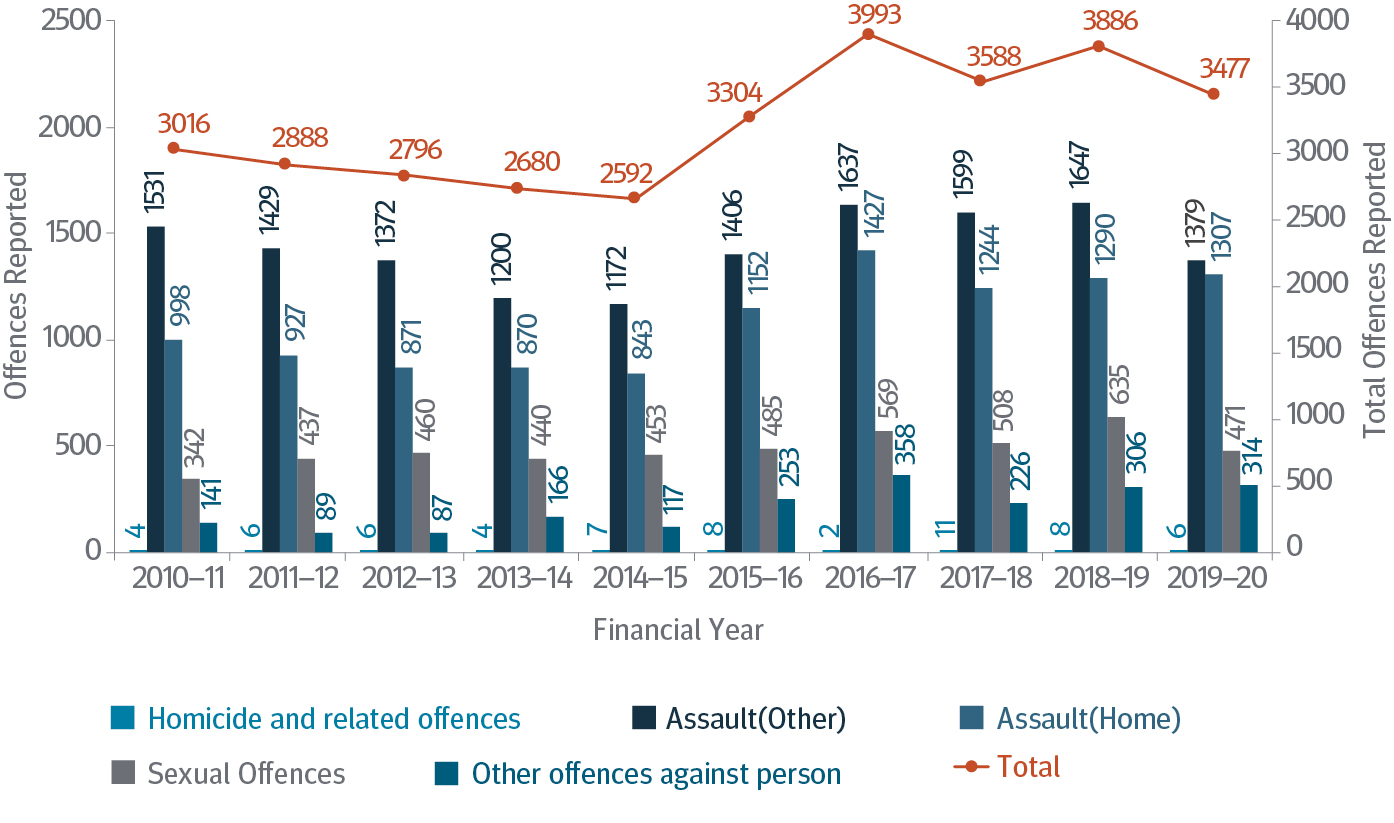
Source: PROMIS as at 2 July 2020
During 2019–20 there were 3477 offences against the person reported to ACT Policing. This represents a decrease of 10.5 per cent (or 409 offences) compared to 2018–19.
TABLE 4.1: OFFENCES AGAINST THE PERSON BY OFFENCE TYPE – FINANCIAL YEAR COMPARISON
| Offences type | 2018–19 | 2019–20 | Change |
|---|---|---|---|
| Homicide and related offences | 8 | 6 | -25.0% |
| Assault (Other) | 1647 | 1379 | -16.3% |
| Assault (Home) | 1290 | 1307 | 1.3% |
| Sexual Offences | 635 | 471 | -25.8% |
| Assault | 2937 | 2686 | -8.5% |
| Other offences against person* | 306 | 314 | 2.6% |
| Total | 3886 | 3477 | -10.5% |
Source: PROMIS as at 2 July 2020
*Other offences against the person include kidnapping and abduction, threatening behaviour and other dangerous and negligent acts.
During 2019–20, overall assault offences decreased by 8.5 per cent when compared to 2018–19.
43.8 per cent of all assaults reported to ACT Policing were family violence related, as demonstrated in Figure 4.2.
FIGURE 4.2: PROPORTION OF FAMILY VIOLENCE RELATED ASSAULTS 2010–11 TO 2019–20
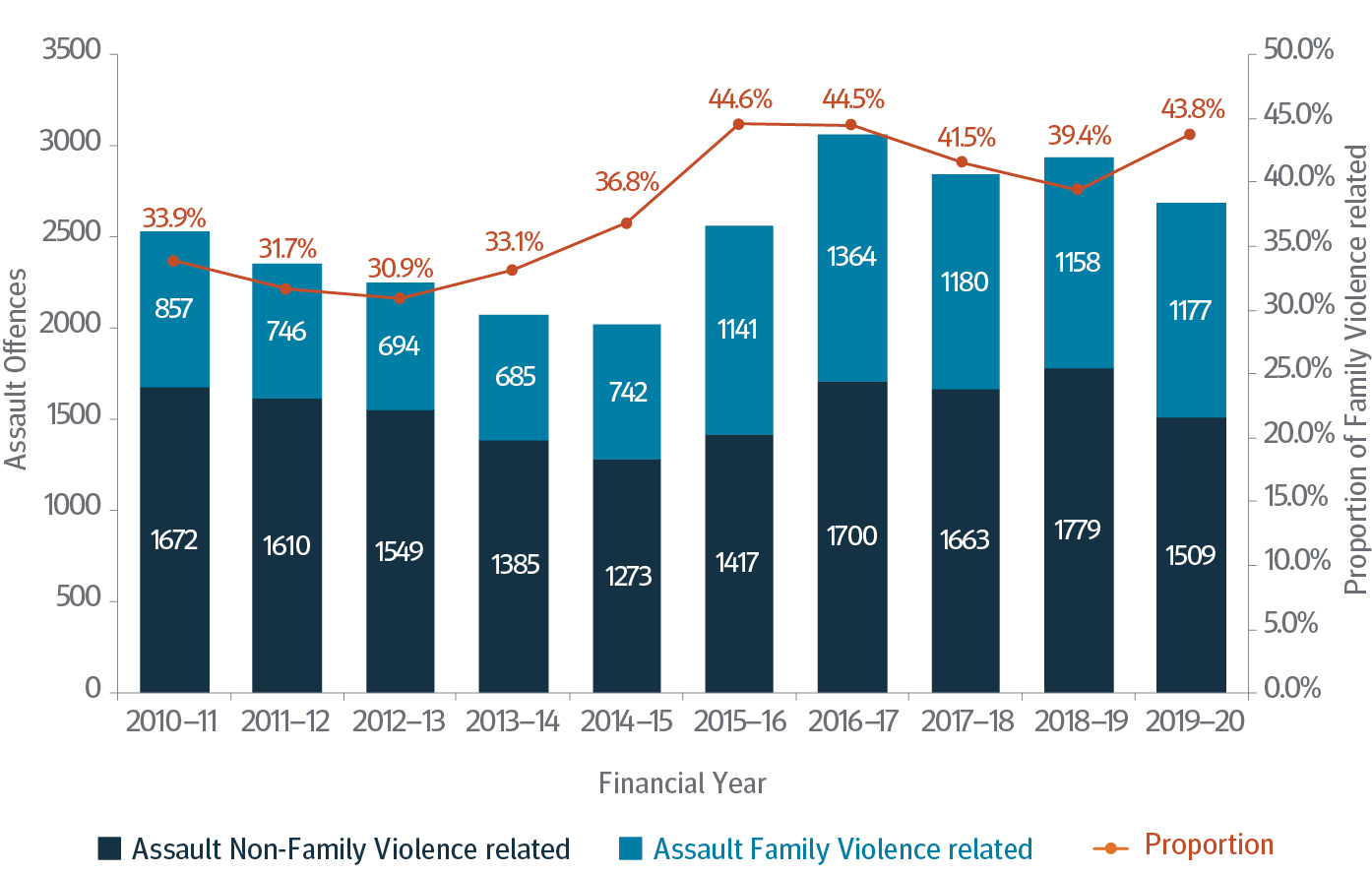
Source: PROMIS as at 2 July 2020
Family violence related assaults have increased by 1.6 per cent over the past 12 months. Long term trends over 10 years show an increase of 37.3 per cent. Traditionally, incidents of family violence are under reported. The increase of 37.3 per cent may demonstrate a cultural shift in willingness to report.
ACT Policing has maintained a strong focus on improving approaches to family violence. For example, during 2019–20 a comprehensive review of the Family Violence Risk Assessment Tool (FVRAT) was undertaken by the Australian Institute of Criminology and a new FVRAT was developed. This improved FVRAT has since been approved and has been operational within ACT Policing since December 2019.
ACT Policing members who work in the Family Violence Unit (FVU) attend regular meetings and engagement programs with stakeholders in all jurisdictions. These engagement programs enable members from the FVU to liaise with external agencies and police services to improve knowledge and methods used to combat family violence in the community.
During November and December 2019, the FVU facilitated education sessions to the majority of ACT Policing operational members, as well as staff within Child and Youth Protection Services (CYPS). These education sessions focused on information and advice given to the public in relation to Family Violence Orders (FVOs). ACT Policing Operations receives thousands of calls each year in relation to FVOs. It is extremely important that correct and consistent information is given to the public from all areas of ACT Policing.
The FVU continues to work with the Office of Family Safety and Chief Digital Officer in the Chief Minister Treasury and Economic Development Directorate to identify and progress technology enhancements for information sharing processes in Family Violence Case Tracking under the Family Violence Intervention Program Coordination Committee.
Disrupting the cycle of family violence offending will remain a priority for ACT Policing into the new reporting period, with a particular focus on protecting vulnerable groups within our community.
Case Study
Strengthening ACT’s response to domestic and family violence in appropriate and culturally sensitive ways, and supporting the efforts of the Coordinator-General for Family Safety
Family Violence Unit
ACT Policing’s dedicated Family Violence Unit (FVU) continues to collaborate with partner agencies to combat family violence and provide ongoing support to victims. The FVU:
- Provides support to frontline responders and investigators that focuses on ensuring victim safety and offender accountability.
- Coordinates cross-government and non-government interventions that support frontline response and support services for victims of family violence.
- Provides training to police, focused on continual improvement responses to family violence incidents.
ACT Policing was contacted by Child and Youth Protection Services (CYPS) in relation to concerns of family violence between an adult male and his elderly mother. The adult male was the sole carer of his two children. CYPS was concerned about his ability to care for the children adequately and the violent behaviour exhibited towards his mother in their presence.
ACT Policing encouraged the victim to provide information to police in order to pursue charges against the offender. The victim was unwilling to initiate proceedings for fear the offender would flee with the young children. This contributed to the victim’s reluctance to consider a Family Violence Order (FVO) or provide a statement to police.
Through careful contact and encouragement, ACT Policing and the FVU liaised with the victim, CYPS, and the Protection Unit at the courts to obtain the FVOs. The victim and the children were placed in a safe place with the arrest of the offender occurring at an arranged time. The FVU arrested the offender, served the FVOs on him and successfully objected to his bail. This allowed the victim and children to relocate to a safe place with the support of CYPS.
Whilst the offender was incarcerated, he participated in offender support programs to enable him to eventually take on a greater role in his children’s lives.
Without regular contact and encouragement from the FVU, the victim would have been unlikely to report acts of family violence as she felt that the risk of repercussion outweighed the benefit.
Case Study
Joint Anti-Child Exploitation Teams (JACET)
The Joint Anti Child Exploitation Teams (JACET) are joint AFP, State and Territory police teams located in all capital cities to collaboratively share the responsibility of combatting child sexual exploitation. The ACT JACET was established this financial year.
The JACET work cooperatively with the Australian Centre for Countering Child Exploitation to assist in the prevention, identification and investigation into exploited children in a coordinated effort across jurisdictional boundaries. The JACET combat online child sexual exploitation in partnership with State, Territory and international law enforcement agencies, government organisations and industry.
The JACET’s responsibilities include:
- Investigating offences under Commonwealth and State law.
- Preventing the commission of offences.
- Detecting, disrupting and apprehending offenders.
- Rescuing or recovering children from harm.
The JACET investigate and target offenders who travel offshore and commit sexual offences or sexual exploitation against children. These investigations involve close partnerships with foreign law enforcement agencies to prosecute offenders domestically or internationally utilising geographical nexus provisions.
The JACET also conduct proactive investigations of persons utilising the internet to groom and procure children for sexual exploitation, or who produce, disseminate or possess images and videos of child sexual exploitation.
Since the ACT JACET was established, 12 people have been charged with 29 child exploitation offences. These offenders have ranged from 19 to 66 years of age and the matters have involved offending that occurred in multiple jurisdictions and countries. An offender may reside locally, however criminal associates may reside anywhere in the world.
The ACT JACET will continue to tirelessly target those who would seek to exploit children who are vulnerable members of our community.
Performance Measure 1 also considers other assaults, occurring in public places. There has been a 16.3 per cent decrease during 2019–20 (268 offences reported down from 2018–19).
Anti-social behaviour and alcohol-fuelled violence are often contributing factors to assaults occurring in public places. ACT Policing is continuing to work with partner agencies on preventing alcohol-fuelled violence through a range of strategies, including media campaigns. In December 2019, ACT Policing modified the Safe Summer campaign, and renamed it What Would They Think?. The renewed campaign focuses on alcohol and drug safety all year around and encourages members of the community to think about their decisions and consequences, including the potential impacts on family members, friends and colleagues.
ACT Policing also reminded licensees and patrons of licensed premises of their obligations to supply and consume alcohol responsibly during the Christmas and New Year period. Members of ACT Policing’s Territory Targeting Team conducted compliance checks on licensed venues across the ACT during the holiday period. ACT Policing maintained a visible presence around Canberra entertainment precincts, routinely patrolling licensed premises to identify any problem areas or people.
ACT Policing continues to work proactively with government and partner agencies to support the overall approach to reducing alcohol-fuelled violence.
ACT Policing has also been working with partner agencies to combat activities of criminal gangs and organised crime in the ACT. Through Taskforce Nemesis, the 2019–20 period saw 38 members of criminal motorcycle gangs arrested, the execution of 18 search warrants, the seizure of four firearms, and the laying of 113 charges relating to criminal gang activity.
ACT Policing has continued work with the ACT Government to identify appropriate legislative mechanisms through which to target criminal gangs. In late 2019, the Crimes (Disrupting Criminal Gangs) Legislation Amendment Bill 2019 was passed which will assist ACT Policing in combatting the activities of criminal gangs and organised crime in the ACT. The Bill introduced:
- new tiered offences of serious affray; and
- the cancellation of a license under the Liquor Act 2010 or the Construction Occupations (Licensing) Act 2004 on the basis of a person’s criminal activities.
The construction and liquor industries are particularly vulnerable to organised crime and this legislation will assist in removing criminals from these industries. ACT Policing will continue to support laws that make it harder for organised crime groups to operate in the ACT.
Case Study
384kg cocaine seizure destined for our streets
A joint operation involving ACT Policing, NSW Police Force, AFP and Australian Border Force saw the interception of a second-hand earth moving machine shipped from South Africa in mid-2019.
The excavator intercepted at Port Botany, NSW, revealed after an X-ray examination and physical inspection of the excavator, a sophisticated concealment of 384 one-kilogram packages of cocaine. With an estimated street value of $144 million, the seizure is the largest ever drug interception operation coordinated by ACT Policing.
Following a controlled delivery of the excavator, two men were arrested by investigators and charged with drug importation offences.
Combating complex and varying crime types requires the collaborative work of many agencies. ACT Policing works closely with interstate policing partners, law enforcement, intelligence agencies and other stakeholders across the country and internationally, to maximise the impact that we have on criminal gangs and their illicit profit-making enterprises. The collaborative works of ACT Policing and partner agencies saw a record 384kg of cocaine removed from our streets and a potential $144 million removed from the illicit reserves of criminal gangs.
Figure 4.3 illustrates the percentage of people in the ACT somewhat concerned or very concerned about becoming a victim of certain crime types compared to the national average.
FIGURE 4.3: PERCEPTION OF CRIME BY OFFENCE TYPE 2019–20
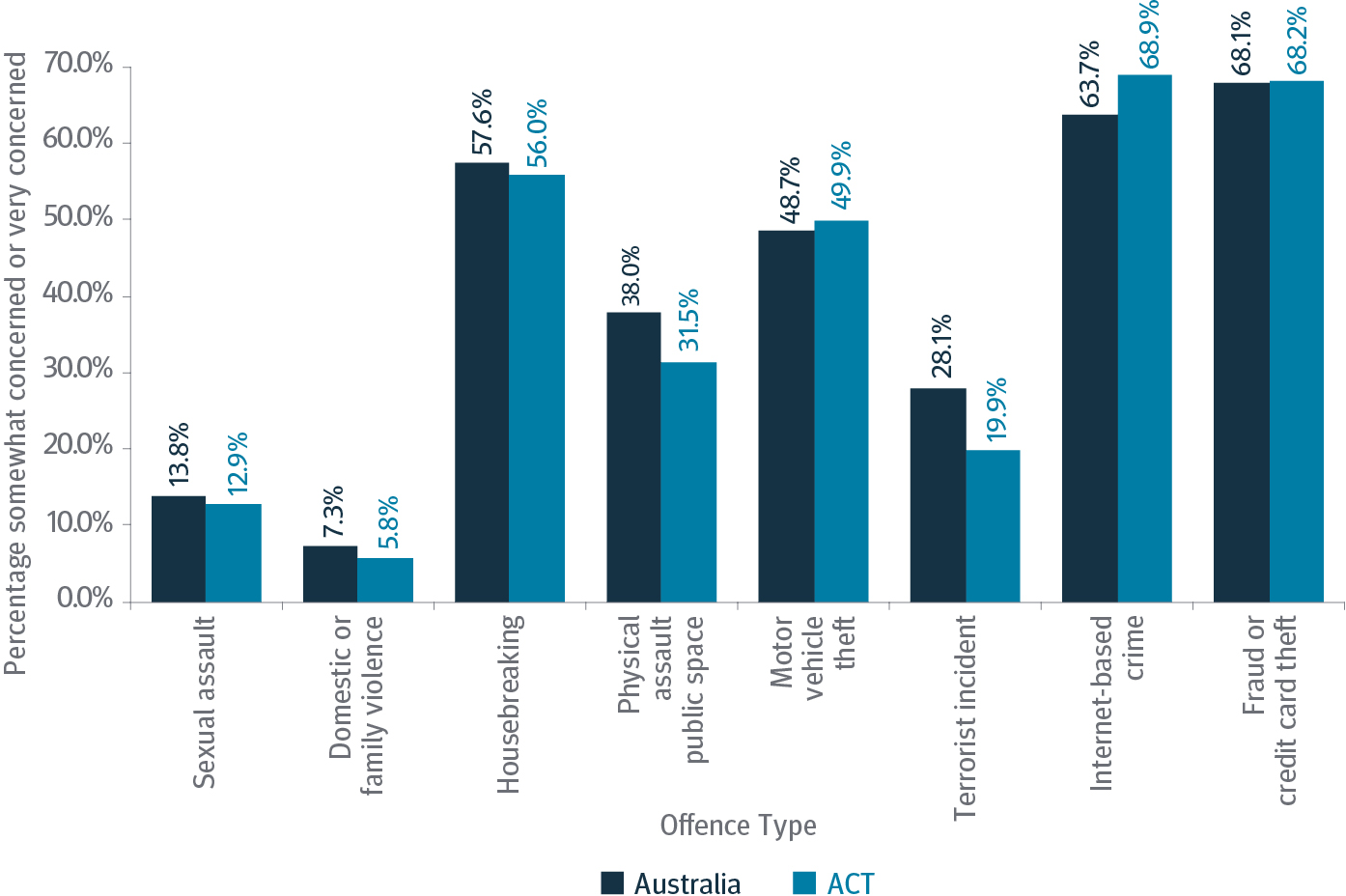
Source: National Survey of Community Satisfaction with Police, 2 July 2020
Figure 4.3 shows promising results with the ACT demonstrating a lower percentage of people concerned about being victims of domestic or family violence, sexual assault, a terrorist incident, housebreaking and physical assault in a public place.
Figure 4.4 depicts the percentage of people who feel safe by location and time of day. The ACT had positive results, with higher percentages of people who feel safe travelling on public transport and feel safe walking alone during the day and night.
FIGURE 4.4: FEELINGS OF SAFETY BY LOCATION AND TIME OF DAY 2019–20
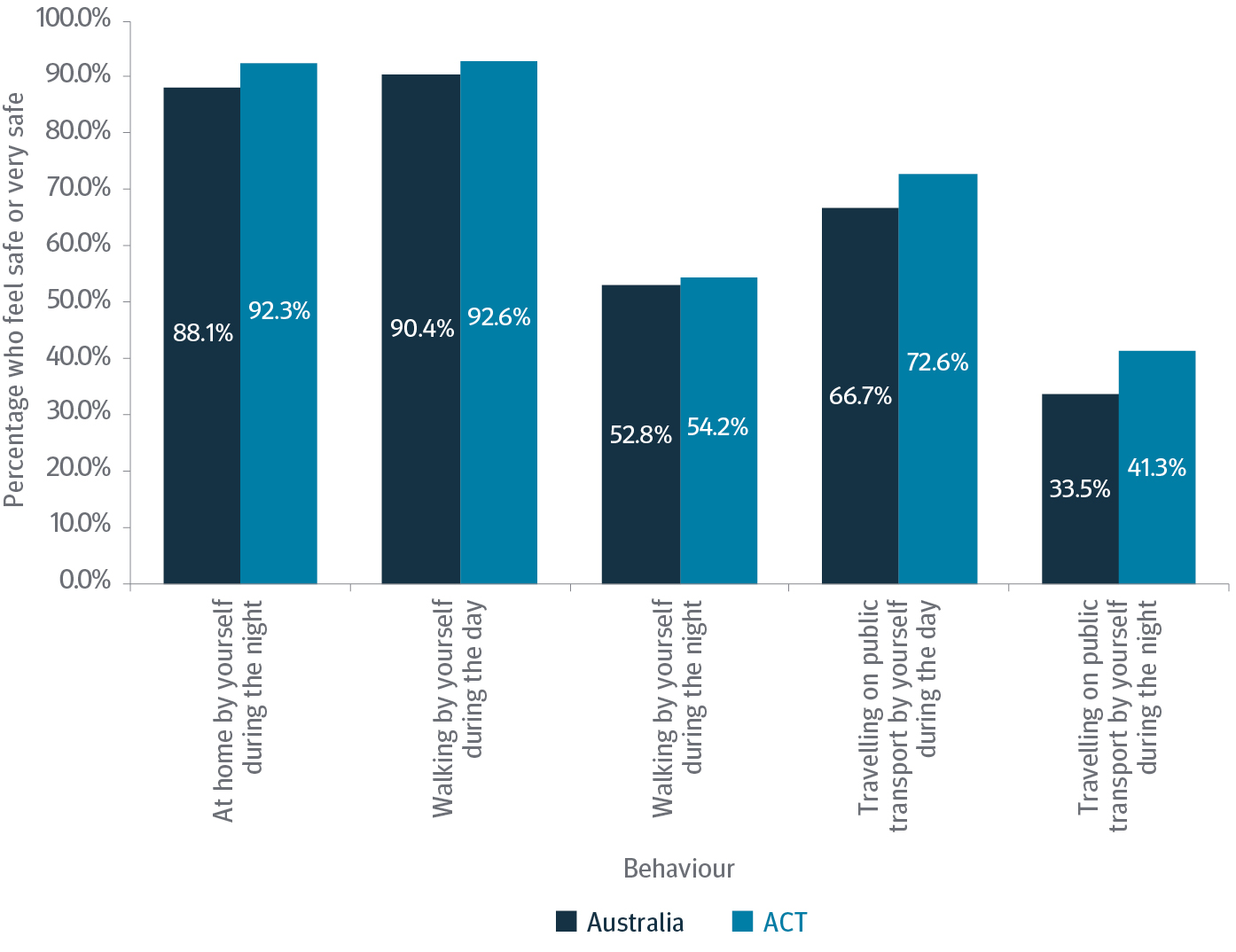
Source: National Survey of Community Satisfaction with Police, 2 July 2020
Performance Measure 2 – Number of offences against property reported or becoming known per 100,000 population.
Offences against property include but are not limited to robbery, burglary, motor vehicle thefts, property damage and other offences against property (which include fraud, traffic, drug and weapon offences and other offences not elsewhere classified).
The target for this measure was 8300 or less offences against property reported or becoming known per 100,000 population. ACT Policing achieved the target for this measure with a result of 4163.1 offences per 100,000 population.
FIGURE 4.5: OFFENCES REPORTED AGAINST PROPERTY 2010–11 TO 2019–20
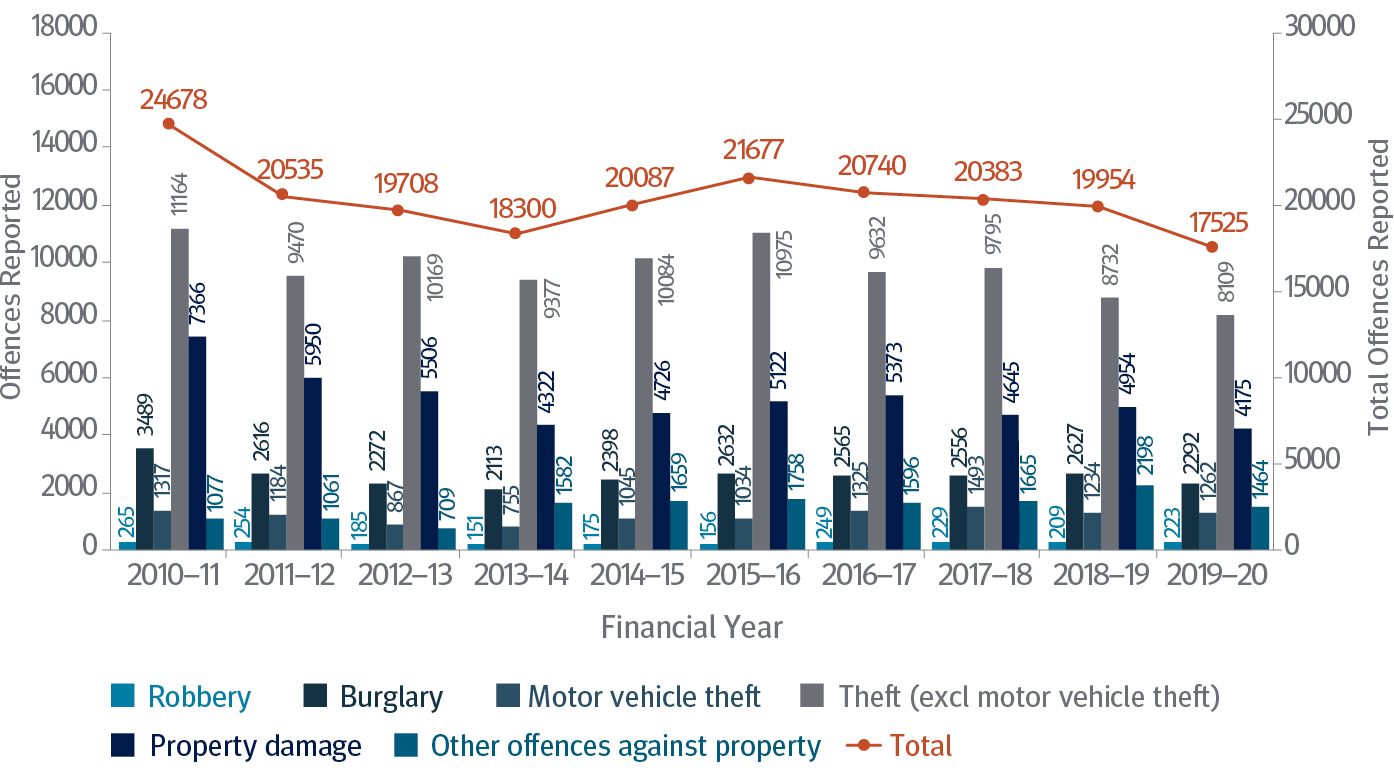
Source: PROMIS as at 2 July 2020
During 2019–20 there were a total of 17,525 offences against property reported to ACT Policing. This represents a decrease of 12.2 per cent (or 2429 offences) when compared to 2018–19.
TABLE 4.2: OFFENCES AGAINST PROPERTY BY OFFENCE TYPE – FINANCIAL YEAR COMPARISON
| Offence type | 2018–19 | 2019–20 | Change (%) |
|---|---|---|---|
| Robbery | 209 | 223 | 6.7% |
| Armed robbery | 104 | 103 | -1.0% |
| Unarmed robbery | 105 | 120 | 14.3% |
| Burglary | 2627 | 2292 | -12.8% |
| Burglary dwellings | 1659 | 1363 | -17.8% |
| Burglary shops | 419 | 370 | -11.7% |
| Burglary other | 549 | 559 | 1.8% |
| Motor Vehicle Theft | 1234 | 1262 | 2.3% |
| Theft (excl motor vehicle theft) | 8732 | 8109 | -7.1% |
| Property damage | 4954 | 4175 | -15.7% |
| Other offences against property* | 2198 | 1464 | -33.4% |
| Total | 19,954 | 17,525 | -12.2% |
Source: PROMIS as at 2 July 2020
*Other offences against property include fraud, traffic, drug and weapon offences and other offences not elsewhere classified
FIGURE 4.6: MOTOR VEHICLE THEFT OFFENCES REPORTED 2010–11 TO 2019–20
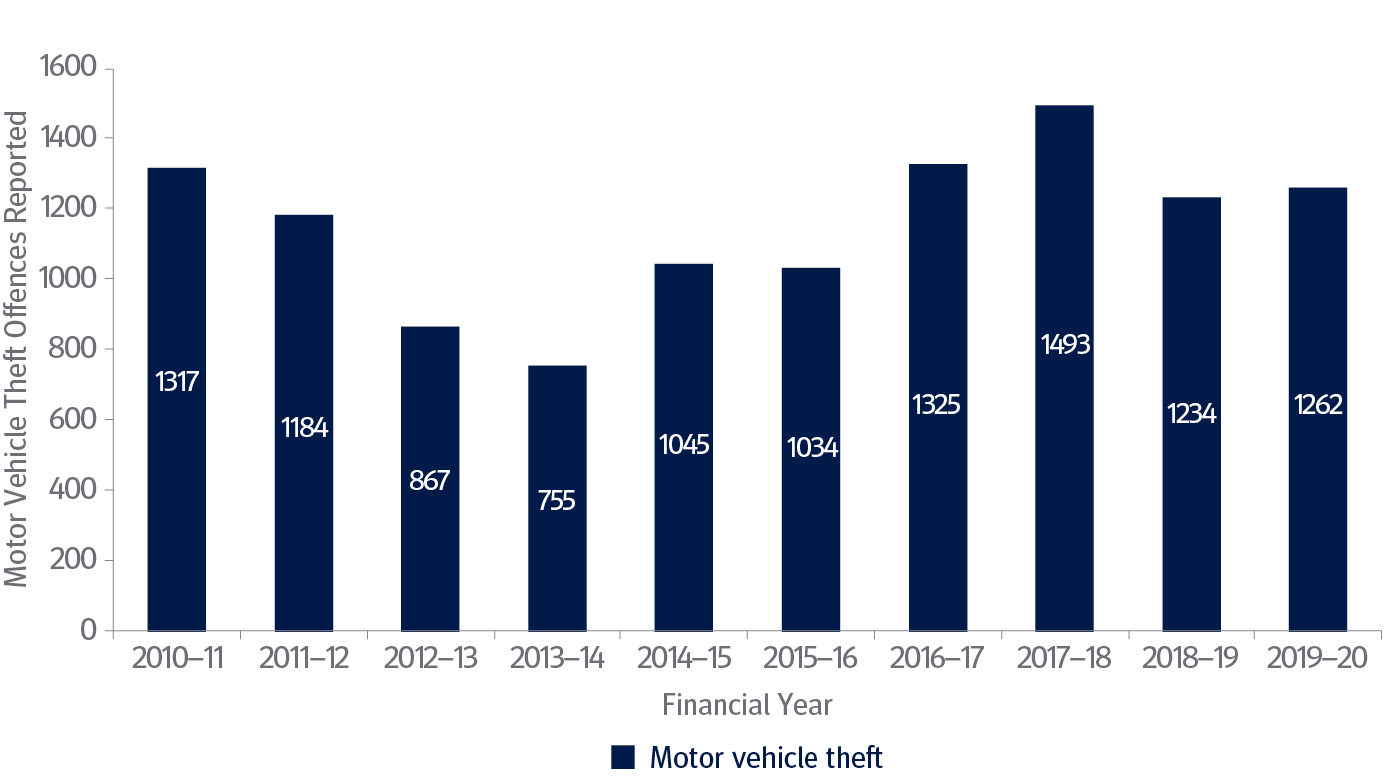
Source: PROMIS as at 2 July 2020
In October 2019, the ACT Government and ACT Policing, with the support of ACT Neighbourhood Watch and ACT Crime Stoppers, launched the Property Crime Prevention campaign ‘Outsmart the Offender’. The campaign provides useful advice and tips on how to prevent property crime from occurring. This campaign focused on a number of different themes in the 2019–20 financial year, including motor vehicle theft, home burglary, apartment theft, bicycle theft and small business theft. These campaigns were delivered as part of the Property Crime Prevention Strategy 2016–2020 which focuses on preventing crime from occurring.
ACT Policing’s Crime Disruption Team has continued to target persons involved in recidivist criminal activity through intelligence-led policing. This has enabled core groups to be identified as being directly involved in the theft of motor vehicles and has provided police with opportunities to detect, disrupt and prosecute persons involved in the commission of such offences.
Criminal Investigations and Prosecutions
Performance Measure 3 – Percentage of offences against the person cleared.
Offences cleared relates to offences where there is an outcome during 2019–20. These outcomes include the identification of an offender (through an arrest or some other form of proceeding such as a summons or a caution), withdrawal of the complaint or the determination that the offence was unsubstantiated. It is important to note the clearance of the offence may not necessarily occur in the same period in which it was reported.
The target for this measure required a clearance rate of 72 per cent or more for all offences against the person. ACT Policing did not meet the target for this measure recording a clearance rate of 70.3 per cent.
FIGURE 4.7: OFFENCES REPORTED AGAINST THE PERSON CLEARED 2010–11 TO 2019–20
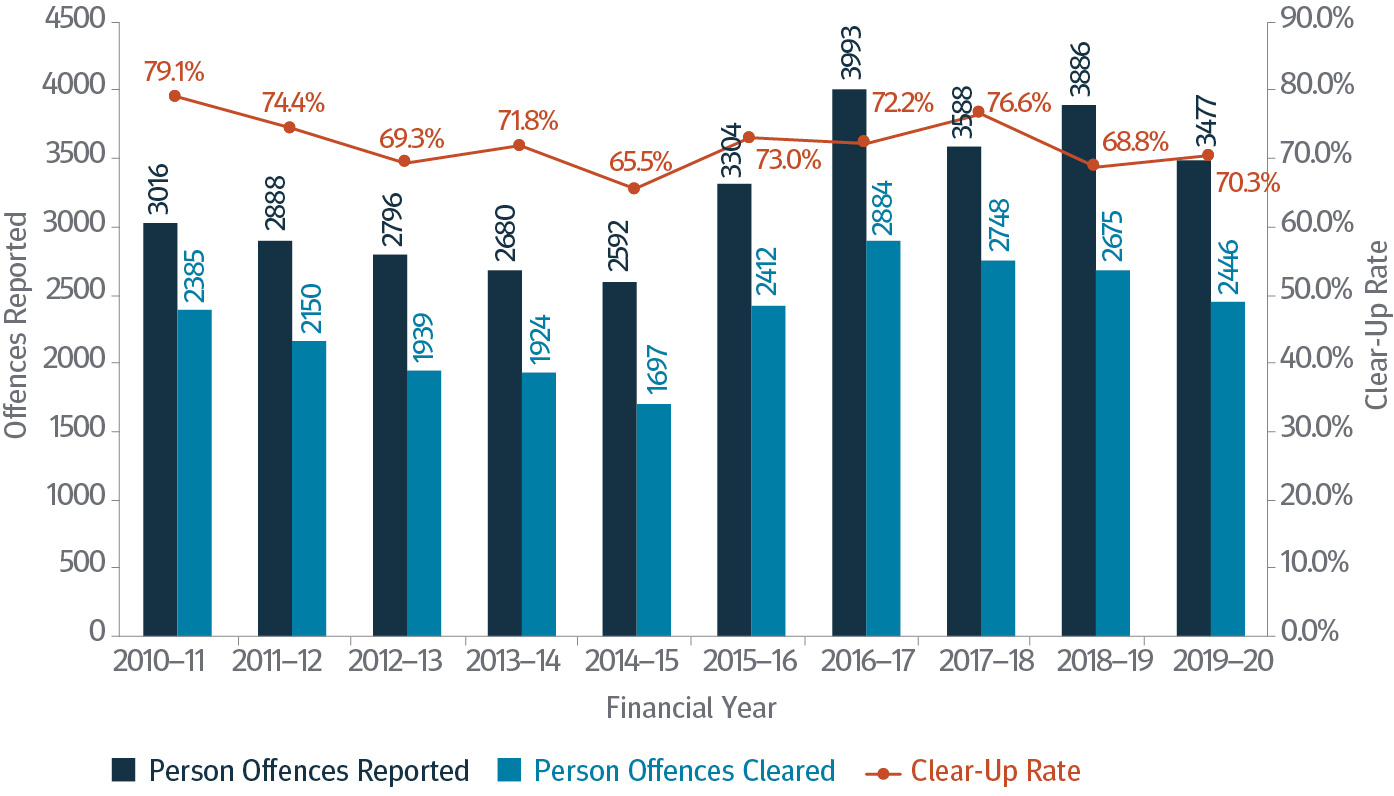
Source: PROMIS as at 2 July 2020
Performance Measure 4 – Percentage of offences against property cleared.
Offences cleared against property relates to offences where there is an outcome during 2019–20. These outcomes include the identification of an offender (through an arrest or some other form of proceeding such as a summons or a caution), withdrawal of the complaint, or the determination that the offence was unsubstantiated. These offences include robbery, burglary, motor vehicle theft, other theft, property damage and other offences against property.
Property crime is often opportunistic in nature. Many property offences occur without a victim being present. This creates additional challenges involved in identifying an offender. The target for this performance measure was 15 per cent or more offences against property cleared. In 2019–20, ACT Policing met the target for this measure achieving a clearance rate of 15.6 per cent of total property offences.
FIGURE 4.8: OFFENCES REPORTED AGAINST PROPERTY CLEARED 2010–11 TO 2019–20
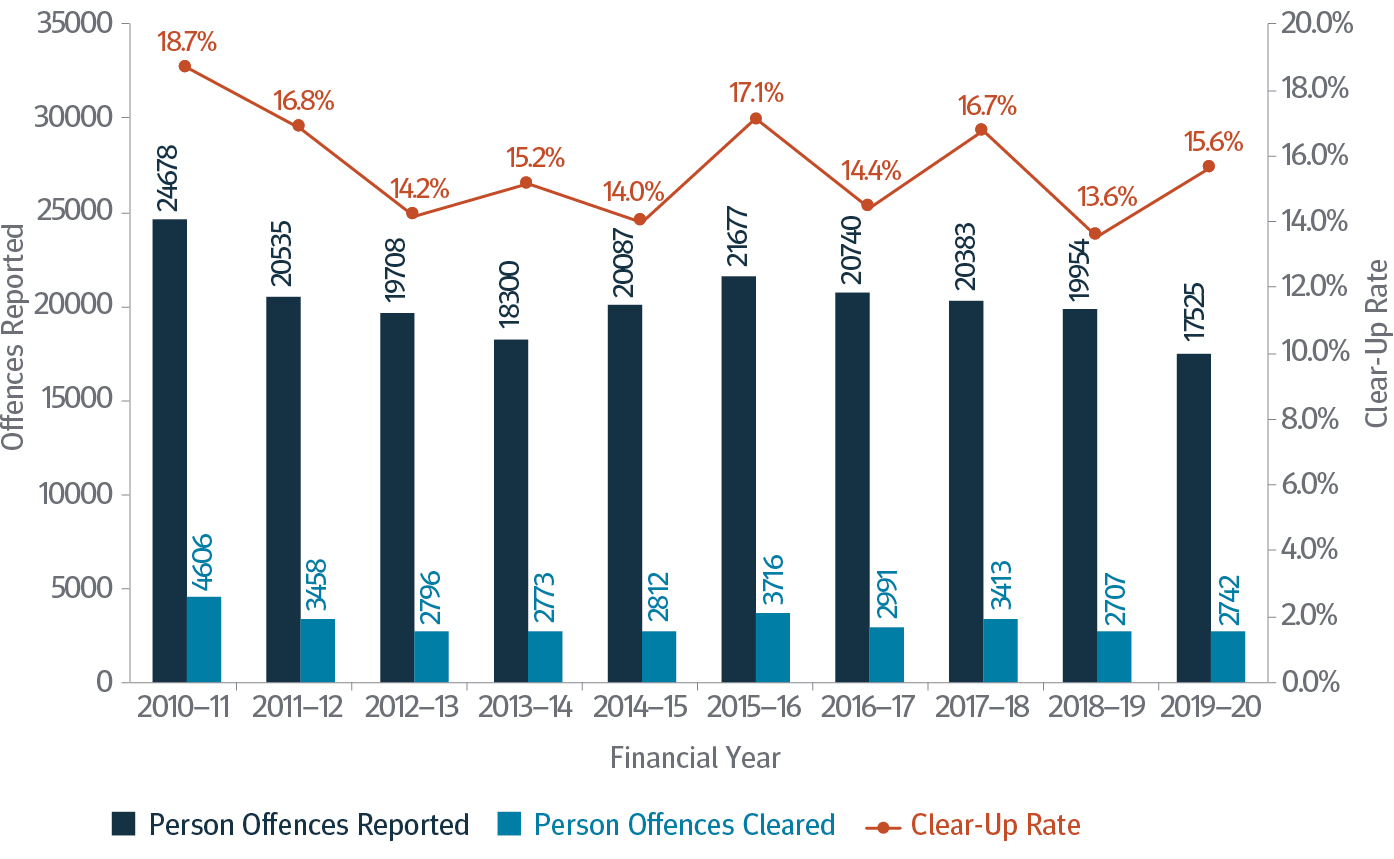
Source: PROMIS as at 2 July 2020
Performance Measure 5 – Percentage of briefs delivered to the Director of Public Prosecutions (DPP) within the designated timeframe.
The target for this measure is to deliver 75 per cent or more briefs to the DPP within the designated timeframe. The designated timeframe commences from the date of the plea to the date disclosed by the DPP.
The designated timeframes are dependent on the matter and are subject to change by the DPP. Time frames are classified as follows:
- Adult matters: 42 days
- Family violence matters: 23 days
- Child matters: 30 days.
ACT Policing met the target for this measure achieving a result of 84 per cent of briefs delivered to the DPP within the designated timeframe.
In collaboration with the ACT DPP and ACT Courts, ACT Policing is continuing work to identify and create efficiencies in processes and reduce time, cost and resource strains on the judicial system.
Performance Measure 6 – Percentage of cases finalised by offence proved in court.
The target for this measure was 82 per cent or more cases to be finalised by offence being proven in court. ACT Policing continues to perform well against this measure and achieved a result of 95.8 per cent.
As of June 2020, 483 Body Worn Cameras (BWC) and training have been provided to ACT Policing members. One of the benefits of the BWC footage is that it provides an objective record to support and provide assurance for the critical decision making of frontline members when interacting with the community. The video footage serves as strong supporting evidence in legal proceedings, and will support the number of cases proven in court.
Performance Measure 7 – Percentage of cases otherwise resolved.
This measure relates to incidents where defendants are found unfit to plea due to mental illness. The target for this measure was to ensure 5 per cent or less of cases were otherwise resolved (other than by court, a not-guilty verdict or otherwise withdrawn). ACT Policing achieved the target recording 1.5 per cent of cases otherwise resolved.
ACT Policing continues to work closely with the ACT Government and our support services to ensure that the best possible approach is applied when dealing with mental health consumers. In 2019 ACT Policing deployed a tri-service mental health co-response capability, Police, Ambulance, Clinician Early Response (PACER) as a proof-of-concept in partnership with ACT Ambulance Service and ACT Health.
Where police would traditionally be the first responders to a mental health call-out, the PACER capability provides a more holistic response consisting of a paramedic, clinician and police officer working together to attend call-outs requiring a specialist mental health response. The collaboration is acknowledged for its achievements in inter-agency cooperation and favourable outcomes for people experiencing mental health crises.
Case Study
Police, Ambulance and Clinician Early Response (PACER) A multi-disciplinary patient-centred approach to mental health crises
In December 2019, the Police, Ambulance, Clinician Early Response (PACER) program proof-of-concept was launched to improve overall response to mental health incidents. This tri-service mental health co-response capability consists of:
- ACT Policing
- ACT Ambulance Service
- Mental Health, Justice Health and Alcohol & Drug Services (MHJHADS) portfolio of Canberra Health Services (CHS).
Responding to mental health incidents is one of the most regular jobs police attend, equating to about 10 per cent of service demand. The aim of PACER is to provide mental health assessment, treatment and care for acute mental health related incidents on the frontline. The success of PACER has been in reducing the number of vulnerable people who attend the hospital environment, allowing them to remain in the community.
During Phase 1* of the pilot, the first 17 weeks, PACER attended approximately 300 cases. In 47.5 per cent of these cases PACER was the first responder. 81 per cent of patients treated were not admitted to hospital and remained in the community, reducing the burden on the Canberra Hospital.
The proof-of-concept has so far proven to be a success and has meant that mental health incidents are dealt with in the most effective and appropriate way possible. PACER has resulted in fewer involuntary apprehensions/presentations to hospital and an increase in the number of people getting the help they need on the front line. PACER’s proof-of-concept has been expanded and extended to continue through to November 2020.
*From 12 December 2020 to 5 April 2020, including 68 shifts. Phase 2 commenced from 6 April 2020 onwards.
Outcome: Public Safety
Police Response
Performance Measure 8 — Response times for Priority One incidents within 10 minutes.
The target for Priority One (life threatening or critical) incidents is a response time of ten minutes or less for 80 per cent of incidents. ACT Policing achieved this target by responding to 85.6 per cent of Priority One incidents within 10 minutes.
Data in Figure 4.9 shows results against this measure since 2014–15.
FIGURE 4.9: RESPONSE TIMES FOR PRIORITY ONE INCIDENTS 2014–15 TO 2019–20
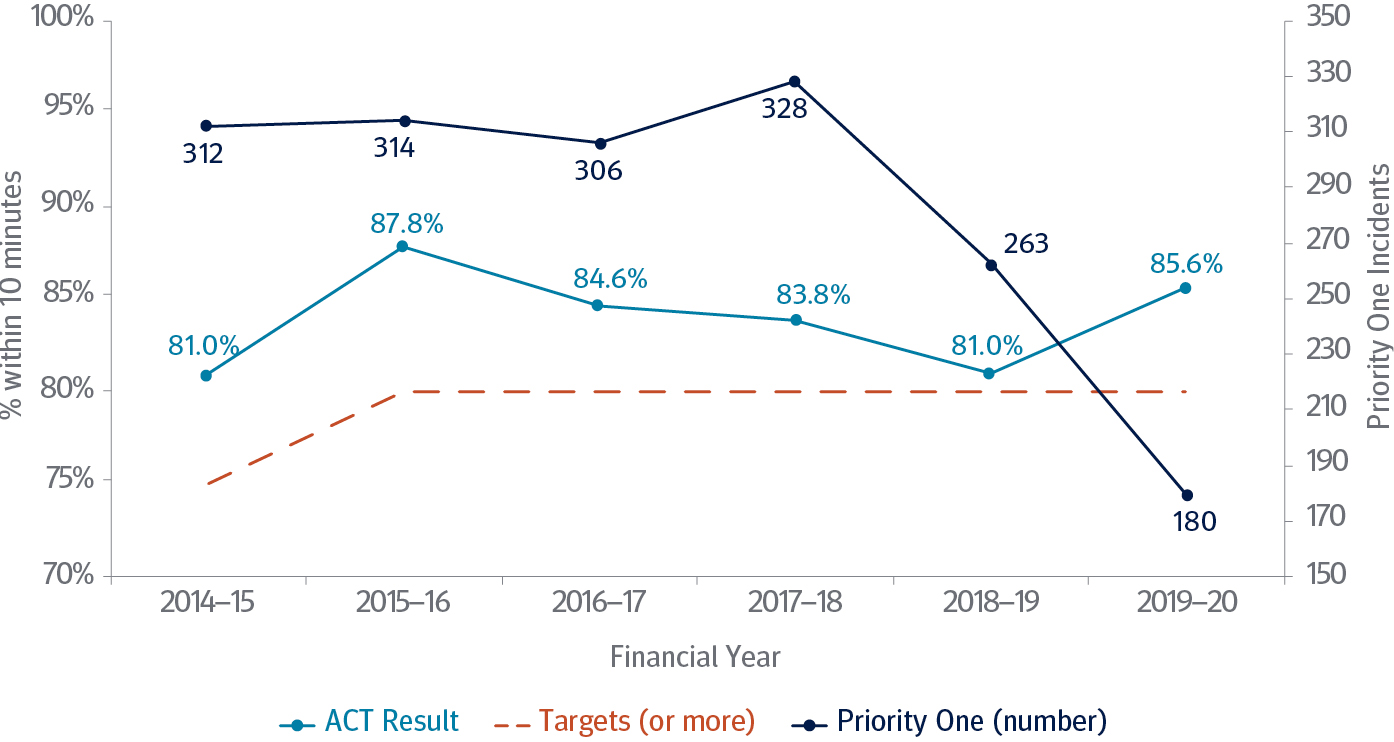
Source: PROMIS as at 2 July 2020
Performance Measure 9 – Response times for Priority Two incidents within 20 minutes.
The target for Priority Two incidents is 80 per cent or more incidents responded to within twenty minutes. ACT Policing did not achieve the target, recording a result of 74.4 per cent.
Over the past six years, ACT Policing experienced a 51.5 per cent increase in calls relating to Priority Two matters, including a 16 per cent increase from 2018–19. In 2019–20, ACT Policing failed to meet this measure by 5.6 per cent. With the increased demand on ACT Policing through calls for service, ACT Policing continues to deal with more resource-intensive matters that require police attendance.
Led by ACT Policing Futures Program, there are a number of measures underway that will help reduce calls for police assistance in the long term. Since July 2019 ACT Policing has established the foundation of the new proactive, community-focused model of police service. This includes commencing foundational project work such as the first stages of piloting new operational intelligence capabilities, introducing new technologies and recruiting and training the first of the new Proactive Policing teams.
Working closely with ACT Government and community service partners, the Proactive Policing teams will employ a variety of problem-solving techniques to reduce repeat calls for service and assist the most vulnerable members of our community. The first Proactive Policing team is scheduled to commence as a full pilot in the ACT community in the 2020–21 financial year. It is important to recognise that it will take time before these changes are visible to the community.
FIGURE 4.10: NUMBER OF PRIORITY TWO INCIDENTS 2014–15 TO 2019–20
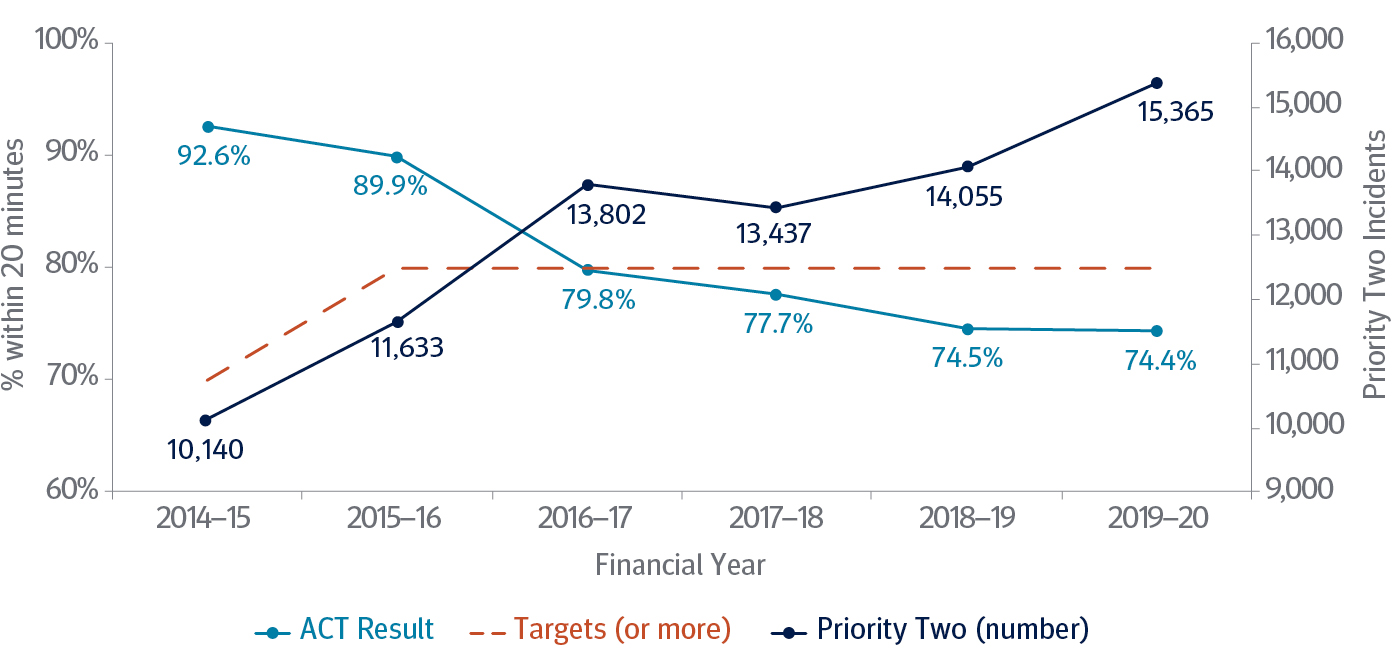
Source: PROMIS as at 2 July 2020
Performance Measure 10 – Response times for Priority Three incidents, no later than 48 hours from initial contact.
The target for this measure is 90 per cent or more incidents where police attended or responded no later than 48 hours from the initial contact by the complainant, or within a time determined in consultation with the complainant. ACT Policing achieved the target, recording a result of 95.1 per cent.
Performance Measures 11 a) – Percentage of Triple Zero (000) calls answered on first or second presentation and 11 b) – Percentage of Triple Zero (000) calls answered on second presentation.
During the reporting period Telstra, who provides the Triple Zero function for ACT Policing, underwent major changes to its infrastructure. As a result Telstra no longer have the capability to capture statistics on the number of Triple Zero calls answered by ACT Policing. While ACT Policing continues to answer and respond to all Triple Zero calls, the absence of statistical data capture has resulted in an inability to quantify the exact number of Triple Zero calls that have been answered on a particular presentation. For this reason, ACT Policing is unable to measure or report against Performance Measure 11.
Public Order and Emergency Management
Performance Measure 12 – Percentage of the community satisfied with police in dealing with public order problems.
The target for this measure is the national average or more as determined by the NSCSP. The national average for 2019–20 was 70.5 per cent, while the ACT result was 72 per cent.
Performance Measure 13 – Review and testing of arrangement for responding to and recovering from emergencies and disasters.
This Performance Measure has no corresponding numerical figures for ACT Policing to report against.
The bushfire season of 2019–2020 was one of Australia’s worst on record. However, the use of careful planning, training and management made a significant impact on how frontline emergency service agencies responded to these disasters to protect the Australian community.
In December 2019 ACT Policing’s Regional Training Team coordinated the delivery of fire training through the ACT Rural Fire Brigade and ACT Fire & Rescue prior to the start of the bushfire season. This was beneficial for members as it gave them an understanding on how to respond to a potential bushfire situation. In addition, ACT Policing distributed bushfire kits across several operational areas to ensure members were supplied with equipment to respond to a bushfire situation.
When the ACT Government enacted a State of Alert for the bushfire threat, ACT Policing Emergency Management and Planning (EM&P) developed a structured evacuation plan in consultation with the Emergency Services Agency (ESA). In addition to the bushfire kits, further Protective Personal Equipment (PPE), including fire retardant overalls, were distributed to operational areas to help protect members.
As conditions intensified the ACT Government announced a State of Emergency, enabling the mobilisation and positioning of ACT Policing members and resources to priority areas. On 30 January 2020, ACT Policing established a unified command post in Tuggeranong which operated throughout the emergency period. During this time, duties consisted of unified teams of ACT Policing, Australian Defence Force (ADF) soldiers and State Emergency Service (SES) personnel conducting door-knocking, patrols, road and traffic management operations, and public engagement during blistering heat and smoke conditions.
The previous planning and training undertaken by ACT Policing prior to the bushfire crisis benefited all operational members and teams in terms of the organisation’s ability to respond to the evolving bushfire threat over a sustained timeframe.
Alongside the bushfire preparation efforts, ACT Policing continued to work collaboratively with partners in National, State and Territory law enforcement agencies to respond to the threat of terrorism and violent extremism. Throughout the year ACT Policing:
- Invited leaders from Places of Worship in the ACT to participate in discussions on the current threat environment, breaking down barriers between the community and police, discussing layered security approaches, protective security issues and trends for Places of Worship.
- Invited representatives from the hotel and hospitality industry to participate in discussions on the current threat environment, encouraging communication between hotel and hospitality workforces and police, while also discussing layered security approaches, protective security issues and trends.
- Conducted the Capital 3 exercise, which was part of the Capital exercise program. This is a series of desktop and drill style exercises to assist ACT Policing and the ACT Government in discussing our preparedness for, and response to, a terrorism incident occurring in the ACT. The Capital 3 exercise was well received. It facilitated cross agency collaboration between ACT Policing, the AFP, the Chief Minister, Treasury and Economic Development Directorate, and Australian New Zealand Counter Terrorism Committee.
ACT Policing will continue to work with event organisers to contribute to protective security measures for crowded places in line with Australia’s Strategy for Protecting Crowded Places from Terrorism.
The first half of 2020 saw another challenge for our community when the COVID-19 pandemic recorded its first case in the ACT. ACT Policing responded to the public health emergency which saw the formation of a dedicated taskforce, and the diversion of the Territory Targeting Teams to focus on education and compliance with public health restrictions. ACT Policing will continue to deploy resources flexibly to adapt to the evolving COVID-19 environment.
Case Study
COVID-19 pandemic and Territory Targeting Team (TTT)
ACT Policing prides itself on being an agile policing service capable of adapting its operations during any crisis. In 2020, police members relied on their training to continue our commitment to supporting the community during the global pandemic of COVID-19. The ACT recorded its first case of COVID-19 on 12 March 2020, triggering the ACT Minister for Health to declare a Public Health Emergency on 16 March 2020.
ACT Policing responded quickly ensuring that its members were trained and equipped with Personal Protective Equipment such as sanitiser, gloves, protective eyewear and P2/N95 masks. This enabled members to safely interact with the public and each other. A planning taskforce was also established to ensure frontline members remained well positioned and able to continue to provide a 24/7 policing response to the community.
ACT Policing focused on engaging with the community and adopted an educative approach to maintaining public safety. General Duties officers, Road Policing and more specifically the TTT utilised interactions with the community as an opportunity to provide education on social distancing, compliance measures and explain potential direction breaches.
For the TTT, its day-to-day business completely changed.
The TTT’s role of combating alcohol-fuelled violence around nightclubs and pubs ceased to exist with COVID-19 resulting in the shutdown of licensed premises, public gatherings and parties. This made the team uniquely available to adjust its focus towards the new laws around social distancing. TTT members saw their roles change from primarily interacting with a narrow cross-section of the community who are often intoxicated and sometimes violent, to interacting with Canberrans from all backgrounds and demographics at any given time of the day.
The TTT also worked with ACT Government inspectors to ensure compliance with the public health directions around gatherings, businesses and self-quarantine measures. Additionally, bottle shops were still trading so the TTT ensured these businesses continued to comply with liquor laws.
The educative approach was well received by the community, with most heeding the advice and appreciating ACT Policing’s assistance in keeping them safe during the unprecedented times.
Road Safety and Traffic Management
Performance Measure 14 – Number of road crashes resulting in death per 100,000 population.
The target for this performance measure was 4.2 or less road crashes resulting in death per 100,000 population. ACT Policing achieved the target, recording a result of 1 fatal road crash per 100,000 population during 2019–20.
As presented in Figure 4.11 the number of fatal collisions per 100,000 population in the ACT remains consistently below the national average.
FIGURE 4.11: ROAD CRASHES RESULTING IN DEATH PER 100,000 POPULATION 2015–16 to 2019–20
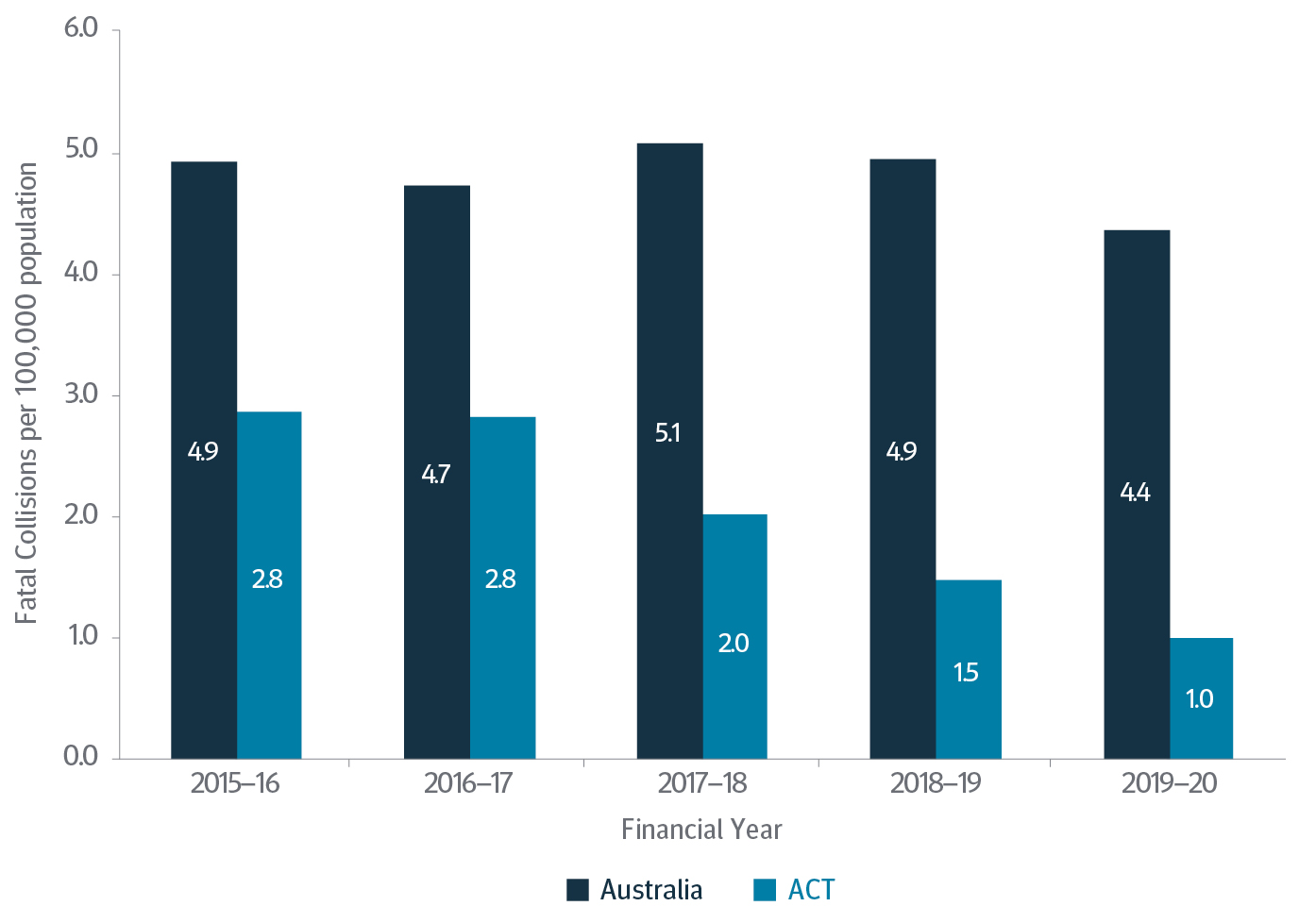
Source: Australian Road Deaths Database as at 30 June 2020
ACT Policing continues to target anti-social and dangerous driving behaviours in an effort to reduce road trauma through high-visibility patrols and education campaigns. On 27 August 2019, ACT Policing participated in the National Day of Action on rural road safety. As a part of this Day of Action, ACT Policing social media messaging was ‘enough is enough’, a nationally consistent message shared by other police jurisdictions in Australia. On this day, a total of 46 motorists were issued with infringements by ACT Policing, with 33 relating specifically to speeding.
In December 2019 ACT Policing and NSW Police launched the 2019–20 Kings Highway Road Safety Campaign at the Brooks Hill Rest Area on the ACT–NSW border. The campaign reminded drivers to obey the speed limits, take regular breaks and remain patient and alert when driving in heavy traffic on the Kings Highway over the holiday season. Drivers were also reminded of the additional challenges due to the impacts of the bushfire season, resulting in several lengthy closures and damaged infrastructure to parts of the Kings Highway.
ACT Policing will continue efforts to reduce road trauma and improve road safety, in line with Vision Zero, the ACT Road Safety Strategy 2011–2020 and the ACT Road Safety Action Plan 2016–2020.
Performance Measure 15 – Number of road crashes resulting in injury per 100,000 population.
The target for this measure was 180 or less road crashes resulting in injury per 100,000 population. ACT Policing achieved this measure with the number of road collisions resulting in injury recorded at 94.1 per 100,000 population.
FIGURE 4.12: MOTOR VEHICLE COLLISIONS WITH INJURY 2014–15 to 2019–20
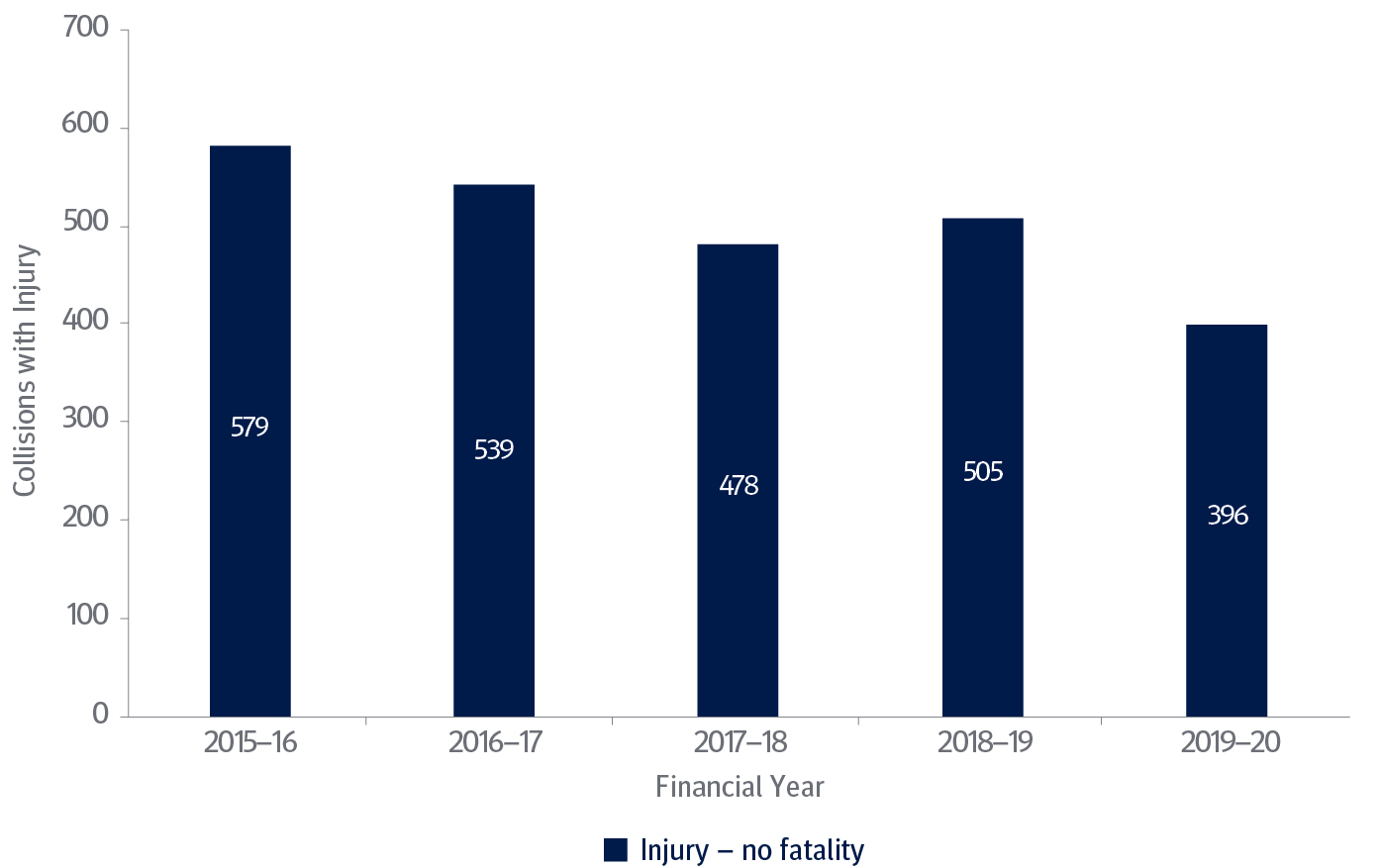
Source: PROMIS as at 2 July 2020
ACT Policing continues to educate Canberra drivers regarding the dangers of speeding and the need to drive to weather conditions through a schedule of regular media engagements, social media posts and other activities.
Road Policing (formerly Traffic Operations) also continues to work closely with the Road Transport Authority to improve public safety by identifying road design faults, contributing factors in collisions, and ensuring vehicles driven on ACT roads are safe and comply with road standards.
With two long weekends for Easter and Anzac Day during April, Road Policing was kept busy with reckless drivers exceeding speed limits within the Territory. A speed enforcement operation over the ANZAC Day long weekend saw more than 250 drivers issued infringement notices. The operation was established to reinforce the importance of observing speed limits for all road users’ safety and supports the ACT’s Road Safety Strategy 2011–2020.
Case Study
Speeding Case Study
Speeding is considered one of the ‘Fatal Five’ contributing factors to deaths on ACT roads. Road Policing (formerly Traffic Operations) manages road safety by enforcing the ACT Road Rules, and by promoting safer driving to reduce road trauma and the ACT road toll. Road Policing works in partnership with ACT Government agencies such as the Justice and Community Safety (JaCS) Directorate to support the ACT Government’s Road Safety Strategy 2011–2020.
ACT Policing can conduct speed checks anywhere, at any time. Despite the global pandemic, ACT Policing continued to be highly visible on Canberra’s roads resulting in a notable increase in the number of Traffic Infringement Notices (TINS) issued to drivers caught exceeding the speed limit. Overall, the number of TINS issued in the ACT for speeding has increased over the last five years by 14.8 per cent.
In 2019–20 ACT Policing issued:
- 10,027 TINS
- Of these, 5028 TINS related to speeding
- 3290 TINS for exceeding speed limit by 15km/h but less than 30km/h
- 347 TINS for exceeding speed limit by 30km/h
- 99 TINS for high range speeding (more than 45km/h).
ACT Policing has seen an alarming number of high range speeding incidents in the first half of 2020. One notable example included detecting a driver travelling in Higgins at 177km/h in an 80km/h zone in late June 2020. The driver was issued an Immediate Suspension Notice and faced Court on various charges relating to high range speeding, drink and drug driving.
Outcome: Community and Partner Engagement
Community Support and Whole-of-Government Engagement
Performance Measure 16 – Percentage of the community satisfied in general with services provided by police.
The target for this performance measure is the national average or more as determined by the NSCSP. The national average for 2019–20 was 78.3 per cent, while the ACT result was 78.2 per cent.
Performance Measure 17 – Percentage of the community who have confidence in police.
The target for this performance measure is the national average or more as determined by the NSCSP. The national average for 2019–20 was 81.6 per cent, while the ACT result was 83.7 per cent.
Figure 4.13 shows ACT Policing’s performance against measures relating to community satisfaction and confidence.
FIGURE 4.13: SATISFACTION AND CONFIDENCE IN POLICE 2019–20
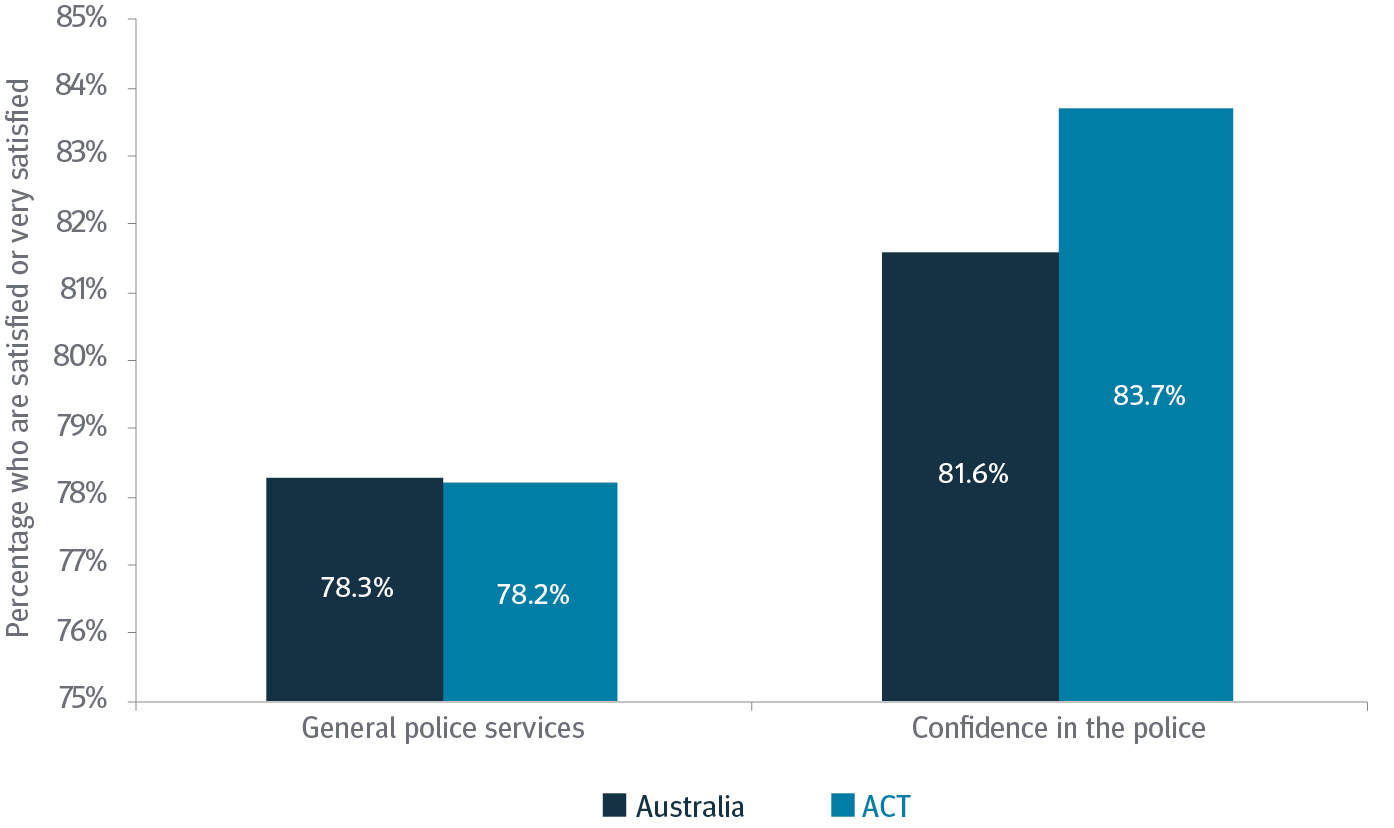
Source: National Survey of Community Satisfaction with Police, 2 July 2020
During 2019–20 ACT Policing focused more efforts on community engagement through initiatives such as ‘Coffee with a Cop’ which commenced in August 2019. Often the community’s primary interaction with ACT Policing is in high stress situations. ACT Policing ran a number of ‘Coffee with a Cop’ events during the reporting period which enabled police to engage with the public in a relaxed environment to build trust and help break down barriers. The community were able to meet police in their area, ask questions and voice any concerns that they had which also enabled ACT Policing to gain a greater insight into issues affecting the community.
This initiative helps to build public confidence in police and provides an opportunity for ACT Policing to foster positive relationships with the community.
Performance Measure 18 – Percentage of eligible young people referred to restorative justice.
The target for this performance measure is for ACT Policing to refer 100 per cent of eligible young offenders to restorative justice.
Results for 2019–20 show ACT Policing did not meet the target for this Performance Measure, with 88.5 per cent of eligible young offenders referred to restorative justice. ACT Policing failed to meet this target by 11.5 per cent which equates to 11 individuals.
ACT Policing is committed to meeting the target for the Performance Measure and is working with Government and non-government partners to identify options for increased diversion and community-based referrals.
ACT Policing is committed to the diversion targets outlined in the Aboriginal and Torres Strait Islander Agreement 2019–2028, in diverting at least 25 per cent of all eligible 18 to 25-year-old Aboriginal and Torres Strait Islander peoples to restorative justice. Under the new Agreement and Action Plan, ACT Policing will focus on equitable access and culturally-safe restorative justice, including prevention and diversion programs for Aboriginal and Torres Strait Islander peoples.
There have been positive steps in exploring alternatives to criminal prosecution, particularly the expansion of the formal cautioning framework for youth and Aboriginal and Torres Strait Islander peoples. These alternatives were developed in consultation with stakeholders and the community, such as input from the Chief Police Officer’s Advisory Board, to include culturally appropriate diversion options and reforming internal thresholds for cautioning.
In support of this, ACT Policing attended the Warrumbul Circle Sentencing Court Opening on 6 December 2019. This is a specialised court within the ACT Children’s Court, where Aboriginal and Torres Strait Islander peoples can have their sentencing matters heard by a Magistrate, alongside a panel of respected Aboriginal and Torres Strait Islander Elders. ACT Policing have been involved in the Warrumbul Court to increase police engagement with young offenders going through the court process. The Warrumbul Court provides another avenue for ACT Policing to recommend available and appropriate diversionary programs for young people.
Case Study
Aboriginal and Torres Strait Islander Liaison Officers
ACT Policing is transitioning to a new community-focused model of police service which includes a greater focus on improving engagement with the Aboriginal and Torres Strait Islander community to improve life outcomes and reduce representation in the criminal justice system. To support this, the ACT Government has provided funding for an additional Aboriginal and Torres Strait Islander Liaison Officer (ALO) for ACT Policing.
ACT Policing recognises that this role is an important link and service provided by police to the community. ACT Policing’s ALOs directly work with the local Aboriginal and Torres Strait Islander community and local stakeholders that represent the Aboriginal and Torres Strait Islander peoples. Through the connections the ALOs have in the community, ACT Policing has increased the ability to identify families at risk, to engage with them, gain trust and refer to relevant and culturally appropriate support and education services.
This financial year, the ALOs delivered specialised Cultural Connections Training (formerly known as Cultural Competency Training) to 180* ACT Policing front line members, to help members understand and identify the effects that cultural differences can have upon the police-community relationship. This training covers a number of topics including:
- Protocols when attending the Aboriginal Tent Embassy
- The importance of using appropriate terminology
- The role of the ALOs
- How to achieve effective communication with community
- Interviews and discussions (interview friends).
The ALOs sit within the Community Engagement Team (CET) who represent ACT Policing at a variety of multicultural events and venues, to engage and build relationships with Canberra’s multicultural community. ACT Policing members and our ALOs attend a range of community events, including NAIDOC Week events, in order to boost positive engagement and to strengthen respectful relationships with the Aboriginal and Torres Strait Islander community.
During 2019–20 ACT Policing CET team and ALOs supported a number of literacy events with the community, including the Great Book Swap at the University of Canberra. The Great Book Swap supports Indigenous Literacy Day and the Indigenous Literacy Foundation. This was the first time ACT Policing’s ALOs had been involved, and saw ACT Policing engaging with highly regarded authors, students and members of the Aboriginal and Torres Strait Islander community.
ACT Policing’s ALOs, the Multicultural Liaison Officer, Constable Kenny Koala and other CET team members also attended the Gungahlin Library’s Story Time session with ACT’s multi-cultural community. For ACT Policing it was a great opportunity to engage with the local community and their parents in a fun, interactive environment. It was also a chance for our members to explain how police officers support the community and to discuss the diverse role of Australian law enforcement.
*as at 30 June 2020
Performance Measure 19 – Number of persons referred to community support agencies.
The annual target for this measure is 5500 or more persons referred to community support agencies. Results for 2019–20 show ACT Policing met this target with 6090 referrals to SupportLink, which is 10.7 per cent above the target. ACT Policing will continue to refer people to appropriate support agencies.
Performance Measure 20 – Number of referrals to drug diversion programs (drug demand reduction effort).
The annual target for this measure was 80 or more referrals to drug diversion programs.
Results for 2019–20 show ACT Policing met this target with 166 people diverted into the Early Intervention and Drug Diversion Program. ACT Policing continues to focus on drug harm minimisation through these referrals. Given that the majority of these persons would have otherwise entered a formal court process, this reduces the overall burden on the justice system and minimises the harm caused by illicit drugs.
Performance Measure 21 – ACT Policing Victim Liaison Officers providing contact with victims of indictable crime reported to police.
The target for this measure was 80 per cent or more. ACT Policing achieved this target with 83.6 per cent of victims contacted by our Victim Liaison Officers (VLOs) during 2019–20. Providing assistance to victims of crime through VLO contact has the potential to reduce further victimisation, stop the escalation of crime and provide victims with appropriate support.
Professional standards
- AFP Professional Standards Framework
- ACT Policing Complaint Statistics
- Trends Analysis
- Finalised Conduct Issues
The term professional standards relates to the Commissioner’s expectation that all AFP appointees will serve with integrity. This includes those in ACT Policing.
AFP Professional Standards, which sits within the AFP’s Chief of Staff Command, is responsible for developing and maintaining the highest professional standards throughout the organisation, as well as overseeing and investigating complaints about the conduct of AFP appointees.
The AFP’s professional standards are underpinned by the AFP Core Values (see Chapter 3: Our Values) and the AFP Code of Conduct. Further information on the AFP Values and the AFP Code of Conduct is available on the AFP website (www.afp.gov.au).
AFP Professional Standards Framework
The AFP’s professional standards framework is governed by Part V of the Australian Federal Police Act 1979 (Cth) and the Australian Federal Police Regulations 1979 (Cth).
This framework is further supported by internal governance such as the Commissioner’s Order on Professional Standards and the National Guideline on Complaint Management. The Commonwealth Ombudsman and the Australian Commission for Law Enforcement Integrity (ACLEI) oversee the framework.
The AFP is committed to managing fraud and corruption risks as part of its everyday business, and complies with the Australian National Audit Office Better Practice Guide on Fraud Control in Australian Government Entities. As a Commonwealth entity, the AFP has a Fraud Control and Anti-corruption Plan which ensures compliance with the Public Governance, Performance and Accountability Rule 2014 (Cth).
Relevant ACT Government Ministers can be informed about ACLEI’s activities when investigating serious corruption as defined by the Law Enforcement Integrity Commissioner Act 2006 (Cth).
The AFP’s Professional Standards framework adopts a tiered approach according to the seriousness of the breach:
- Category 1 conduct — customer service matters
- Category 2 conduct — minor misconduct
- Category 3 conduct — serious misconduct including breaches of the criminal law or serious neglect of duty
- Corruption issues (also referred to as Category 4).
Complaints dealing with Categories 1 and 2 of the AFP’s Professional Standards Framework are managed by line managers through the ACT Policing Complaint Management Team.
Serious misconduct matters that may result in employment suitability consideration (Category 3) are investigated by AFP Professional Standards. Every Category 3 matter is also reported to the Commonwealth Ombudsman for additional oversight.
Complaints and information about corrupt conduct of AFP appointees are immediately referred to ACLEI. Pursuant to section 26 of the Law Enforcement Integrity Commissioner Act 2006 (Cth), the Integrity Commissioner will determine whether a matter is investigated jointly with AFP Professional Standards, solely by ACLEI or as an AFP-only investigation.
ACT Policing Complaint Statistics
Financial Year 2019–20
During the financial year 2019–20, AFP’s Professional Standard received 110 complaints relating to ACT Policing, resulting in 168 alleged conduct breaches1 being recorded.
TABLE 5.1: ALLEGED CONDUCT BREACHES RECORDED DURING LAST FOUR YEARS, BY CATEGORY 2
| All ACT Policing Breaches | 2016–17 | 2017–18 | 2018–19 | 2019–20 |
|---|---|---|---|---|
| Category 1 | 67 | 66 | 82 | 68 |
| Category 2 | 120 | 143 | 69 | 42 |
| Category 3 | 55 | 48 | 49 | 47 |
| Corruption issues | 9 | 19 | 16 | 11 |
| Total | 251 | 276 | 216 | 168 |
TABLE 5.2: ALLEGED COMPLAINTS RECORDED DURING 2019–20, BY SOURCE
| Source | Total breaches | Percentage |
|---|---|---|
| Anonymous member of the public | 2 | 1.82% |
| Member of the public | 65 | 59.09% |
| Reporting another AFP member | 35 | 31.82% |
| Self-reported | 8 | 7.27% |
| Total | 110 | 100% |
TABLE 5.3: FINALISED CONDUCT BREACHES DURING 2019–20, BY CATEGORY 3
| All ACT policing breaches | Established | Not established | Discretion not to proceed | Withdrawn |
|---|---|---|---|---|
| Category 1 | 5 | 65 | 11 | 3 |
| Category 2 | 24 | 35 | 7 | 3 |
| Category 3 | 14 | 51 | 9 | - |
| Corruption issues | - | 5 | 2 | - |
| Total | 43 | 156 | 29 | 6 |
TABLE 5.4: ESTABLISHED CONDUCT BREACHES DURING 2019–20
| Conduct breach | Number established |
|---|---|
| Property accounting failure | 6 |
| Information access | 5 |
| Inappropriate behaviour/conduct- serious | 4 |
| Property holding failure | 3 |
| Inadequate service | 3 |
| Breach of Commissioner’s Order 3— non-serious nature | 3 |
| Supervision failure | 2 |
| Breach of Commissioner’s Order 3— with injury | 2 |
| Unauthorised discharge of conducted electrical weapon | 2 |
| Misuse of authority | 2 |
| Inappropriate behaviour/conduct | 2 |
| False information/statement | 1 |
| Unreasonable delay | 1 |
| Breach of Commissioner’s Order 3— fail secure ammo/accoutrements | 1 |
| Fail to record and report | 1 |
| Information release | 1 |
| Discourtesy | 1 |
| Fail to comply with procedure | 1 |
| Driving misconduct | 1 |
| Fail to declare association | 1 |
| Total | 43 |
Timeliness benchmarks are applied to each category, with a target of 90 per cent to be finalised within the specified number of days. The benchmarks are:
- 42 days for Category 1 matters
- 66 days for Category 2 matters
- 256 days for Category 3 matters.
Corruption issues fall under the Law Enforcement Integrity Commissioner Act 2006 (Cth) and are not subject to a timeliness benchmark.
TABLE 5.5: COMPLAINTS ON HAND, AS OF 1 JULY 2020
| All ongoing ACT policing complaints | Complaints ongoing | Number of complaints overdue | Exceeds 30 days over benchmark | Exceeds 90 days over benchmark |
|---|---|---|---|---|
| Category 1 | 11 | 5 | 4 | 1 |
| Category 2 | 8 | 4 | 3 | 1 |
| Category 3 | 15 | 2 | - | 2 |
| Corruption issues | 13 | - | - | - |
| Total | 47 | 11 | 7 | 4 |
Complaint data
The complaint data contained in this report was extracted from the AFP’s SAS Visual Analytics, which is a live system and is updated on a daily basis. This report is reflective of Category 1–4 complaints that relate to members of ACT Policing. The data for this report was extracted and accurate as at 1 July 2020.
Trends Analysis
Alleged Conduct Breaches Submitted
Compared to 2018–19, ACT Policing has seen a 22.22 per cent decrease in total alleged conduct breaches (216 to 168) during 2019–20 and a 33.06 per cent decrease since the 2016–17 financial year (Table 5.1).
In relation to the source of the complaints, for the 2019–20 financial year, there was an increase of two complaints where an AFP member reported themselves compared to the 2018–19 financial year. The source of the complaints received in 2019–20 from an anonymous member of the public, member of the public and reporting another AFP member remained relatively consistent with the 2018–19 financial year.
Category 1 — ACT Policing saw a decrease of 17.07 per cent in 2019–20 of Category 1 breaches compared to the previous 2018–19 financial year. The 68 alleged breaches submitted in the 2019–20 financial year is consistent with figures from 2016–17 (67) and 2017–18 (66) financial years.
Category 2 — Compared to the 2018–19 financial year, there has been a 39.13 per cent decrease in alleged Category 2 breaches. Since the 2016–17 financial year, there has been a 65 per cent decrease in alleged Category 2 breaches.
Category 3 — Alleged Category 3 breaches submitted have remained relatively consistent across the 2017–18, 2018–19 and 2019–20 financial years. There has been 14.54 per cent decrease in alleged Category 3 breaches since the 2016–17 financial year.
Corruption Issues — Compared to the 2018–19 financial year there has been a decrease of 31.25 per cent in reports of alleged corruption.
The top most reported alleged breaches submitted against ACT Policing members were:
Category 1
- Discourtesy
- Inadequate service
- Failure to act.
Category 2
- Inappropriate behaviour/conduct
- Information release
- Property holding failure.
Category 3
- Breach of Commissioner’s Order 3 — with injury
- Inappropriate behaviour/conduct — serious
- Neglect of duty
- Information misuse
- Inappropriate behaviour/conduct.
Finalised Conduct Issues
In 2019–20, 137 complaints (235 conduct breaches) were finalised, an increase of 10 complaints compared to the number finalised in the 2018–19 financial year.
The percentage of Established and Not Established Category 1–4 conduct breaches finalised in the 2019–20 financial year is consistent with the 2018–19 financial year. There was a 34.09 per cent decrease (44 to 29) in the number of conduct breaches finalised with a finding of ‘Discretion not to proceed’ compared to the 2018–19 financial year.
To maintain proper oversight and ensure AFP complaint investigations maintain integrity and fairness in practice and process, the Commonwealth Law Enforcement Ombudsman undertakes a review of randomly selected complaint investigations every year. ACT Policing and the AFP work closely with the Commonwealth Law Enforcement Ombudsman to adopt the principles of best practice for complaint management.
Established Matters
The number of conduct breaches established in the 2018–19 and 2019–20 financial years was consistent with 43 established in each financial year. In the 2019–20 financial year, 34.78 per cent of Category 2 conduct breaches finalised were established compared to 21.05 per cent in the 2018–19 financial year. The opposite was seen with Category 3 conduct breaches finalised, where 18.92 per cent were established in the 2019–20 financial year compared to 32.76 per cent established in the 2018–19 financial year.
In the 2019–20 financial year there were six established conduct breaches related to property accounting failure. Three of the six established conduct breaches involved an AFP member self-reporting.
In April 2019, new software features were installed in the AFP’s operational recording systems. The new interactive features identify potential improper access to data prior to access, and are intended to reduce instances of unauthorised information access. This could be a contributing factor to the decrease seen in established information access conduct breaches from eight in the 2018–19 financial year to five in the 2019–20 financial year.
Use of force
All AFP members including those in ACT Policing are governed by AFP Commissioner’s Order 3 (CO3) in the application of use of force principles. CO3 articulates mandatory compliance requirements in reporting and training.
All police members receive use of force training, during which the principles of communication and conflict de-escalation are emphasised as alternatives to the use of physical force. Police members are required to complete use of force qualifications annually.
In all cases where members use force that is not a routine use of force the officer must, as soon as practical, submit a use of force report. ‘Use’ is defined with respect to the type of force used, which is as follows:
- Firearm, conducted electrical weapon (CEW) or chemical agent (OC Spray) or extended range impact weapon:
- drawing
- aiming
- discharging
- Baton:
- raising with the intention to strike or gain compliance
- striking a person
- Shield:
- striking a person with any part of the shield
- Police dog:
- directed intentional deployment at a person with the intention to gain compliance whether or not the police dog bites the subject
- defence of itself, handler or any other person
- Pyrotechnic device:*
- discharging the device so that concussive force, light, sound or any combination of these is emitted against another person
* This use of force option is available to Specialist Protective Services only
- discharging the device so that concussive force, light, sound or any combination of these is emitted against another person
- Long range audio device:*
- Emitting sound from the device against another person to gain subject control
* This use of force option is available to Specialist Protective Services only.
- Emitting sound from the device against another person to gain subject control
Routine use of force means the following uses of force performed as part of an AFP appointee’s operational duties:
- compliant escort or restraint holds (including to effect an arrest)
- compliant handcuffing
- compliant search of a person
- force to enter a building, vehicle, vessel, or other secured area to search, recover, seize or arrest, where there is no application of force against a person.
Routine uses of force or verbal commands which do not involve the application of use of force options are not reportable. The circumstances of each routine use of force incident event must be recorded within the relevant PROMIS case.
All use of force reports are assessed for compliance with CO3 by the respective business areas. In addition, the Ombudsman can, and does, enquire as to use of force incidents and is empowered to make recommendations for the ongoing transparency of use of force recording and reporting processes.
The principles of negotiation, communication and de-escalation are always emphasised as being primary considerations prior to using physical force. Governance and oversight arrangements are in place to assure the community that any use of force is applied appropriately.
Table 6.1 summarises the number of use of force reports submitted by ACT Policing. During the 2019–20 reporting year, the number of use of force reports submitted by ACT Policing increased 11.3 per cent when compared to the previous year.
TABLE 6.1: USE OF FORCE REPORTS SUBMITTED BY ACT POLICING
| 2018–19 | 2019–20 | Percentage change (%) | |
|---|---|---|---|
| Baton | 25 | 32 | 28.0% |
| Chemical Agent | 120 | 117 | -2.5% |
| Conducted Electrical Weapons | 215 | 347 | 61.4% |
| Firearm | 78 | 60 | -23.1% |
| Handcuffs | 829 | 854 | 3.0% |
| Total | 1267 | 1410 | 11.3% |
Source: SAS Firefly as at 10 July 2020
There has been an increase in the use of CEWs in the 2019–20 financial year. This may possibly be attributed to an increase in members receiving training and being issued with CEWs. The use of CEWs offers members an alternative method of conflict resolution and this may reduce the use of other use of force options such as firearm related reports.
Staffing profile
As first responders, ACT Policing members assist people at their most vulnerable, regularly experience confronting situations and have a high potential of exposure to trauma. In acknowledgement of this, ACT Policing continues to explore new ways to equip its members with strategies and tools to identify and address health concerns earlier. In support of our members, ACT Policing increased its Early Access scheme and increased resources in the Injury Prevention, Management and Welfare teams including the recruitment of an additional psychologist.
ACT Policing’s workforce has remained fairly consistent with other years. Approximately three recruit courses joined ACT Policing following their graduation this financial year, with 37 per cent of new recruits being female.
In line with the Purchase Agreement, ACT Policing’s FTE is supplemented by the enabling services of the AFP. In 2019–20, 107 nominal FTE were afforded to ACT Policing under the enabling services model. This notional FTE of sworn and professional members represents the services provided by the broader AFP in the delivery of community policing services to the ACT. Examples of such services include the Specialist Protective Services (formerly Specialist Response Group), Forensics and Professional Standards. The enabling FTE of 107 excludes ACT Policing members conducting Commonwealth-funded duties and is not reflected in any of the reported headcount figures.4
Employees aged between 25 and 44 account for 66.1 per cent of ACT Policing’s workforce, with employees aged over 50 accounting for 17.4 per cent of the workforce.
ACT Policing’s diversity statistics improved in 2019–20, despite a minor decline in representation of people with a disability at 0.65 percent compared to 0.76 per cent in 2018–19.
As at 30 June 2020, there were a total of 923 members within ACT Policing, of which 3.38 per cent identify as Aboriginal or Torres Strait Islander peoples, an increase from 2.48 per cent in 2018–19. This is in line with ACT Policing’s commitment to increasing its Aboriginal and Torres Strait Islander peoples workforce, in accordance with the AFP Reconciliation Action Plan 2018–2020 and to achieve greater workforce diversity that is reflective of the community we serve.
Over a third of the ACT Policing workforce were female (38.5 per cent), with females representing 29.7 per cent of the 697 sworn members in ACT Policing. This is an increase of 0.4 per cent from 29.3 per cent 2018–19.
20.37 per cent of members identified as Culturally and Linguistically Diverse, which is a slight increase from 20.28 per cent last year.
TABLE 7.1: AVERAGE FULL-TIME EQUIVALENT AND HEADCOUNT5 FOR 2019–20
| Police | PSO | Unsworn | Other | Total | |
| Average Full Time Equivalent (FTE) for 2019–206 | 654.12 | 0.97 | 205.07 | 1077 | 967.178 |
| Headcount at 30 June 2020 | 697 | 1.00 | 225 | - | 923 |
TABLE 7.2: HEADCOUNT AS AT 30 JUNE 2020 BY GENDER
| Female | Male | Total | |
| Police | 207 | 490 | 697 |
| PSO | 1 | 0 | 1 |
| Unsworn | 147 | 78 | 225 |
| Percentage of workforce (based on headcount) | 38.5% | 61.5% | 100% |
TABLE 7.3: ACT POLICING WORKFORCE COMPOSITION HEADCOUNT AS AT 30 JUNE 20209
| Base Salary Group | Casual | Band 2 | Band 3 | Band 4 | Band 5 | Band 6 | Band 7 | Band 810 | Executive Level11 | SES12 | Total |
|---|---|---|---|---|---|---|---|---|---|---|---|
| SWORN POLICE OFFICER | |||||||||||
| Female | 0 | 60 | 44 | 50 | 28 | 6 | 14 | 3 | 1 | 1 | 207 |
| Male | 0 | 90 | 103 | 133 | 55 | 19 | 70 | 11 | 7 | 2 | 490 |
| Subtotal | 0 | 150 | 147 | 183 | 83 | 25 | 84 | 14 | 8 | 3 | 697 |
| UNSWORN STAFF | |||||||||||
| Female | 2 | 1 | 62 | 35 | 14 | 16 | 12 | 2 | 2 | 1 | 147 |
| Male | 2 | 3 | 34 | 16 | 6 | 7 | 8 | 0 | 2 | 0 | 78 |
| Subtotal | 4 | 4 | 96 | 51 | 20 | 23 | 20 | 2 | 4 | 1 | 225 |
| PSO STAFF | |||||||||||
| Female | 0 | 0 | 1 | 0 | 0 | 0 | 0 | 0 | 0 | 0 | 1 |
| Subtotal | 0 | 0 | 1 | 0 | 0 | 0 | 0 | 0 | 0 | 0 | 1 |
| Total | 4 | 154 | 244 | 234 | 103 | 48 | 104 | 16 | 12 | 4 | 923 |
TABLE 7.4: HEADCOUNT AS AT 30 JUNE 2020 BY EMPLOYMENT CATEGORY AND GENDER
| Employment Category | Female | Male | Total |
|---|---|---|---|
| Ongoing Full time | 286 | 552 | 838 |
| Ongoing Part time | 52 | 2 | 54 |
| Non-Ongoing Full time | 14 | 11 | 25 |
| Non-Ongoing Part time | 1 | 1 | 2 |
| Casual | 2 | 2 | 4 |
| Total | 355 | 568 | 923 |
TABLE 7.5: AVERAGE LENGTH OF SERVICE BY GENDER
| Female | Male | Total | |
|---|---|---|---|
| Average years of service | 9.4 years | 10.4 years | 10.0 years |
TABLE 7.6: HEADCOUNT AS AT 30 JUNE 2020 BY DIVISION/BRANCH
| Division /Branch | Headcount |
|---|---|
| Office of the Chief Police Officer | 3 |
| Office of the Deputy Chief Police Officer — Capability & Community Safety | 3 |
| Intelligence & Community Safety | 92 |
| Judicial Operations & Exhibit Management Centre & Family Violence | 94 |
| Operations | 101 |
| Office of the Deputy Chief Police Officer — Response | 3 |
| Criminal Investigations | 120 |
| Media & Public Engagement | 16 |
| North District | 210 |
| Road Policing & Emergency Management | 60 |
| South District | 132 |
| Director Corporate Services | 4 |
| ACT Policing Futures Program | 5 |
| Finance & Commercial | 13 |
| Human Resources | 19 |
| Ministerial, Policy & Performance | 15 |
| Inoperative Pool | 33 |
| Total | 923 |
TABLE 7.7: HEADCOUNT AS AT 30 JUNE 2020 BY DIVISION/BRANCH AND EMPLOYMENT TYPE
| Division/Branch | Ongoing | Non-Ongoing 13 | Casual14 | Total |
| Office of the Chief Police Officer | 3 | 0 | 0 | 3 |
| Office of the Deputy Chief Police Officer — Capability & Community Safety | 3 | 0 | 0 | 3 |
| Intelligence & Community Safety | 91 | 1 | 0 | 92 |
| Judicial Operations & Exhibit Management Centre & Family Violence | 94 | 0 | 0 | 94 |
| Operations | 79 | 20 | 2 | 101 |
| Office of the Deputy Chief Police Officer — Response | 3 | 0 | 0 | 3 |
| Criminal Investigations | 119 | 1 | 0 | 120 |
| Media & Public Engagement | 12 | 2 | 2 | 16 |
| North District | 210 | 0 | 0 | 210 |
| Road Policing & Emergency Management | 60 | 0 | 0 | 60 |
| South District | 132 | 0 | 0 | 132 |
| Director Corporate Services | 4 | 0 | 0 | 4 |
| ACT Policing Futures Program | 4 | 1 | 0 | 5 |
| Finance & Commercial | 13 | 0 | 0 | 13 |
| Human Resources | 18 | 1 | 0 | 19 |
| Ministerial, Policy & Performance | 14 | 1 | 0 | 15 |
| Inoperative Pool | 33 | 0 | 0 | 33 |
| Total | 892 | 27 | 4 | 923 |
TABLE 7.8: HEADCOUNT AS AT 30 JUNE 2020 BY AGE GROUP AND GENDER
| Age Group | Female | Male | Total |
|---|---|---|---|
| Under 25 | 26 | 14 | 40 |
| 25 – 29 | 64 | 102 | 166 |
| 30 – 34 | 56 | 103 | 159 |
| 35 – 39 | 63 | 101 | 164 |
| 40 – 44 | 49 | 72 | 121 |
| 45 – 49 | 34 | 78 | 112 |
| 50 – 54 | 36 | 57 | 93 |
| 55 – 59 | 18 | 26 | 44 |
| 60+ | 9 | 15 | 24 |
| Total | 355 | 568 | 923 |
TABLE 7.9: HEADCOUNT AS AT 30 JUNE 2020 BY DIVERSITY15
| Headcount | Percentage of agency workforce (%) | |
| Aboriginal and Torres Strait Islander | 31 | 3.36% |
| Culturally & linguistically diverse16 | 188 | 20.37% |
| People with disability | 6 | 0.65% |
Financials
Under the Purchase Agreement between the ACT Government, Australian Federal Police and the Chief Police Officer, ACT Policing was provided $170.195 million to deliver community policing services to the ACT for the 2019–20 financial year.
Financial Performance
The following financial information is based on audited Financial Reports for 2018–19 and 2019–20. While our fiscal decisions supported a continued strong financial position during 2019–20, increased employee costs (particularly employee overtime) associated with operational activity and a series of unforeseeable events, being COVID-19 and ACT bushfires, have contributed to a loss of $1.149 million, or a variance against total revenue of 0.6 per cent. These costs were unable to be offset within the financial year.
Financial Analysis
Total revenue received by the AFP for the provision of policing services to the ACT was $177.692 million (including base appropriation, resources received free of charge and other revenue). This represented an increase of $4.238 million compared with the previous financial year (2018–19). The increase largely resulted from additional funding for initiatives which included:
- $2.210 million for the new Police Services Model;
- $0.101 million for a safer Canberra; and
- $0.715 million support for increasing financial pressures for core policing functions relating to ACT Policing’s Forensic Medical Contract.
The remainder of the increase related to the re-profiling of funding of ongoing initiatives and some new smaller initiatives.
In addition to the payment under the Purchase Agreement ($170.195 million), ACT Policing were also paid $0.3 million by ACT Health to meet eligible COVID-19 expenses and reduce some of the overspend attributable to this ongoing occurrence.
Total expenses amounted to $178.841 million which is an increase of $0.881 million compared to the 2018–19 financial year. The increased expenditure relates to new and additional budget initiatives funded through the ACT Government budget process as well as higher than anticipated expenses related to COVID-19 and ACT bushfires. The increase in expenses was partly offset by a reduction in Enabling Expenses of $0.792 million relative to 2018–19.
Annual financial statements for the reporting period, accompanied by the Auditor-General’s independent audit report, can be found at Appendix 1: Financial statements.
Asset Management
Assets Managed
Many of the facilities and infrastructure used by ACT Policing are owned by the ACT Government. Asset management for the facilities and infrastructure is the responsibility of the Justice and Community Safety Directorate, supported by ACT Policing.
Table 8.1 shows the assets managed by ACT Policing as at 30 June 2020, with a total value of $13.059 million.
TABLE 8.1: ASSETS MANAGED BY ACT POLICING
| Total value of assets managed as at 30 June 2020 | $13.059 million |
|---|---|
| Built property assets | ACT Policing is housed within nine facilities, seven of which are owned by the ACT Government. The remaining two facilities are leased by the AFP. |
| Land | N/A |
| Infrastructure (e.g. roads, bridges, traffic signals) | N/A |
| Urban parks | N/A |
| Other | For more information see annual reports of the Australian Federal Police and ACT Justice and Community Services Directorate. |
Asset Maintenance and Update
Separate to facilities, ACT Policing conducted a number of capability asset upgrades and replacements throughout 2019–20. These included CCTV enhancements (Winchester Police Centre and Exhibition Management Centre), radar speed measuring devices, 3D laser scanners for collision investigation and reconstruction, and upgrade of police equipment.
Capability replacement, upgrades and repairs and maintenance support positive outcomes for ACT Policing and the wider community through maintaining high standards of equipment, safety and technical advancement.
Accommodation
In accordance with Policing Arrangement and Purchase Agreement (2017–2021) ACT Government is responsible for the provision of appropriate facilities and associated Infrastructure for the provision of policing services by the AFP. ACT Government provides 7 of the 10 sites occupied by ACT Policing which includes 5 police stations. Three sites are leased by the AFP with funding provided by ACT Government. ACT Policing employs 923 members (headcount) occupying 26,022 square metres as detailed in Table 8.2.
TABLE 8.2: ASSET MAINTENANCE
| Building name/type | Area occupied (m2) |
|---|---|
| Winchester Police Centre | 6,250 |
| Belconnen Police Station | 2,800 |
| Traffic Operations Centre | 1,600 |
| Gungahlin Police Station | 344 |
| Tuggeranong Police Station | 2,800 |
| Woden Police Station | 2,200 |
| City Police Station | 4,200 |
| Specialist Protective Services (formerly SRG) complex (leased) | 1,800 |
| Exhibit Management Centre (leased) | 4,028 |
| Maritime Operations Facility | 443 |
Capital Works
Eight capital works projects were completed across ACT Policing sites during the reporting period. Details of the completed works are presented in the following tables.
TABLE 8.3: COMPLETED WORKS PROJECTS 2019–20
| New Works Project 1 | |
|---|---|
| Project | Winchester Police Centre |
| Description | Entry gates, fence and pedestrian access |
| Business unit | Winchester Police Centre |
| Estimated completion date | March 2020 |
| Original project value | $244,000 |
| Current year expenditure | $238,768 |
| Prior year expenditure | Nil |
| Total expenditure to date | $238,768 |
| Financially completed | Yes |
| Comments | As part of the ACT Government Security upgrades of the Winchester Police Centre, new and upgraded pedestrian gates were installed along with the upgrade and strengthening of existing fence line and installation of new CCTV poles. |
| New Works Project 2 | |
| Project | Winchester Police Centre |
| Description | Perimeter Lighting (Solar) |
| Business unit | Winchester Police Centre |
| Estimated completion date | February 2020 |
| Original project value | $45,450 |
| Current year expenditure | $37,400 |
| Prior year expenditure | Nil |
| Total expenditure to date | $37,400 |
| Financially completed | Yes |
| Comments | As part of the ACT Government Security upgrades of the Winchester Police Centre, new and additional lighting was installed around the perimeter of the complex for greater visibility at night and to provide greater performance for the CCTV cameras. |
| New Works Project 3 | |
| Project | Better Infrastructure Fund (BIF) — Territorial Projects |
| Description | Gungahlin Station Upgrade |
| Business unit | Gungahlin Police Station |
| Estimated completion date | June 2020 |
| Original project value | $151,000 |
| Current year expenditure | $151,000 |
| Prior year expenditure | Nil |
| Total expenditure to date | $151,000 |
| Financially completed | Yes |
| Comments | Refurbishment of Police Station including painting, carpet, ceiling tiles and upgrade of security in public bathroom. |
| New Works Project 4 | |
| Project | Better Infrastructure Fund (BIF) — Territorial Projects |
| Description | Gymnasium and adjacent change rooms upgrade |
| Business unit | City Police Station |
| Estimated completion date | June 2020 |
| Original project value | $127,000 |
| Current year expenditure | $127,500 |
| Prior year expenditure | Nil |
| Total expenditure to date | $127,500 |
| Financially completed | Yes |
| Comments | Refurbishment of change rooms, bathrooms and gymnasium, including new tiles, paint, ceiling and gym flooring. |
| New Works Project 5 | |
| Project | Better support when it matters — Enhanced protective security measures for ACT Policing |
| Description | JESC vehicle entry/exit gate replacement |
| Business unit | Gungahlin Police Station |
| Estimated completion date | August 2020 |
| Original project value | $45,450 |
| Current year expenditure | $17,600 |
| Prior year expenditure | Nil |
| Total expenditure to date | $17,600 |
| Financially completed | No |
| Comments | Replacement of ageing gate at the facility. |
| New Works Project 6 | |
| Project | More services for our suburbs — Upgrading ACT Policing facilities |
| Description | HVAC Tuggeranong |
| Business unit | Tuggeranong Police Station |
| Estimated completion date | November 2020 |
| Original project value | $2,029,000 + $961,000 Zero Emissions Government funding Total $2,990,000 |
| Current year expenditure | $925,518 |
| Prior year expenditure | $529,180 |
| Total expenditure to date | $1,454,698 |
| Financially completed | No |
| Comments | HVAC Upgrade to electric heat pump with supporting high efficiency gas boiler, lighting upgrades and installation of solar PV with battery. |
| New Works Project 7 | |
| Project | More services for our suburbs — Upgrading ACT Policing facilities |
| Description | Winchester Lift |
| Business unit | Winchester Police Centre |
| Estimated completion date | July 2020 |
| Original project value | $260,000 |
| Current year expenditure | $240,000 |
| Prior year expenditure | Nil |
| Total expenditure to date | $240,000 |
| Financially completed | No |
| Comments | Installation of new lift to meet disability compliance. |
| New Works Project 8 | |
| Project | Better support when it matters — Enhanced protective security measures for ACT Policing |
| Description | Winchester Doors and Swipes |
| Business unit | Winchester Police Centre |
| Estimated completion date | August 2019 |
| Original project value | $83,773 |
| Current year expenditure | $83,773 |
| Prior year expenditure | Nil |
| Total expenditure to date | $83,773 |
| Financially completed | Yes |
| Comments | Replace all door hardware and install new electronic swipes (exit) at Winchester Police Centre. |
Government Contracting
As a Commonwealth agency, ACT Policing complies with the Public Governance, Performance and Accountability Act 2013 (Cth). ACT Policing applies the Commonwealth Procurement Rules when procuring property and services, through the Commissioner’s financial instructions.
Government Procurement Policies
Under Commonwealth Procurement Rules, the AFP is required to undertake the following in relation to procurements:
- Publish all open approaches to the market on AusTender
- Require procurements valued at $80,000 or more to be conducted through open approaches to the market (select tendering and direct sourcing for procurements valued at $80,000 or more are only allowed in limited circumstances), and
- Report the details of all awarded procurement contracts and purchases valued at $10,000 or more on AusTender within six weeks of the AFP entering into the arrangement.
The AusTender website can be accessed at www.tenders.gov.au.
Procurements Exempted from Quotation and Tender Threshold
ACT Policing operates within the Public Governance, Performance and Accountability Framework. For more details please see the AFP Annual Report (www.afp.gov.au).
Construction Grants and Social Procurement
ACT Policing did not issue any construction grants or engage in any social procurement activities during the 2019–20 reporting period.
Appendices
Appendix 1: Financial Statements
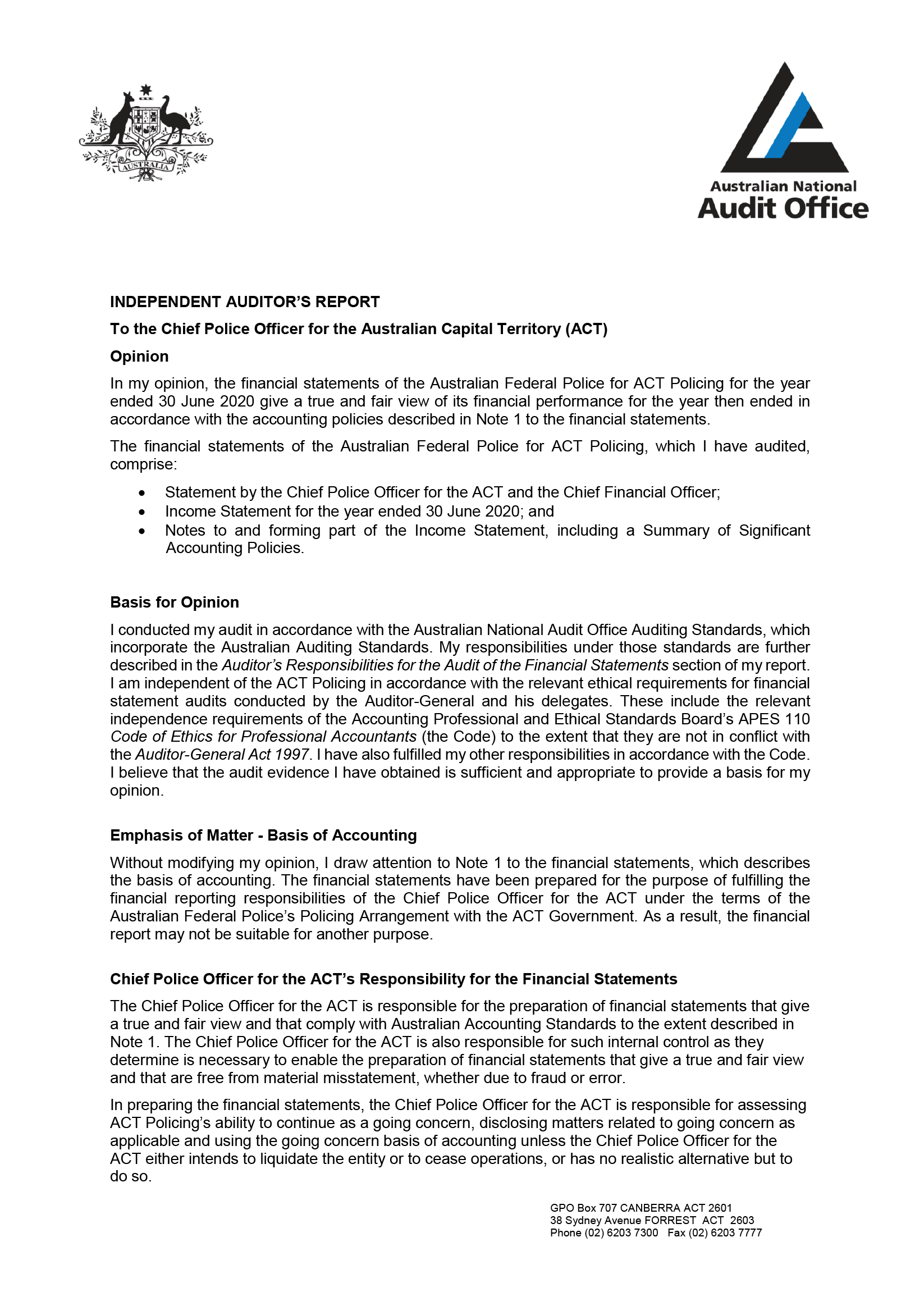
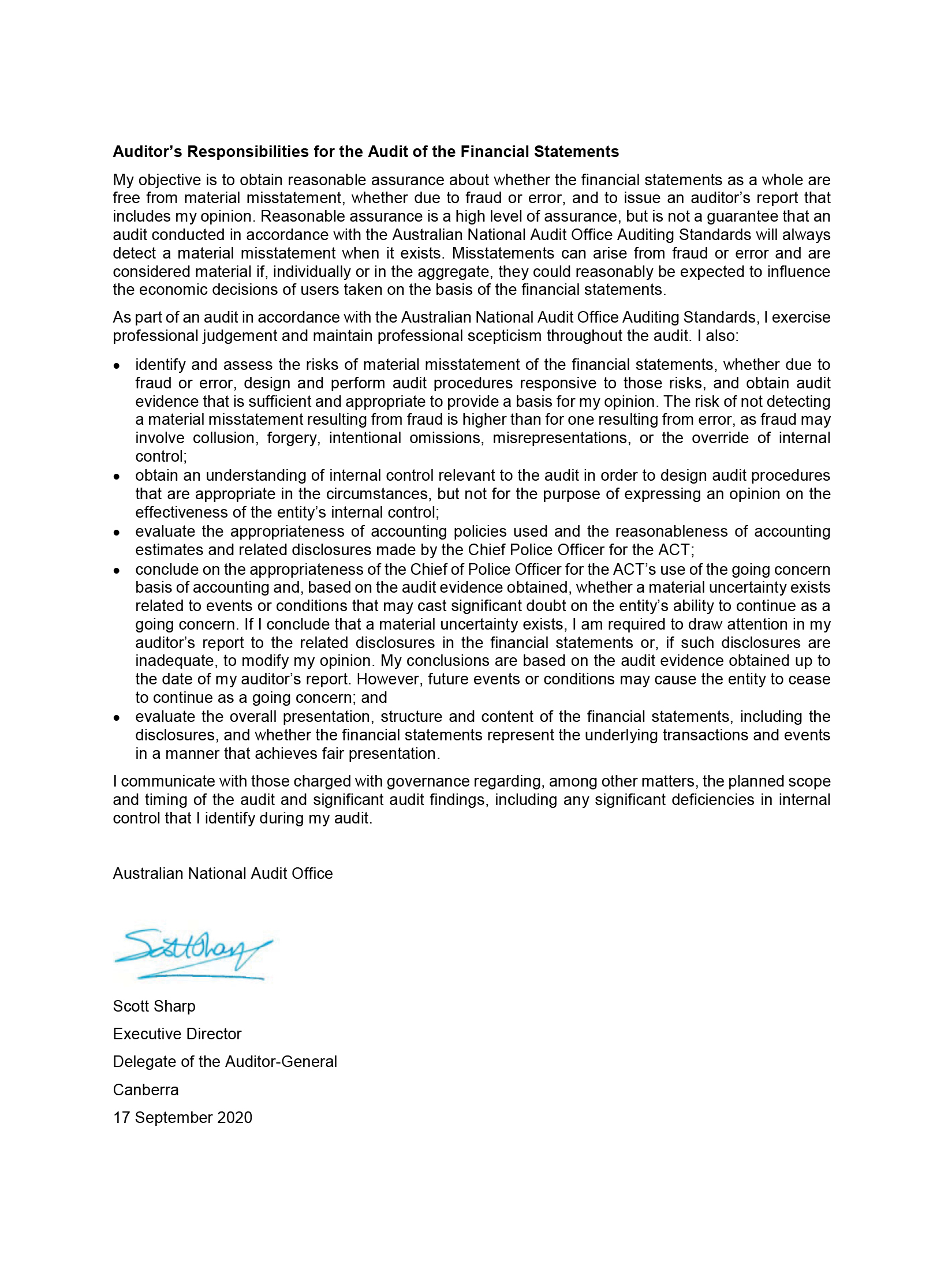





Appendix 2: Statement of Performance
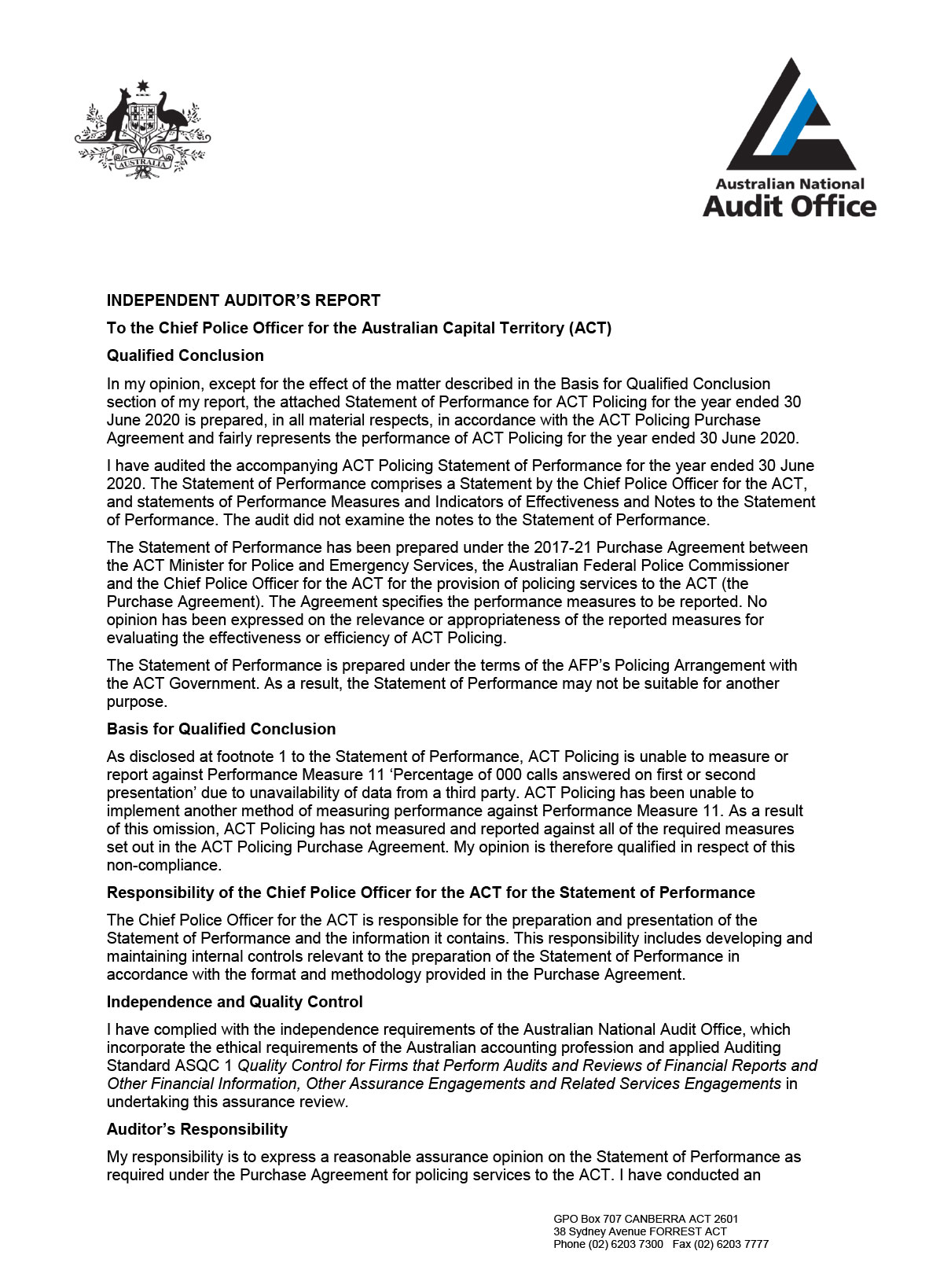
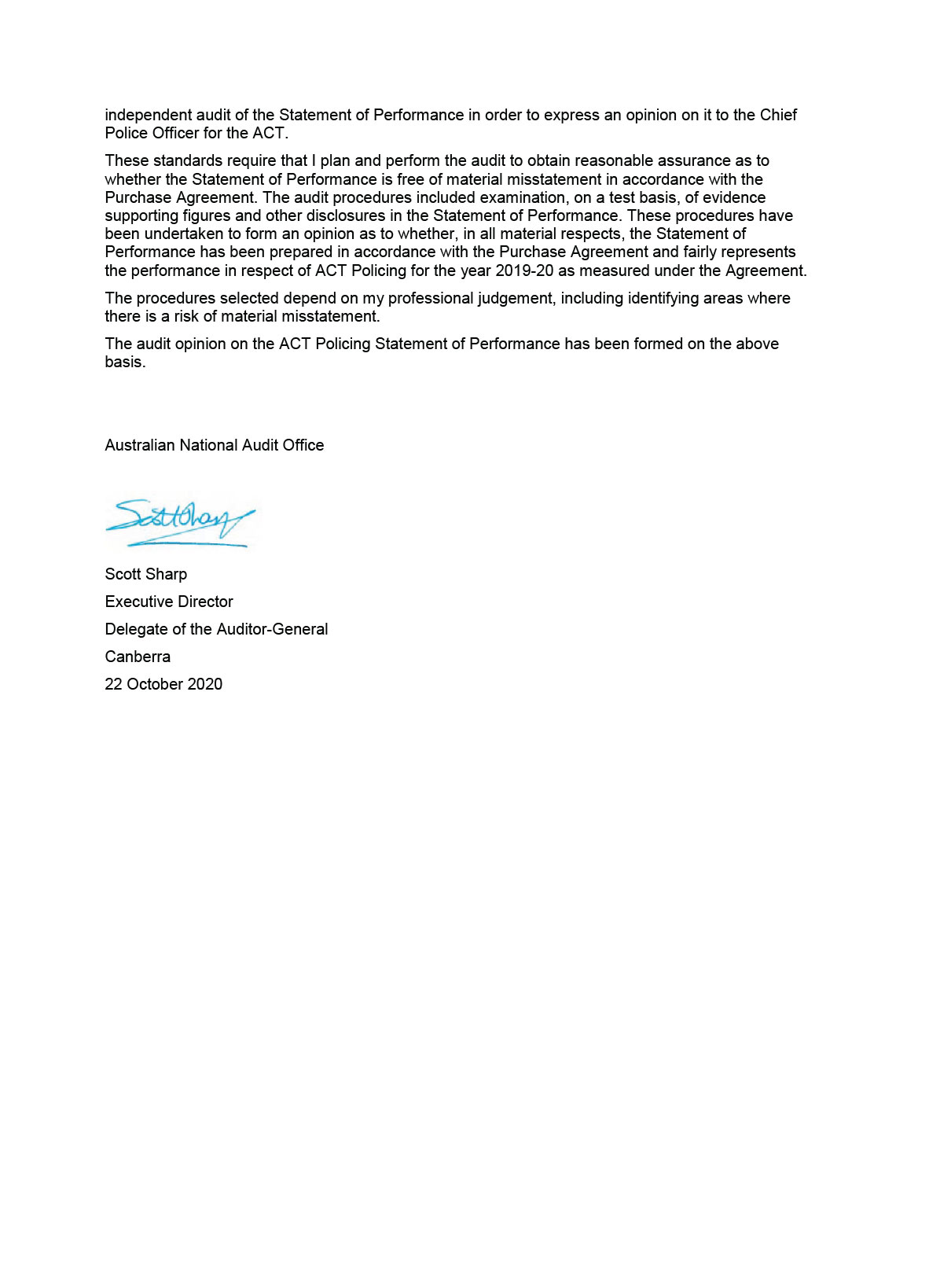
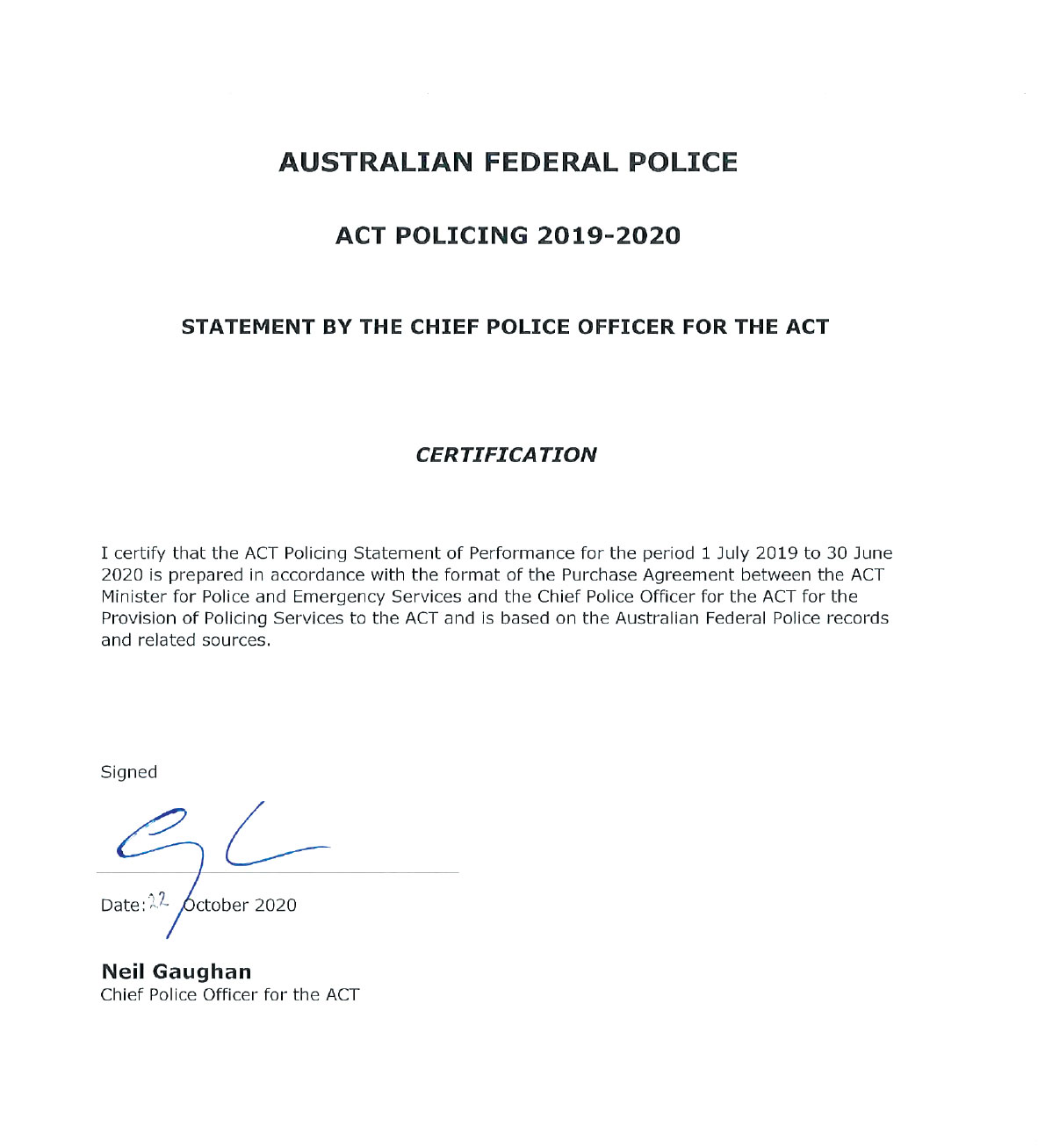
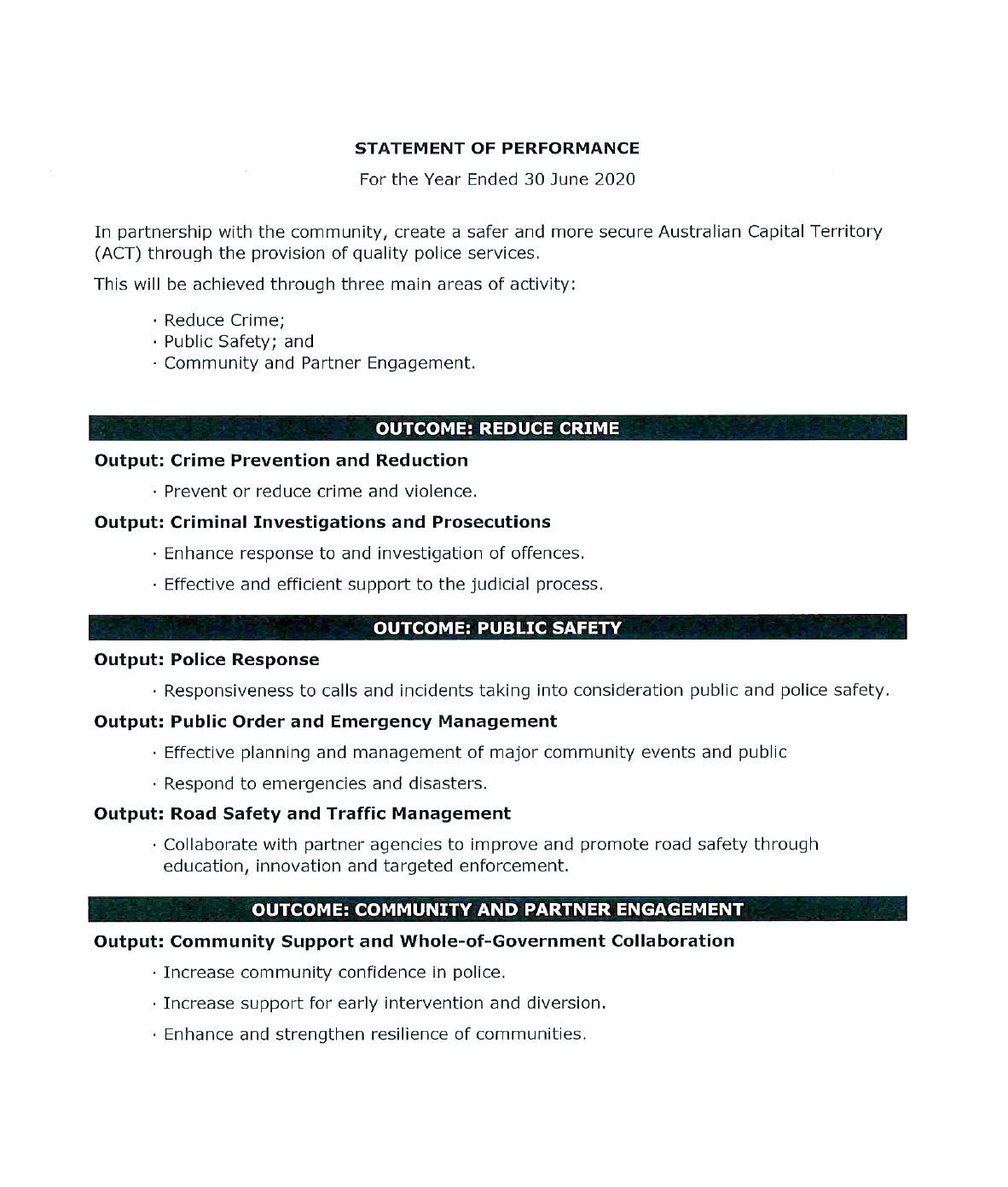
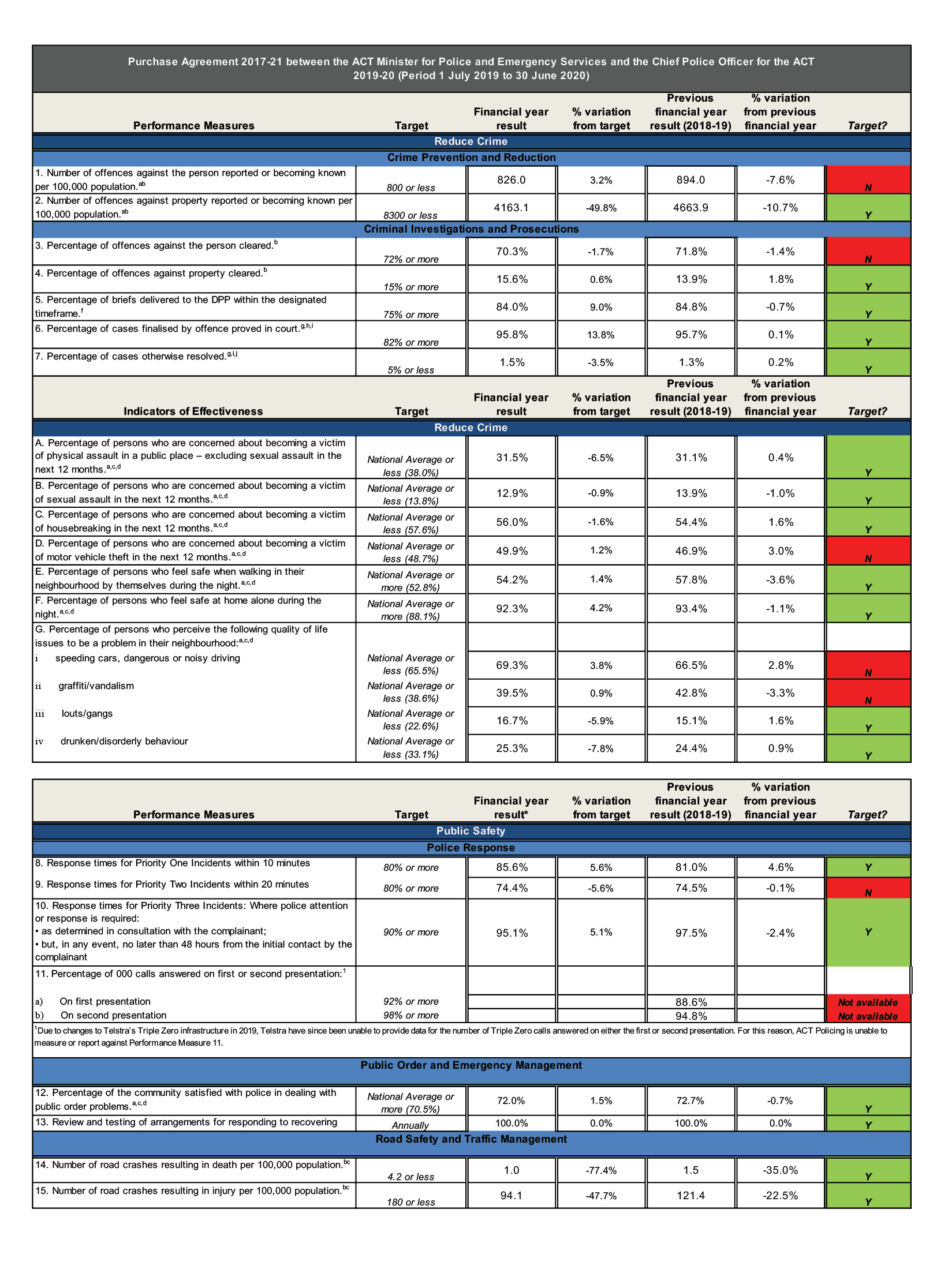
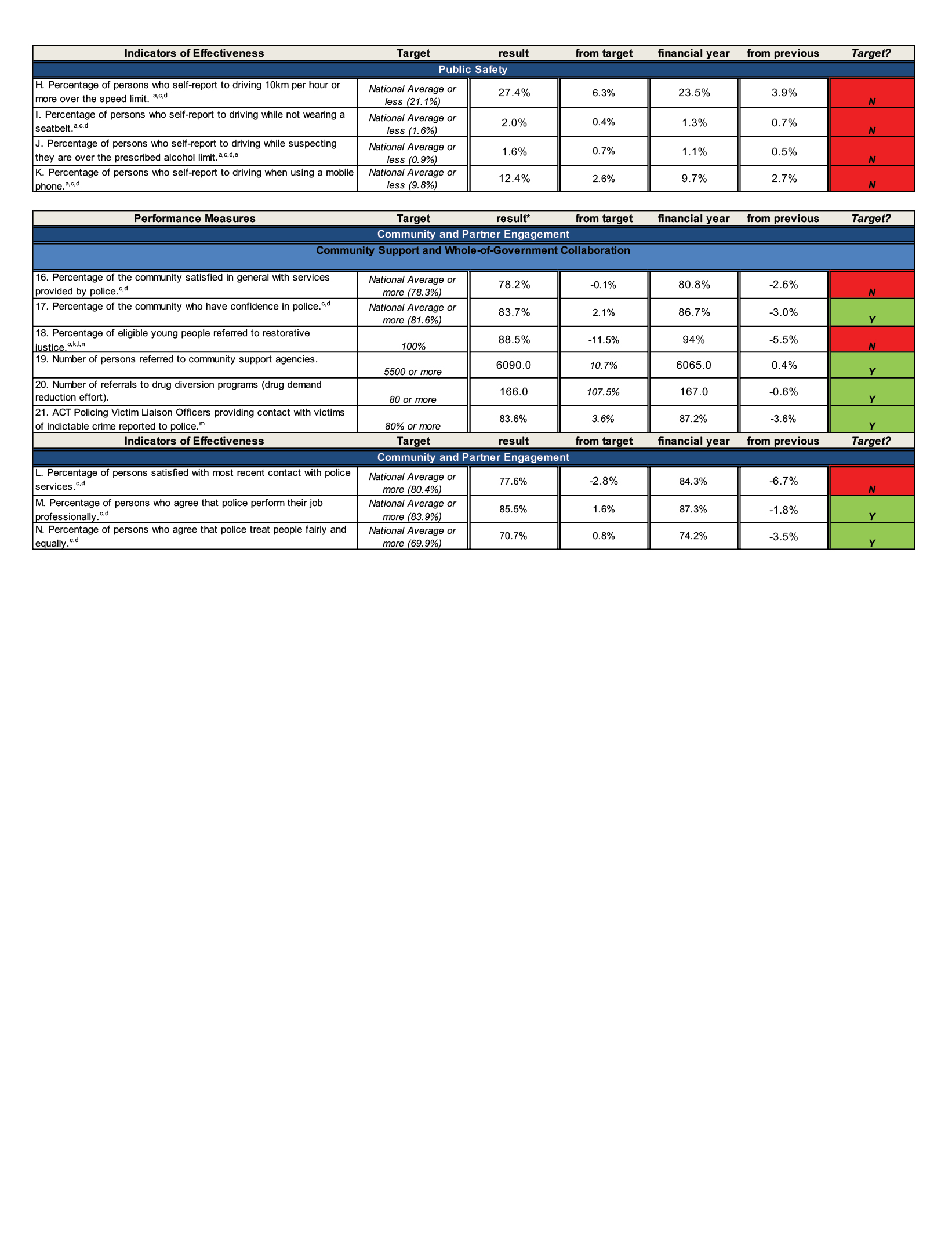
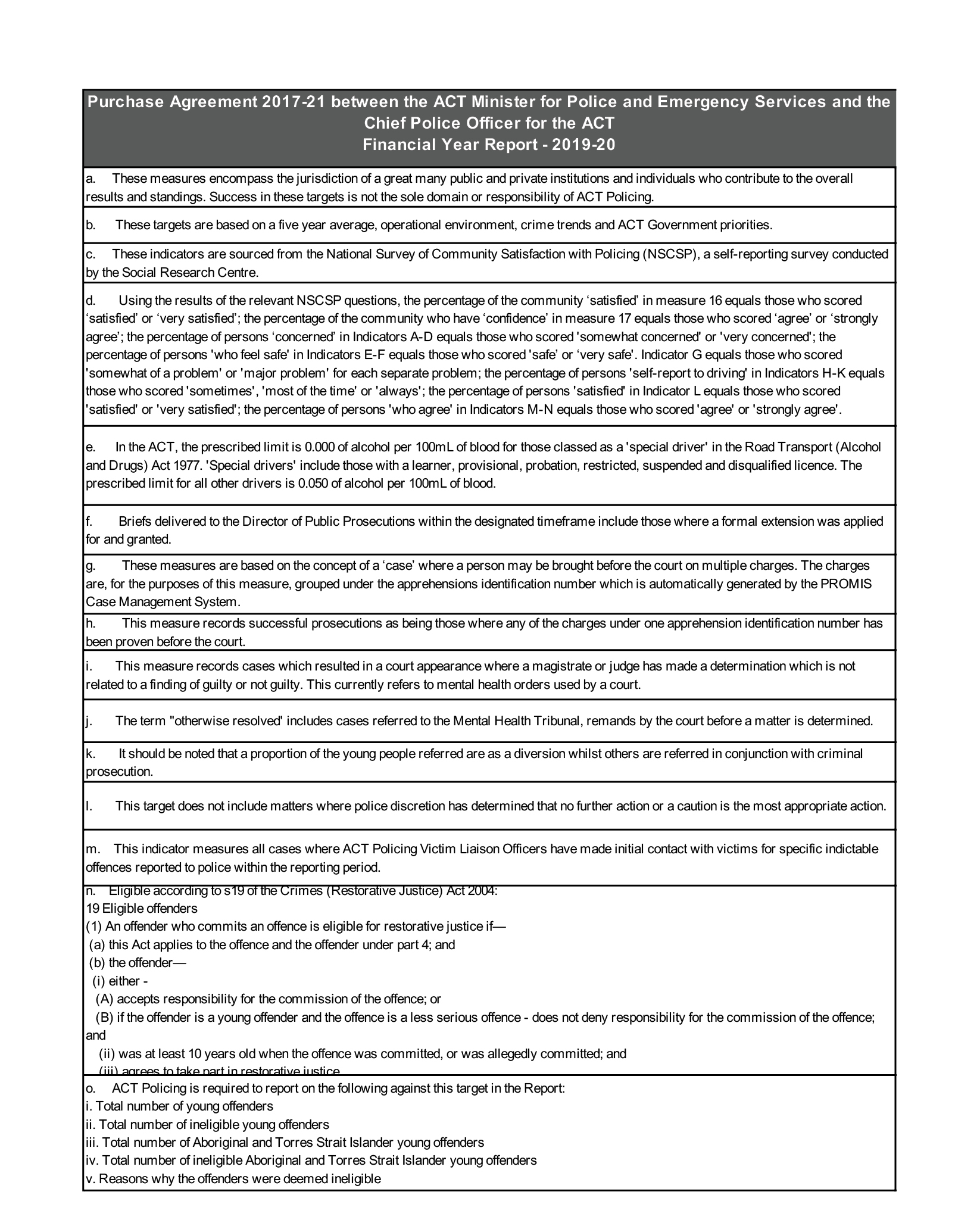
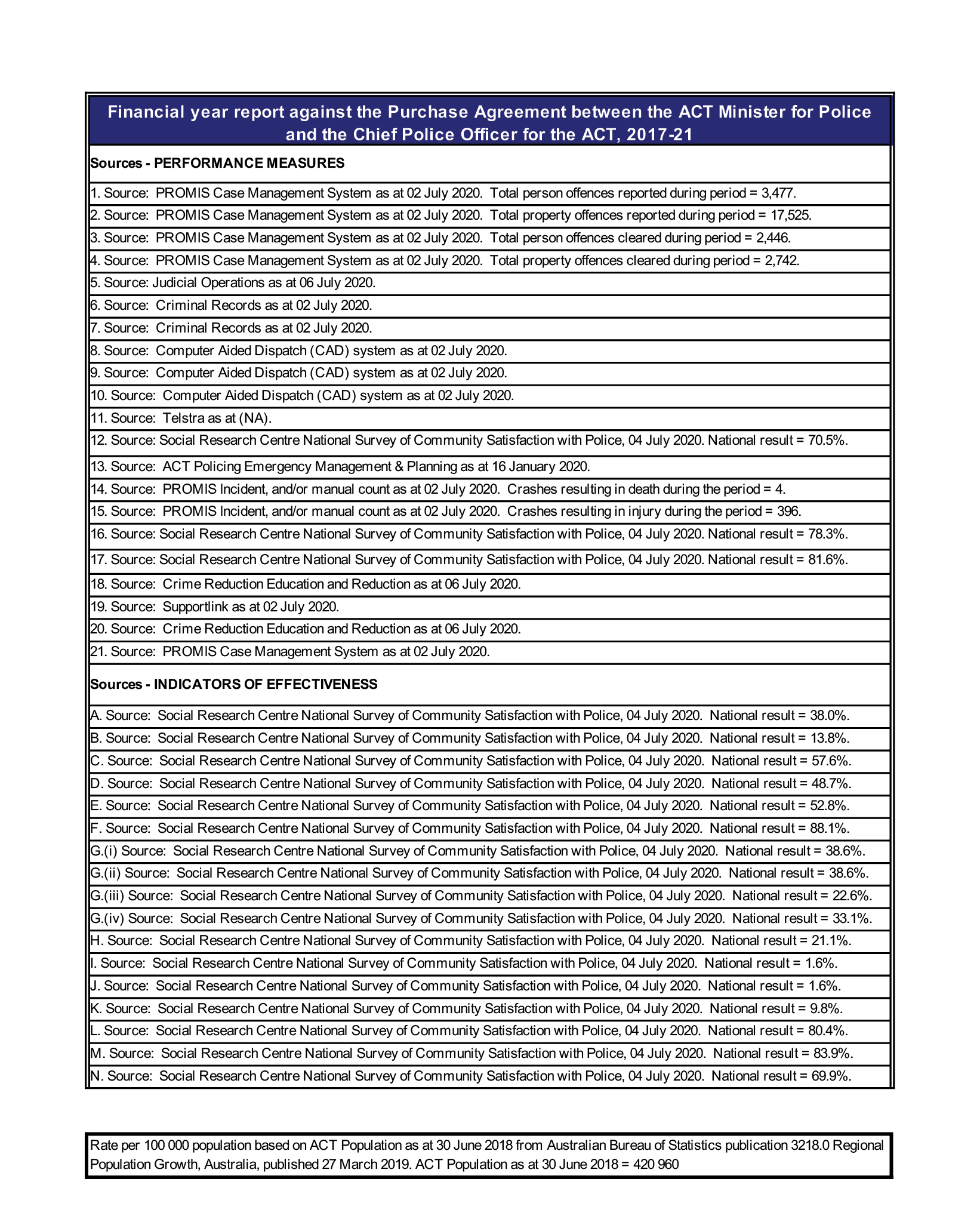
Appendix 3: Number of Offences Reported or Becoming Known in Australian Capital Territory 2015–16 to 2019–20
| Offence type | 2015–16 | 2016–17 | 2017–18 | 2018–19 | 2019–20 |
|---|---|---|---|---|---|
| OFFENCES AGAINST THE PERSON | |||||
| Homicide and Related offences | |||||
| Murder | 6 | 1 | 3 | 1 | 2 |
| Attempted murder | 2 | 1 | 6 | 5 | 2 |
| Manslaughter | - | - | - | 1 | 1 |
| Driving causing death | - | - | 2 | 1 | 1 |
| Homicide unspecified | - | - | - | - | - |
| Total Homicide and Related offences | 8 | 2 | 11 | 8 | 6 |
| Assaults (excluding sexual) | |||||
| Assault causing GBH | 67 | 81 | 93 | 118 | 73 |
| Assault causing ABH | 368 | 472 | 433 | 447 | 424 |
| Assault other | 2123 | 2511 | 2317 | 2372 | 2189 |
| Total Assaults (excluding sexual) | 2558 | 3064 | 2843 | 2937 | 2686 |
| Sexual Offences | |||||
| Sexual assault 1st 2nd 3rd degree | 21 | 15 | 9 | 22 | 15 |
| Sexual intercourse, no consent | 108 | 158 | 157 | 178 | 139 |
| Sexual intercourse, person < 16 yrs | 59 | 80 | 64 | 97 | 50 |
| Indecent act, assault | 53 | 65 | 52 | 55 | 50 |
| Indecent act, no consent | 100 | 114 | 107 | 140 | 112 |
| Indecent act, person < 16 yrs | 81 | 96 | 71 | 90 | 59 |
| Incest | 24 | 10 | 3 | 15 | 9 |
| Indecent exposure | 39 | 31 | 44 | 38 | 37 |
| Total Sexual Assault Offences | 485 | 569 | 507 | 635 | 471 |
| Continued | |||||
| Other Offences | |||||
| Kidnap/Abduction | 17 | 29 | 32 | 23 | 29 |
| Other offences against the person | 236 | 329 | 194 | 283 | 285 |
| Total Other Offences | 253 | 358 | 226 | 306 | 314 |
| Total Offences against the Person | 3304 | 3993 | 3587 | 3886 | 3477 |
| OFFENCES AGAINST PROPERTY | |||||
| Robbery | |||||
| Armed robbery | 78 | 136 | 123 | 104 | 103 |
| Other robbery | 78 | 113 | 106 | 105 | 120 |
| Total Robbery | 156 | 249 | 229 | 209 | 223 |
| Blackmail and extortion | |||||
| Blackmail and extortion | 6 | 18 | 15 | 15 | 6 |
| Total Blackmail and Extortion | 6 | 18 | 15 | 15 | 6 |
| Burglary | |||||
| Burglary dwellings | 1476 | 1649 | 1679 | 1659 | 1363 |
| Burglary shops | 432 | 335 | 287 | 419 | 370 |
| Burglary other | 724 | 581 | 590 | 549 | 559 |
| Total Burglary | 2632 | 2565 | 2556 | 2627 | 2292 |
| Fraud and Misappropriation | |||||
| Fraud | 1532 | 1408 | 1388 | 2015 | 1279 |
| Misappropriation | 1 | - | - | 1 | - |
| Counterfeiting | 38 | 32 | 60 | 40 | 18 |
| Total Fraud and Misappropriation | 1571 | 1440 | 1448 | 2056 | 1297 |
| Handling Stolen Goods | |||||
| Receiving | 13 | 7 | 9 | 4 | 8 |
| Unlawful possession | 148 | 106 | 171 | 104 | 136 |
| Other handling stolen goods | 9 | 11 | 9 | 11 | 11 |
| Total Handling of Stolen Goods | 170 | 124 | 189 | 119 | 155 |
| Continued | |||||
| Theft or Illegal use of a Vehicle | |||||
| Motor vehicle theft | 1034 | 1325 | 1493 | 1234 | 1262 |
| Total Theft or Illegal use of a Vehicle | 1034 | 1325 | 1493 | 1234 | 1262 |
| Other Theft | |||||
| Bicycle theft | 672 | 480 | 526 | 710 | 712 |
| Boat theft | 1 | 2 | - | 1 | 3 |
| Stock theft | 1 | - | 2 | - | 2 |
| Shop stealing | 1220 | 1336 | 1360 | 1218 | 1267 |
| Theft at burglary — dwellings | 776 | 1,002 | 984 | 936 | 678 |
| Theft at burglary — shops | 254 | 159 | 161 | 225 | 148 |
| Theft at burglary — other | 374 | 267 | 319 | 269 | 237 |
| Other theft | 7677 | 6386 | 6443 | 5373 | 5062 |
| Total Other Theft | 10,975 | 9632 | 9795 | 8732 | 8109 |
| Property Damage | |||||
| Arson | 178 | 212 | 230 | 231 | 203 |
| Damage at burglary — dwellings | 163 | 131 | 131 | 138 | 90 |
| Damage at burglary — shops | 38 | 37 | 36 | 60 | 39 |
| Damage at burglary — other | 108 | 58 | 69 | 60 | 67 |
| Other property damage | 4635 | 4935 | 4179 | 4465 | 3776 |
| Total Property Damage | 5122 | 5373 | 4645 | 4954 | 4175 |
| Environmental Offences | |||||
| Pollution | 3 | 10 | 6 | 4 | 2 |
| Flora and fauna | 1 | - | - | - | - |
| Other environmental offences | 7 | 4 | 7 | 4 | 4 |
| Total Environmental Offences | 11 | 14 | 13 | 8 | 6 |
| Total Offences against Property | 21,677 | 20,740 | 20,383 | 19,954 | 17,525 |
| Continued | |||||
| OFFENCES AGAINST GOOD ORDER | |||||
| Government security/operations | 62 | 103 | 67 | 60 | 77 |
| Justice procedures | 1407 | 1620 | 1884 | 1775 | 2063 |
| Firearms and weapons | 284 | 327 | 403 | 342 | 344 |
| Other offences against good order | 910 | 1010 | 899 | 972 | 833 |
| Total Offences against Good Order | 2663 | 3060 | 3253 | 3149 | 3317 |
| DRUG OFENCES | |||||
| Possess and use drugs | 542 | 639 | 792 | 541 | 537 |
| Deal and supply drugs | 90 | 72 | 106 | 73 | 55 |
| Manufacture and grow drugs | 21 | 18 | 16 | 21 | 13 |
| Other drug offences | 30 | 23 | 44 | 32 | 37 |
| Total Drug Offences | 683 | 752 | 958 | 667 | 642 |
| TRAFFIC OFFENCES | |||||
| Drink driving offences | 959 | 913 | 1026 | 1083 | 799 |
| Drug driving offences | 166 | 454 | 736 | 939 | 761 |
| Dangerous and reckless driving | 138 | 132 | 146 | 178 | 141 |
| Driving licence offences | 821 | 929 | 933 | 946 | 958 |
| Other motor vehicle, traffic and related offences | 3060 | 4079 | 3870 | 3546 | 3591 |
| Total Traffic Offences | 5144 | 6507 | 6711 | 6692 | 6250 |
| OTHER OFFENCES NOT ELSE WHERE CLASSIFIED | |||||
| Other offences n.e.c | 117 | 151 | 229 | 123 | 449 |
| All Offences | 33,588 | 35,203 | 35,121 | 34,471 | 31,660 |
Appendix 4: Offences Cleared by ACT Policing in the Australian Capital Territory 2015–16 to 2019–20
| Offence type | 2015–16 | 2016–17 | 2017–18 | 2018–19 | 2019–20 |
|---|---|---|---|---|---|
| OFFENCES AGAINST THE PERSON | |||||
| Homicide and Related offences | |||||
| Murder | 2 | - | 5 | 2 | 1 |
| Attempted murder | 1 | 2 | 4 | 5 | 2 |
| Manslaughter | - | - | - | 1 | 1 |
| Driving causing death | - | - | 2 | 1 | - |
| Homicide unspecified | - | - | - | - | - |
| Total Homicide and Related offences | 3 | 2 | 11 | 9 | 4 |
| Assaults (excluding sexual) | |||||
| Assault causing GBH | 52 | 63 | 70 | 96 | 59 |
| Assault causing ABH | 262 | 308 | 316 | 296 | 288 |
| Assault other | 1580 | 1913 | 1773 | 1669 | 1548 |
| Total Assaults (excluding sexual) | 1894 | 2284 | 2159 | 2061 | 1895 |
| Sexual Offences | |||||
| Sexual assault 1st 2nd 3rd degree | 13 | 11 | 10 | 14 | 10 |
| Sexual intercourse, no consent | 70 | 97 | 118 | 126 | 99 |
| Sexual intercourse, person < 16 yrs | 43 | 70 | 72 | 59 | 50 |
| Indecent act, assault | 32 | 32 | 45 | 27 | 28 |
| Indecent act, no consent | 70 | 68 | 82 | 84 | 81 |
| Indecent act, person < 16 yrs | 116 | 80 | 64 | 74 | 45 |
| Incest | 27 | 5 | 7 | 10 | 7 |
| Indecent exposure | 9 | 5 | 23 | 20 | 18 |
| Total Sexual Assault Offences | 380 | 368 | 421 | 414 | 338 |
| Continued | |||||
| Other Offences | |||||
| Kidnap/Abduction | 12 | 29 | 26 | 17 | 26 |
| Other offences against the person | 123 | 196 | 131 | 173 | 183 |
| Total Other Offences | 135 | 225 | 157 | 190 | 209 |
| Total Offences against the Person | 2412 | 2879 | 2748 | 2674 | 2446 |
| OFFENCES AGAINST PROPERTY | |||||
| Robbery | |||||
| Armed robbery | 27 | 34 | 51 | 57 | 36 |
| Other robbery | 34 | 40 | 41 | 36 | 48 |
| Total Robbery | 61 | 74 | 92 | 93 | 84 |
| Blackmail and extortion | |||||
| Blackmail and extortion | 3 | 11 | 2 | 1 | 6 |
| Total Blackmail and Extortion | 3 | 11 | 2 | 1 | 6 |
| Burglary | |||||
| Burglary dwellings | 130 | 127 | 182 | 157 | 144 |
| Burglary shops | 36 | 29 | 31 | 44 | 19 |
| Burglary other | 59 | 32 | 64 | 61 | 53 |
| Total Burglary | 225 | 188 | 277 | 262 | 216 |
| Fraud and Misappropriation | |||||
| Fraud | 951 | 504 | 691 | 438 | 606 |
| Misappropriation | - | - | - | 1 | - |
| Counterfeiting | 1 | 1 | 26 | 1 | 4 |
| Total Fraud and Misappropriation | 952 | 505 | 717 | 440 | 610 |
| Handling Stolen Goods | |||||
| Receiving | 7 | 4 | 15 | 2 | 8 |
| Unlawful possession | 91 | 84 | 155 | 81 | 123 |
| Other handling stolen goods | 7 | 8 | 5 | 12 | 9 |
| Total Handling of Stolen Goods | 105 | 96 | 175 | 95 | 140 |
| Continued | |||||
| Theft or Illegal use of a Vehicle | |||||
| Motor vehicle theft | 127 | 150 | 202 | 159 | 163 |
| Total Theft or Illegal use of a Vehicle | 127 | 150 | 202 | 159 | 163 |
| Other Theft | |||||
| Bicycle theft | 9 | 15 | 13 | 15 | 9 |
| Boat theft | 1 | - | - | - | - |
| Stock theft | - | - | - | - | - |
| Shop stealing | 431 | 465 | 493 | 338 | 324 |
| Theft at burglary — dwellings | 65 | 56 | 100 | 59 | 66 |
| Theft at burglary — shops | 20 | 16 | 14 | 24 | 7 |
| Theft at burglary — other | 35 | 8 | 9 | 12 | 19 |
| Other theft | 962 | 567 | 528 | 463 | 355 |
| Total Other Theft | 1523 | 1127 | 1157 | 911 | 780 |
| Property Damage | |||||
| Arson | 28 | 13 | 19 | 12 | 18 |
| Damage at burglary — dwellings | 25 | 25 | 19 | 34 | 8 |
| Damage at burglary — shops | 4 | 2 | 6 | 5 | - |
| Damage at burglary — other | 26 | 5 | 4 | 7 | 12 |
| Other property damage | 628 | 786 | 733 | 684 | 703 |
| Total Property Damage | 711 | 831 | 781 | 742 | 741 |
| Environmental Offences | |||||
| Pollution | 2 | 7 | 5 | 2 | 1 |
| Flora and fauna | - | - | - | - | - |
| Other environmental offences | 7 | 2 | 5 | 2 | 1 |
| Total Environmental Offences | 9 | 9 | 10 | 4 | 2 |
| Total Offences against Property | 3716 | 2991 | 3413 | 2707 | 2742 |
| Continued | |||||
| OFFENCES AGAINST GOOD ORDER | |||||
| Government security/operations | 53 | 100 | 65 | 62 | 76 |
| Justice procedures | 1166 | 1412 | 1646 | 1484 | 1753 |
| Firearms and weapons | 231 | 280 | 282 | 285 | 268 |
| Other offences against good order | 615 | 675 | 629 | 668 | 545 |
| Total Offences against Good Order | 2065 | 2467 | 2622 | 2499 | 2642 |
| DRUG OFENCES | |||||
| Possess and use drugs | 431 | 522 | 639 | 437 | 407 |
| Deal and supply drugs | 55 | 58 | 85 | 89 | 38 |
| Manufacture and grow drugs | 14 | 15 | 10 | 13 | 7 |
| Other drug offences | 11 | 6 | 11 | 9 | 7 |
| Total Drug Offences | 511 | 601 | 745 | 548 | 459 |
| TRAFFIC OFFENCES | |||||
| Drink driving offences | 895 | 808 | 979 | 1,027 | 757 |
| Drug driving offences | 170 | 436 | 695 | 938 | 785 |
| Dangerous and reckless driving | 116 | 97 | 99 | 129 | 103 |
| Driving licence offences | 763 | 831 | 881 | 854 | 908 |
| Other motor vehicle, traffic and related offences | 2290 | 2555 | 2364 | 1960 | 2094 |
| Total Traffic Offences | 4234 | 4727 | 5018 | 4908 | 4647 |
| OTHER OFFENCES NOT ELSE WHERE CLASSIFIED | |||||
| Other offences n.e.c | 52 | 50 | 79 | 58 | 104 |
| All Offences | 12,990 | 13,715 | 14,625 | 13,394 | 13,040 |
Appendix 5: Percentage of Offences Cleared by ACT Policing 2015–16 to 2019–20
| Offence type | 2015–16 | 2016–17 | 2017–18 | 2018–19 | 2019–20 |
|---|---|---|---|---|---|
| OFFENCES AGAINST THE PERSON | |||||
| Homicide and Related offences | |||||
| Murder | 33.3% | 0.0% | 166.7% | 200.0% | 50.0% |
| Attempted murder | 50.0% | 200.0% | 66.7% | 100.0% | 100.0% |
| Manslaughter | 0.0% | 0.0% | 0.0% | 100.0% | 100.0% |
| Driving causing death | 0.0% | 0.0% | 100.0% | 100.0% | 0.0% |
| Homicide unspecified | 0.0% | 0.0% | 0.0% | 0.0% | 0.0% |
| Total Homicide and Related offences | 37.5% | 100.0% | 100.0% | 112.5% | 66.7% |
| Assaults (excluding sexual) | |||||
| Assault causing GBH | 77.6% | 77.8% | 75.3% | 81.4% | 80.8% |
| Assault causing ABH | 71.2% | 65.3% | 73.0% | 66.2% | 67.9% |
| Assault other | 74.4% | 76.2% | 76.5% | 70.4% | 70.7% |
| Total Assaults (excluding sexual) | 74.0% | 74.5% | 75.9% | 70.2% | 70.6% |
| Sexual Offences | |||||
| Sexual assault 1st 2nd 3rd degree | 61.9% | 73.3% | 111.1% | 63.6% | 66.7% |
| Sexual intercourse, no consent | 64.8% | 61.4% | 75.2% | 70.8% | 71.2% |
| Sexual intercourse, person < 16 yrs | 72.9% | 87.5% | 112.5% | 60.8% | 100.0% |
| Indecent act, assault | 60.4% | 49.2% | 86.5% | 49.1% | 56.0% |
| Indecent act, no consent | 70.0% | 59.6% | 76.6% | 60.0% | 72.3% |
| Indecent act, person < 16 yrs | 143.2% | 83.3% | 90.1% | 82.2% | 76.3% |
| Incest | 112.5% | 50.0% | 233.3% | 66.7% | 77.8% |
| Indecent exposure | 23.1% | 16.1% | 52.3% | 52.6% | 48.6% |
| Total Sexual Assault Offences | 78.4% | 64.7% | 83.0% | 65.2% | 71.8% |
| Continued | |||||
| Other Offences | |||||
| Kidnap/Abduction | 70.6% | 100.0% | 81.3% | 73.9% | 89.7% |
| Other offences against the person | 52.1% | 59.6% | 67.5% | 61.1% | 64.2% |
| Total Other Offences | 53.4% | 62.8% | 69.5% | 62.1% | 66.6% |
| Total Offences against the Person | 73.0% | 72.1% | 76.6% | 68.8% | 70.3% |
| OFFENCES AGAINST PROPERTY | |||||
| Robbery | |||||
| Armed robbery | 34.6% | 25.0% | 41.5% | 54.8% | 35.0% |
| Other robbery | 43.6% | 35.4% | 38.7% | 34.3% | 40.0% |
| Total Robbery | 39.1% | 29.7% | 40.2% | 44.5% | 37.7% |
| Blackmail and extortion | |||||
| Blackmail and extortion | 50.0% | 61.1% | 13.3% | 6.7% | 100.0% |
| Total Blackmail and Extortion | 50.0% | 61.1% | 13.3% | 6.7% | 100.0% |
| Burglary | |||||
| Burglary dwellings | 8.8% | 7.7% | 10.8% | 9.5% | 10.6% |
| Burglary shops | 8.3% | 8.7% | 10.8% | 10.5% | 5.1% |
| Burglary other | 8.1% | 5.5% | 10.8% | 11.1% | 9.5% |
| Total Burglary | 8.5% | 7.3% | 10.8% | 10.0% | 9.4% |
| Fraud and Misappropriation | |||||
| Fraud | 62.1% | 35.8% | 49.8% | 21.7% | 47.4% |
| Misappropriation | 0.0% | 0.0% | 0.0% | 100.0% | 0.0% |
| Counterfeiting | 2.6% | 3.1% | 43.3% | 2.5% | 22.2% |
| Total Fraud and Misappropriation | 60.6% | 35.1% | 49.5% | 21.4% | 47.0% |
| Handling Stolen Goods | |||||
| Receiving | 53.8% | 57.1% | 166.7% | 50.0% | 100.0% |
| Unlawful possession | 61.5% | 79.2% | 90.6% | 77.9% | 90.4% |
| Other handling stolen goods | 77.8% | 72.7% | 55.6% | 109.1% | 81.8% |
| Total Handling of Stolen Goods | 61.8% | 77.4% | 92.6% | 79.8% | 90.3% |
| Continued | |||||
| Theft or Illegal use of a Vehicle | |||||
| Motor vehicle theft | 12.3% | 11.3% | 13.5% | 12.9% | 12.9% |
| Total Theft or Illegal use of a Vehicle | 12.3% | 11.3% | 13.5% | 12.9% | 12.9% |
| Other Theft | |||||
| Bicycle theft | 1.3% | 3.1% | 2.5% | 2.1% | 1.3% |
| Boat theft | 100.0% | 0.0% | 0.0% | 0.0% | 0.0% |
| Stock theft | 0.0% | 0.0% | 0.0% | 0.0% | 0.0% |
| Shop stealing | 35.3% | 34.8% | 36.3% | 27.8% | 25.6% |
| Theft at burglary — dwellings | 8.4% | 5.6% | 10.2% | 6.3% | 9.7% |
| Theft at burglary — shops | 7.9% | 10.1% | 8.7% | 10.7% | 4.7% |
| Theft at burglary — other | 9.4% | 3.0% | 2.8% | 4.5% | 8.0% |
| Other theft | 12.5% | 8.9% | 8.2% | 8.6% | 7.0% |
| Total Other Theft | 13.9% | 11.7% | 11.8% | 10.4% | 9.6% |
| Property Damage | |||||
| Arson | 15.7% | 6.1% | 8.3% | 5.2% | 8.9% |
| Damage at burglary — dwellings | 15.3% | 19.1% | 14.5% | 24.6% | 8.9% |
| Damage at burglary — shops | 10.5% | 5.4% | 16.7% | 8.3% | 0.0% |
| Damage at burglary — other | 24.1% | 8.6% | 5.8% | 11.7% | 17.9% |
| Other property damage | 13.5% | 15.9% | 17.5% | 15.3% | 18.6% |
| Total Property Damage | 13.9% | 15.5% | 16.8% | 15.0% | 17.7% |
| Environmental Offences | |||||
| Pollution | 66.7% | 70.0% | 83.3% | 50.0% | 50.0% |
| Flora and fauna | 0.0% | 0.0% | 0.0% | 0.0% | 0.0% |
| Other environmental offences | 100.0% | 50.0% | 71.4% | 50.0% | 25.0% |
| Total Environmental Offences | 81.8% | 64.3% | 76.9% | 50.0% | 33.3% |
| Total Offences against Property | 17.1% | 14.4% | 16.7% | 13.6% | 15.6% |
| Continued | |||||
| OFFENCES AGAINST GOOD ORDER | |||||
| Government security/operations | 85.5% | 97.1% | 97.0% | 103.3% | 98.7% |
| Justice procedures | 82.9% | 87.2% | 87.4% | 83.6% | 85.0% |
| Firearms and weapons | 81.3% | 85.6% | 70.0% | 83.3% | 77.9% |
| Other offences against good order | 67.6% | 66.8% | 70.0% | 68.7% | 65.4% |
| Total Offences against Good Order | 77.5% | 80.6% | 80.6% | 79.4% | 79.7% |
| DRUG OFENCES | |||||
| Possess and use drugs | 79.5% | 81.7% | 80.7% | 80.8% | 75.8% |
| Deal and supply drugs | 61.1% | 80.6% | 80.2% | 121.9% | 69.1% |
| Manufacture and grow drugs | 66.7% | 83.3% | 62.5% | 61.9% | 53.8% |
| Other drug offences | 36.7% | 26.1% | 25.0% | 28.1% | 18.9% |
| Total Drug Offences | 74.8% | 79.9% | 77.8% | 82.2% | 71.5% |
| TRAFFIC OFFENCES | |||||
| Drink driving offences | 93.3% | 88.5% | 95.4% | 94.8% | 94.7% |
| Drug driving offences | 102.4% | 96.0% | 94.4% | 99.9% | 103.2% |
| Dangerous and reckless driving | 84.1% | 73.5% | 67.8% | 72.5% | 73.0% |
| Driving licence offences | 92.9% | 89.5% | 94.4% | 90.3% | 94.8% |
| Other motor vehicle, traffic and related offences | 74.8% | 62.6% | 61.1% | 55.3% | 58.3% |
| Total Traffic Offences | 82.3% | 72.6% | 74.8% | 73.3% | 74.4% |
| OTHER OFFENCES NOT ELSE WHERE CLASSIFIED | |||||
| Other offences n.e.c | 44.4% | 33.1% | 34.5% | 47.2% | 23.2% |
| All Offences | 38.7% | 39.0% | 41.6% | 38.9% | 41.2% |
Appendix 6: Proceedings Against Offenders by ACT Policing (Charges) 2015–16 to 2019–20
| Offence type | 2015–16 | 2016–17 | 2017–18 | 2018–19 | 2019–20 |
|---|---|---|---|---|---|
| OFFENCES AGAINST THE PERSON | |||||
| Homicide and Related offences | |||||
| Murder | 3 | 2 | 7 | 5 | 1 |
| Attempted murder | 1 | 2 | 4 | 10 | - |
| Manslaughter | - | - | - | 1 | - |
| Driving causing death | 1 | 1 | 3 | 1 | - |
| Homicide unspecified | - | - | - | - | - |
| Total Homicide and Related offences | 5 | 5 | 14 | 17 | 1 |
| Assaults (excluding sexual) | |||||
| Assault causing GBH | 100 | 102 | 128 | 168 | 136 |
| Assault causing ABH | 284 | 303 | 316 | 323 | 308 |
| Assault other | 934 | 1044 | 974 | 949 | 965 |
| Total Assaults (excluding sexual) | 1318 | 1449 | 1418 | 1440 | 1409 |
| Sexual Offences | |||||
| Sexual assault 1st 2nd 3rd degree | 13 | 25 | 7 | 20 | 23 |
| Sexual intercourse, no consent | 46 | 32 | 27 | 23 | 16 |
| Sexual intercourse, person < 16 yrs | 55 | 37 | 21 | 39 | 37 |
| Indecent act, assault | 3 | 2 | 2 | - | 2 |
| Indecent act, no consent | 100 | 61 | 79 | 49 | 27 |
| Indecent act, person < 16 yrs | 95 | 74 | 53 | 48 | 25 |
| Incest | 25 | 13 | 1 | 14 | - |
| Indecent exposure | 8 | 5 | 6 | 11 | 18 |
| Total Sexual Assault Offences | 345 | 249 | 196 | 204 | 148 |
| Continued | |||||
| Other Offences | |||||
| Kidnap/Abduction | 23 | 46 | 33 | 30 | 26 |
| Other offences against the person | 192 | 240 | 202 | 222 | 236 |
| Total Other Offences | 215 | 286 | 235 | 252 | 262 |
| Total Offences against the Person | 1883 | 1989 | 1863 | 1913 | 1820 |
| OFFENCES AGAINST PROPERTY | |||||
| Robbery | |||||
| Armed robbery | 48 | 54 | 55 | 98 | 54 |
| Other robbery | 28 | 90 | 86 | 59 | 74 |
| Total Robbery | 76 | 144 | 141 | 157 | 128 |
| Blackmail and extortion | |||||
| Blackmail and extortion | 3 | 18 | 5 | 8 | 2 |
| Total Blackmail and Extortion | 3 | 18 | 5 | 8 | 2 |
| Burglary | |||||
| Burglary dwellings | 163 | 129 | 194 | 195 | 151 |
| Burglary shops | 61 | 39 | 46 | 51 | 57 |
| Burglary other | 88 | 59 | 108 | 119 | 116 |
| Total Burglary | 312 | 227 | 348 | 365 | 324 |
| Fraud and Misappropriation | |||||
| Fraud | 655 | 837 | 703 | 347 | 881 |
| Misappropriation | - | - | - | - | - |
| Counterfeiting | - | 2 | - | 1 | 6 |
| Total Fraud and Misappropriation | 655 | 839 | 703 | 348 | 887 |
| Handling Stolen Goods | |||||
| Receiving | 42 | 25 | 35 | 14 | 27 |
| Unlawful possession | 247 | 263 | 294 | 182 | 245 |
| Other handling stolen goods | - | 4 | 11 | 4 | 1 |
| Total Handling of Stolen Goods | 289 | 292 | 340 | 200 | 273 |
| Continued | |||||
| Theft or Illegal use of a Vehicle | |||||
| Motor vehicle theft | 162 | 215 | 299 | 321 | 279 |
| Total Theft or Illegal use of a Vehicle | 162 | 215 | 299 | 321 | 279 |
| Other Theft | |||||
| Bicycle theft | 29 | 12 | 10 | 15 | 16 |
| Boat theft | - | - | - | - | - |
| Stock theft | 2 | - | - | - | - |
| Shop stealing | 341 | 285 | 241 | 267 | 251 |
| Theft at burglary — dwellings | 141 | 63 | 87 | 76 | 117 |
| Theft at burglary — shops | 26 | 16 | 13 | 27 | 23 |
| Theft at burglary — other | 28 | 8 | 23 | 36 | 57 |
| Other theft | 411 | 462 | 299 | 245 | 322 |
| Total Other Theft | 978 | 846 | 673 | 666 | 786 |
| Property Damage | |||||
| Arson | 29 | 10 | 23 | 25 | 23 |
| Damage at burglary — dwellings | 108 | 34 | 37 | 55 | 60 |
| Damage at burglary — shops | 9 | 7 | 6 | 16 | 22 |
| Damage at burglary — other | 15 | 20 | 18 | 43 | 30 |
| Other property damage | 491 | 536 | 538 | 561 | 500 |
| Total Property Damage | 652 | 607 | 622 | 700 | 635 |
| Environmental Offences | |||||
| Pollution | - | 4 | 4 | - | - |
| Flora and fauna | - | - | 1 | - | 3 |
| Other environmental offences | 2 | 1 | 1 | 2 | 2 |
| Total Environmental Offences | 2 | 5 | 6 | 2 | 5 |
| Total Offences against Property | 3129 | 3193 | 3137 | 2767 | 3319 |
| Continued | |||||
| OFFENCES AGAINST GOOD ORDER | |||||
| Government security/operations | 158 | 216 | 184 | 114 | 257 |
| Justice procedures | 1919 | 2142 | 2454 | 2402 | 2769 |
| Firearms and weapons | 335 | 392 | 421 | 488 | 433 |
| Other offences against good order | 504 | 568 | 576 | 596 | 622 |
| Total Offences against Good Order | 2916 | 3318 | 3635 | 3600 | 4081 |
| DRUG OFENCES | |||||
| Possess and use drugs | 548 | 650 | 729 | 532 | 483 |
| Deal and supply drugs | 84 | 137 | 250 | 168 | 81 |
| Manufacture and grow drugs | 34 | 31 | 22 | 32 | 10 |
| Other drug offences | - | 1 | 1 | 1 | - |
| Total Drug Offences | 666 | 819 | 1002 | 733 | 574 |
| TRAFFIC OFFENCES | |||||
| Drink driving offences | 1030 | 922 | 1060 | 1157 | 868 |
| Drug driving offences | 347 | 637 | 816 | 1022 | 844 |
| Dangerous and reckless driving | 180 | 120 | 162 | 159 | 168 |
| Driving licence offences | 1016 | 1247 | 1258 | 1222 | 1206 |
| Other motor vehicle, traffic and related offences | 1289 | 1505 | 1429 | 1334 | 1342 |
| Total Traffic Offences | 3862 | 4431 | 4725 | 4894 | 4428 |
| OTHER OFFENCES NOT ELSE WHERE CLASSIFIED | |||||
| Other offences n.e.c | 52 | 74 | 255 | 98 | 113 |
| All Offences | 12,508 | 13,824 | 14,617 | 14,005 | 14,335 |
Footnotes
- Multiple breaches can result from one complaint.
- Part V of the Australian Federal Police Act 1979 defines the categories of conduct. Category 1 is the least serious category and predominantly relates to customer service breaches. Category 2 is minor misconduct and Category 3 is serious misconduct. Corruption issues are referred to the Australian Commission for Law Enforcement Integrity (ACLEI).
- This table only includes matters where the case was finalised. This table includes matters reported before 1 July 2019.
- Reported FTE figures are higher than the reported headcount due to the inclusion of these enabling FTE.
- Headcount is the number of ACT Policing members as at 30 June 2020. FTE figures are reported as an average over the full financial year and exclude members who are classified ‘inoperative unpaid’ (members who are on leave and not being paid by ACT Policing). The reporting of average FTE provides the most accurate reporting of resourcing across the year.
- Prior to 2018–19, ACT Policing reported FTE as an actual figure as at 30 June.
- AFP Enabling capability less Commonwealth funded FTE. This nominal FTE is comprised of a mix of sworn and professional roles.
- This figure represents ACT Government funded positions which includes capability provided by the AFP.
- This table details substantive positions only.
- Inspector or Officer in Charge level.
- Superintendent or Coordinator level.
- Chief Police Officer, Deputy Chief Police Officers and Director of Corporate Services.
- A contract of employment that is made for a specific period of time
- Where an employee is engaged on a casual basis to do work that is intermittent or irregular in nature
- Note: This data has been captured using an optional self-reporting mechanism. As a result, the data may not accurately reflect the actual numbers of Aboriginal and/or Torres Strait Islander members, Culturally and Linguistically Diverse members, and people with disability within the organisation
- A culturally and linguistically diverse person is a person who was born overseas, has at least one parent born overseas or speaks a language other than English at home






